B plus B SmartWorx THINQ1 ThinQ SDS User Manual
B&B; Electronics ThinQ SDS Users Manual
Revised Users Manual
Copyright Copyright © 2005 Quatech, Inc. All rights are reserved. The information
contained in this document cannot be reproduced in any form without the
written consent of Quatech, Inc. Any software programs that might
accompany this document can be used only in accordance with any license
agreement(s) between the purchaser and Quatech, Inc. Quatech, Inc.
reserves the right to change this documentation or the product to which it
refers at any time and without notice.
Trademarks QUATECH® is a registered trademark of Quatech, Inc. Other product
and brand names listed in this manual may be trademarks of their
respective owners.
Disclaimer The information in this manual is believed to be accurate and reliable at
the time of posting. Notwithstanding the foregoing, Quatech assumes no
responsibility for any damage or loss resulting from the use of this
manual, and expressly disclaims any liability or damages for loss of data,
loss of use, and property damage of any kind, direct, incidental or
consequential, in regard to or arising out of the performance or form of
the materials presented herein or in any software program(s) that may
accompany this document.
Changes or modifications to this device not explicitly approved by
Quatech will void the user's authority to operate this device.
Feedback Quatech, Inc. encourages and appreciates feedback concerning this
document. Please send any written comments to the Technical Support
department at the address listed on the cover page of this manual.

Quatech SDS User’s Manual Table of contents
Rev 1.50 (3/13/2005) Page i
Table of contents
Introduction----------------------------------------------------------------------------------------------------------------------- 1
Understanding how virtual communication ports work-------------------------------------------------------- 2
Understanding MAC and IP addresses and port numbers----------------------------------------------- 2
Identifying operating modes--------------------------------------------------------------------------------------- 3
Identifying Quatech’s SDS product line----------------------------------------------------------------------------- 4
System requirements ----------------------------------------------------------------------------------------------------- 4
Features ---------------------------------------------------------------------------------------------------------------------- 5
Protocol support------------------------------------------------------------------------------------------------------- 5
Wi-Fi implementation----------------------------------------------------------------------------------------------- 6
TCP socket services – IntelliSock™----------------------------------------------------------------------------- 6
Getting started-------------------------------------------------------------------------------------------------------------- 7
Unpacking your SDS ------------------------------------------------------------------------------------------------ 7
Identifying parts ------------------------------------------------------------------------------------------------------ 8
Understanding LED codes ----------------------------------------------------------------------------------------- 9
Locating serial and network ports------------------------------------------------------------------------------10
Making connections------------------------------------------------------------------------------------------------------------13
Enabling Wi-Fi Device Servers---------------------------------------------------------------------------------------------14
Installing the device drivers ------------------------------------------------------------------------------------------------16
Win NT Device Manager------------------------------------------------------------------------------------------------28
Win NT – Changing port numbers -----------------------------------------------------------------------------28
Uninstalling your SDS --------------------------------------------------------------------------------------------------28
Uninstalling from Windows XP/2000 --------------------------------------------------------------------------28
Uninstalling from Windows NT4 -------------------------------------------------------------------------------29
Alternative installation steps -----------------------------------------------------------------------------------------30
Configuring the SDS using the Web interface-------------------------------------------------------------------------44
Setting network parameters-------------------------------------------------------------------------------------------45
Setting TCP/IP (LAN) and Wi-Fi (Wireless) parameters ------------------------------------------------45
Setting SNMP parameters----------------------------------------------------------------------------------------49
Viewing the serial port parameters----------------------------------------------------------------------------------52
Setting serial port parameters ----------------------------------------------------------------------------------------52
Setting Normal operating mode parameters ----------------------------------------------------------------52
Setting Tunneling operating mode parameters ------------------------------------------------------------55
Setting Raw TCP operating mode parameters--------------------------------------------------------------58
Setting Auto TCP operating mode parameters -------------------------------------------------------------61
Setting Raw UDP operating mode parameters -------------------------------------------------------------65
Running diagnostic tests------------------------------------------------------------------------------------------------69
Using the Port Status screen-------------------------------------------------------------------------------------69
Running the Ping test ----------------------------------------------------------------------------------------------69
Checking wireless status ------------------------------------------------------------------------------------------70
Performing administrative functions -------------------------------------------------------------------------------70
Managing users ------------------------------------------------------------------------------------------------------71
Giving the SDS a descriptive name ----------------------------------------------------------------------------73
Upgrading firmware ------------------------------------------------------------------------------------------------73
Contacting Quatech ------------------------------------------------------------------------------------------------------74

Table of contents Quatech SDS User’s Manual
Page ii Rev 1.50 (3/13/2005)
Troubleshooting and Maintaining an SDS------------------------------------------------------------------------------76
Troubleshooting an SDS ------------------------------------------------------------------------------------------------76
Maintaining an SDS -----------------------------------------------------------------------------------------------------79
Operating conditions -----------------------------------------------------------------------------------------------79
Handling the SDS ---------------------------------------------------------------------------------------------------79
Moving the SDS------------------------------------------------------------------------------------------------------79
Cleaning the SDS----------------------------------------------------------------------------------------------------79
Servicing the SDS ---------------------------------------------------------------------------------------------------79
Appendix A -----------------------------------------------------------------------------------------------------------------------80
Specifications---------------------------------------------------------------------------------------------------------------80
Appendix B -----------------------------------------------------------------------------------------------------------------------85
Declaration of Conformity ----------------------------------------------------------------------------------------------85
Appendix C -----------------------------------------------------------------------------------------------------------------------87
Warranty information ---------------------------------------------------------------------------------------------------87
Figures
Figure 1 - SDS front view............................................................................................................................ 8
Figure 2 - SDS back view ............................................................................................................................ 8
Figure 3 - DB-9 pinouts.............................................................................................................................10
Figure 4 - RJ-45 pinouts (DB-9 to RJ-45 adapter) ..................................................................................11
Figure 5 - RJ-45 Ethernet port pinout .....................................................................................................12
Figure 6 - Connecting an SDS to a serial device .....................................................................................13
Figure 7 - Main Menu screen.................................................................................................................... 16
Figure 8 - Welcome screen ........................................................................................................................17
Figure 9 - Prepare to Install screen.......................................................................................................... 17
Figure 10 - Search network for Serial Device Server(s) screen .............................................................. 18
Figure 11 - Where is the Serial Device Server attached screen ............................................................. 19
Figure 12 - Network Connectivity Test screen ........................................................................................20
Figure 13 - Retrieving Unit Configuration pop-up box ...........................................................................20
Figure 14 - TCP/IP Network Configuration Parameters screen ............................................................ 21
Figure 15 - Internet Protocol (TCP/IP) Properties dialog box ................................................................22
Figure 16 - Restart confirmation pop-up box...........................................................................................23
Figure 17 - Information pop-up box..........................................................................................................23
Figure 18 - TCP/IP Network Configuration Parameters screen ............................................................ 24
Figure 19 - Rerun network connectivity test pop-up box........................................................................24
Figure 20 - Network Connectivity Test screen ........................................................................................25
Figure 21 - Retrieving Unit Configuration pop-up box ...........................................................................25
Figure 22 - TCP/IP Network Configuration Parameters screen ............................................................ 26
Figure 23 - Install the Device Drivers screen ..........................................................................................26
Figure 24 - Installation Complete screen.................................................................................................27
Figure 25 - Reconfigure the Serial Device Server screen........................................................................30
Figure 26 - Serial Device Server is Configured for a Remote Subnet ....................................................31
Figure 27 - Internet Protocol (TCP/IP) Properties dialog box ................................................................32
Figure 28 - Restart confirmation pop-up box...........................................................................................33
Figure 29 - Information pop-up box..........................................................................................................33
Figure 30 - TCP/IP Network Configuration Parameters screen ............................................................ 34
Figure 31 - Rerun network connectivity test pop-up box........................................................................34
Figure 32 - DHCP confirmation pop-up box ............................................................................................35
Figure 33 - SDS Wizard Information DHCP screen................................................................................ 35

Quatech SDS User’s Manual Table of contents
Rev 1.50 (3/13/2005) Page iii
Figure 34 - Locate the Serial Device Server screen................................................................................. 36
Figure 35 - Locate the Serial Device Server using direct discovery screen ...........................................37
Figure 36 - Locate the Serial Device Server on a remote subnet screen ...............................................38
Figure 37 - Describe the Remote Subnet screen...................................................................................... 39
Figure 38 - Locate the Serial Device Server options screen ...................................................................40
Figure 39 - Locate the Serial Device Server local discovery screen.........................................................40
Figure 40 - Select Desired Serial Device Server from list screen........................................................... 42
Figure 41 - Specify IP Address screen...................................................................................................... 42
Figure 42 - Network Connectivity Test Failed screen.............................................................................43
Figure 43 - Home page screen...................................................................................................................45
Figure 44 - Network Setup screen ............................................................................................................46
Figure 45 - IP Address Successful screen ................................................................................................48
Figure 46 - Remote Reset screen .............................................................................................................. 49
Figure 47 - SDS is now resetting screen ..................................................................................................49
Figure 48 - SNMP Setup screen ...............................................................................................................50
Figure 49 - SNMP Address Update Successful screen............................................................................51
Figure 50 - Remote Reset screen .............................................................................................................. 51
Figure 51 - SDS is now resetting screen ..................................................................................................51
Figure 52 - Serial Port Status screen .......................................................................................................52
Figure 53 - Serial Port Setup screen for Normal mode...........................................................................53
Figure 54 - Serial Port Setup screen for Tunneling mode ...................................................................... 56
Figure 55 - Serial Port Setup screen for Raw TCP mode........................................................................ 59
Figure 56 - Serial Port Setup screen for Auto TCP mode ....................................................................... 62
Figure 57 - Serial Port Setup screen for Raw UDP mode .......................................................................66
Figure 58 - Port Status screen ..................................................................................................................69
Figure 59 - Ping Test screen ..................................................................................................................... 69
Figure 60 - Ping results screen .................................................................................................................70
Figure 61 – Wireless Status screen ..........................................................................................................70
Figure 62 - Show Users screen .................................................................................................................71
Figure 63 - Add/Del Users screen .............................................................................................................71
Figure 64 - Network confirmation prompt...............................................................................................72
Figure 65 - Add/Del Users screen .............................................................................................................72
Figure 66 - Show Users screen .................................................................................................................73
Figure 67 - Set Descriptive Name screen.................................................................................................73
Figure 68 - Firmware Upgrade screen ..................................................................................................... 74
Figure 69 - Remote Reset .......................................................................................................................... 74
Figure 70 - Contact Us screen...................................................................................................................74
Tables
Table 1 - SDS models................................................................................................................................... 4
Table 2 - SDS LED codes............................................................................................................................. 9
Table 3 - RS-232 signals on DB-9 connector ............................................................................................10
Table 4 - RS-422/485 signals on DB-9 connector.....................................................................................10
Table 5 - RS-232 signals on RJ-45 connector (DB-9 to RJ-45 adapter).................................................. 11
Table 6 - RS-422/485 signals on RJ-45 connector (DB-9 to RJ-45 adapter)...........................................11
Table 7 - RJ-45 Ethernet port signals ......................................................................................................12
Table 8 - Class A, B, and C address masks..............................................................................................47
Table 9 - Complete list of address masks.................................................................................................47

Quatech SDS User’s Manual Introduction
Rev 1.50 (3/13/2005) Page 1
Introduction
Quatech’s line of Serial Device Servers (SDS) is designed to network-
enable any device currently using RS-232 or RS-422/485 serial
communications protocols. Our Device Servers provide industry-
leading hardware and user-friendly software to make connecting your
serial devices to an Ethernet network a surprisingly simple process.
There are many reasons to network your serial devices using a
Quatech Device Server, such as:
! Remote support – support personnel can diagnose and repair
many problems by communicating with your serial devices via the
Internet or Intranet.
! Remote management – install new firmware or software upgrades
on your serial devices without physically removing them from
service.
! Efficient communications – instead of having one device
communicating with one computer, your device can communicate
with any computer on the network.
! Wireless freedom – Wi-Fi-enabled Device Servers provide serial-
to-wireless connectivity to your network.
! Lower cost of ownership – no need to upgrade serial devices to
newer, costlier versions containing built-in Ethernet interfaces –
if such an upgrade is even available!
! Extended service life of software – your existing software can be
used to communicate with the serial device as if connected to a
local COM port; the network connection is “invisible” to the
application.
After following the simple steps included in the Quick Start Guide to
attach your network and serial devices to the appropriate connectors
on the Serial Device Server, you’ll need just a few more minutes to
install the driver. You’ll then be able to communicate with the serial
device via its own application software and with the SDS using a Web
browser!
To network-enable a serial device, plug it into the serial port located
on the Device Server. Plug in the network Ethernet cable and power
source, and load the Quatech device drivers onto a host PC anywhere
on the network, using the instructions provided. The Quatech device
drivers will install the SDS’ serial ports as if they were additional
local COM ports in Windows. Simply change the settings in the serial
device’s application software to look for the serial device on the new
COM port. It’s that easy!
A typical scenario:
Y
ou have a serial device
that is operated by a PC.
The application software on
the PC “talks” to the serial
device using COM port 3.
Unfortunately, anyone who
wants to communicate with
that device must come to the
local PC. This can be very
time consuming if the serial
device is located in a remote
area, and expensive if you
need a PC for every serial
device.
A
Device Server eliminates
the need for a local PC and
allows anyone with the
proper application software,
the Quatech Device Server
drivers, and authorized
access to the network, to
communicate with the serial
device.
Note: For on-line technical
support, see Quatech’s Web site:
http://www.quatech.com/support/
support.php
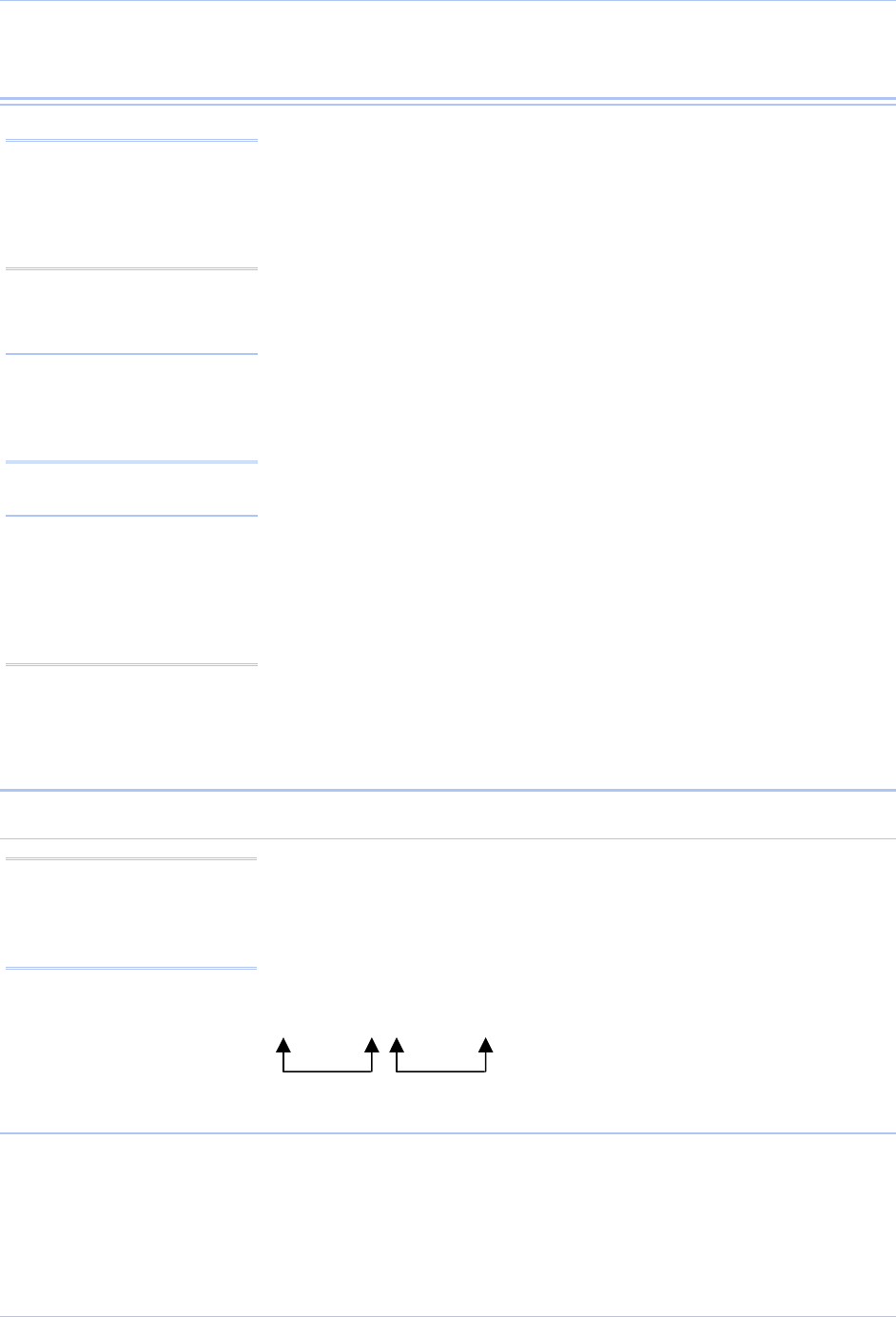
Introduction Quatech SDS User’s Manual
Page 2 Rev 1.50 (3/13/2005)
Understanding how virtual communication ports work
Single port Device Servers allow you to network individual serial
devices such as printers, simple terminals, or medical monitoring
equipment that were previously accessible only via a direct link.
According to Dataquest, a Device Server is a “specialized network-
based hardware device designed to perform a single or specialized set
of functions with client access independent of any operating system or
proprietary protocol.” In terms of your new SDS, this means that you
can connect any serial device to your network by connecting the serial
device to a serial port on your SDS and connecting the Ethernet port
on your SDS to your network.
The SDS, once it has been correctly configured, makes accessing a
single serial device such as a time clock from your network a
transparent operation. This means that a PC can perform all the
operations in the same way it would if the serial device were plugged
directly into its serial port.
A network connection allows operation of serial devices at much
greater distances than can be accomplished with a direct serial
connection. Your SDS uses the TCP/IP protocol suite for network
communications. This means that communication through an SDS
can actually be more reliable than communication over long serial
lines, which lacks the advanced error checking built into TCP/IP.
Another benefit of accessing a serial device through an SDS is that
you can monitor and manage the device remotely, even from across
the world, if you have authorization and the network connection is to
the Internet.
Understanding MAC and IP addresses and port numbers
Identifying the Ethernet (MAC) address
Ethernet address, hardware address, and MAC address are all
equivalent names for a device’s unique network address. In the case
of an SDS, the first three bytes identify the unit as a Quatech
product. The last three bytes are unique to each unit and are
assigned when the unit is released from production. Colons separate
the bytes. The following is an example of an SDS Ethernet (MAC)
address:
00:0B:28:12:34:56
Assigning an IP address
Every device that communicates over the Internet must have a
unique IP address. You can assign an IP address to your SDS by
either of two methods:
! Through the Installation Wizard for initial configuration
! Through the Web interface for reconfiguration and maintenance
Note: Quatech Device Server
technology now allows access
to individual serial devices by
anyone with access to the
network on which they are
installed.
Note: Anyone in your organization
with a PC can connect to the
serial device over the network
just as though the two devices
were directly connected.
Note: A protocol is a set of rules
that notifies a transmitting
device and a receiving device
that the other is present and
ready to exchange information,
when the exchange is complete,
and whether it was successful.
Note: You can find the unit’s
Ethernet (MAC) address on the
product information label
located on the bottom of the
unit.
Quatech’s Unique product
unique identifier identifier

Quatech SDS User’s Manual Introduction
Rev 1.50 (3/13/2005) Page 3
Using Port numbers
In order for devices to communicate via a TCP connection or a UDP
datagram, they must know each other’s IP address and port number.
The SDS driver automatically sets the unit’s port number for you.
A specific port number identifies each SDS serial port. An SDS
assigns a port number of 5000 to the first port, and then increments
the port number sequentially for each subsequent serial port. SDS
drivers must see the first port as IP address: 5000.
Identifying operating modes
Normal, Tunneling, Raw TCP, Auto TCP, and Raw UDP are all
different schemes to make a serial connection across a network using
one or more Serial Device Servers.
Normal mode
If you use Quatech’s virtual COM port drivers or the IntelliSock™
SDK (see TCP socket services – IntelliSock™ on page 6), you should
use the Normal mode to make your network connections. Normal
mode is used in the vast majority of applications. Unless you are
certain that you need to use a different mode, go ahead and configure
your SDS in Normal mode. This mode allows for complete software
control of the serial port by an application program.
Tunneling mode
Serial Tunneling allows two Device Servers and their Ethernet
TCP/IP connection to act like a direct cable connection between two
serial devices. No host computer is required.
Tunneling is very simple to use. Using the SDS’ web interface,
designate one SDS’ serial port as the tunneling master and the other
SDS’ port as the tunneling slave. Configure the master with the serial
port settings desired for the connection as well as the IP address of
the tunneling slave. The master makes the connection and automatically
configures the slave with the corresponding settings.
Raw TCP mode
In Raw TCP mode, serial port data travels over the TCP/IP
connection without any protocol wrapper. You must configure the
serial port settings using the SDS’ web interface. Raw TCP mode
works with most third party universal serial device server drivers.
Auto TCP mode
Auto TCP mode is a special case of Raw TCP mode that allows the
SDS to act as a network client and to initiate a TCP connection to a
network host. You can configure the SDS so that it makes the
connection in one of two possible instances:
! It receives serial data (Data mode).
! It sees that the DSR input is active (DSR mode).
As with Raw TCP mode, you must configure the serial port settings
using the SDS’ web interface. You must configure the SDS with the
Note: You can think of the IP
address as a telephone number
and the port number as a
telephone extension.
Note: This information is
useful for firewall configuration.
Note: Normal is the standard
connection mode for an SDS.
Note: In Tunneling, a master
sends out the configuration
information to a slave so that
the slave can communicate
with it.
Note: You could use Raw TCP
if you were running a simple,
custom TCP application.
Note: Auto TCP is the only
communication mode that lets
an SDS initiate the connection.
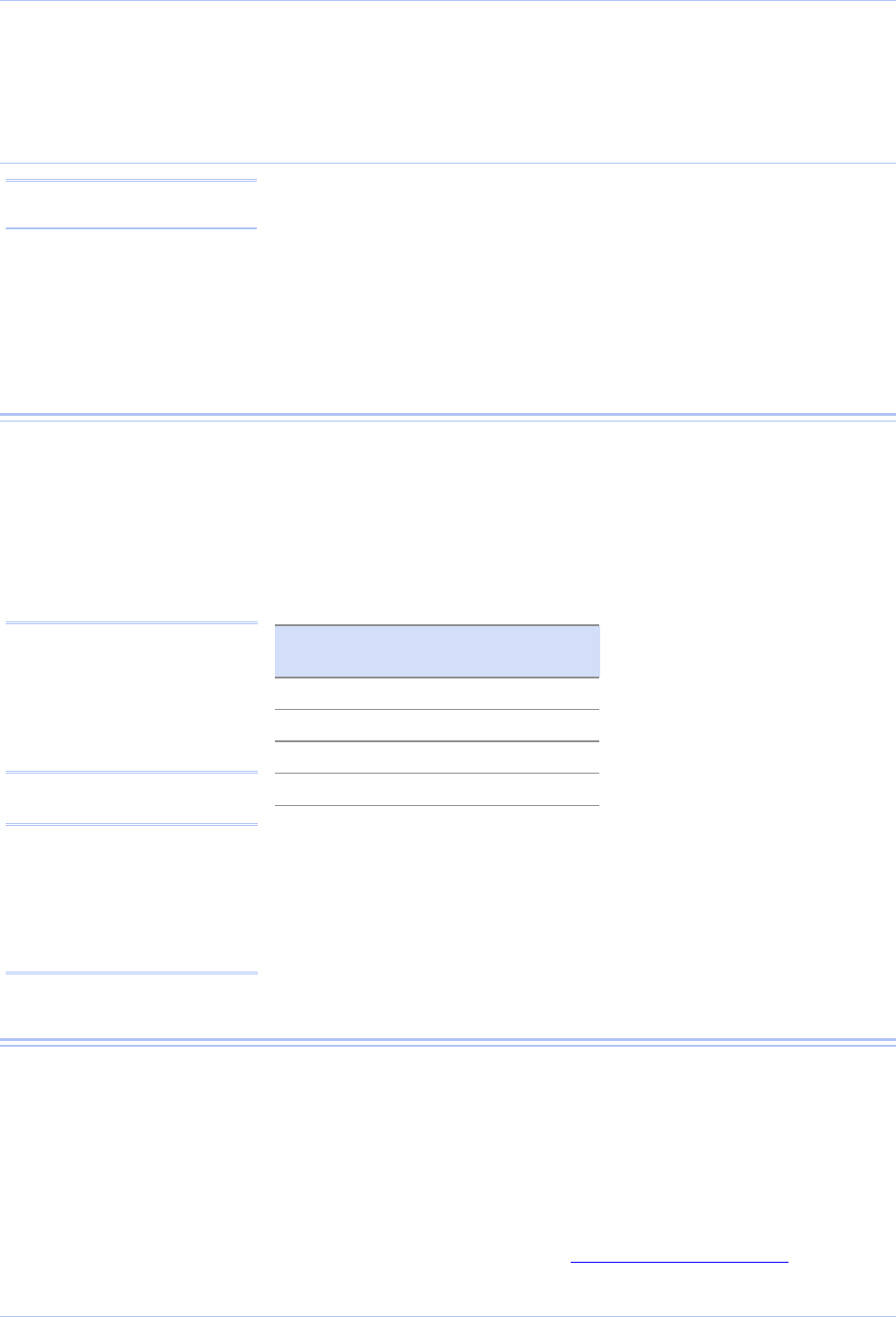
Introduction Quatech SDS User’s Manual
Page 4 Rev 1.50 (3/13/2005)
IP address and TCP port number of the network host to which it
should connect. If the SDS is idle, it will listen for normal Raw TCP
mode connections from the network host.
Raw UDP mode
Raw UDP is used primarily for broadcasting messages over a network.
It is lightweight and efficient; however, your application program
must handle all error processing and retransmission. Quatech
supports the following modes of UDP communication:
! Multicast (transmits to specified group of recipients)
! Broadcast (transmits to unspecified recipients)
! Point-to-Point (transmits to one recipient)
Identifying Quatech’s SDS product line
Quatech provides a family of SDS products. SSE-100, DSE-100, QSE-
100, and ESE-100 provide one, two, four, and eight RS-232 ports for
your serial devices, respectively. SSE-400, DSE-400, QSE-400, and
ESE-400 allow you to software-select between RS-232 and RS-
422/485 communications. For convenience, this manual refers to all
these products as SDS unless otherwise noted.
Table 1 - SDS models
RS-232
Device Ports RS-232/422/485
Device
SSE-100 1 SSE-400
DSE-100 2 DSE-400
QSE-100 4 QSE-400
ESE-100 8 ESE-400
Quatech’s SDS products all perform the same function (see notes),
differing mainly in the number of serial ports available or in the
serial protocol supported. All “D” models, which add a suffix of D to
the part number, (e.g. SSE-100D) are supplied with DB-9 connectors.
All “M” models, which add a suffix of M to the part number, (e.g.
QSE-100M) are not only supplied with DB-9 connectors, but also with
10-pin RJ-45 adapters that attach to the DB-9 connectors.
System requirements
Quatech’s SDS ships with device drivers for Windows 2000, Windows
NT4, Windows XP, and Linux. Other operating systems can access
the SDS using Raw TCP mode or the IntelliSock™ TCP socket
services. Quatech will provide reference materials and utilities to
assist those who wish to do so.
Contact our sales department for details on current software
offerings. Most device drivers are available for download from the
Quatech World Wide Web site at http://www.quatech.com/.
Note: All models are available
with surge suppression as an
–SS option. For example, the 4-
port RS-232 unit with DB-9
connectors and surge suppression
would have a part number of
QSE-100D-SS.
Note: Raw UDP can provide
one-to-many communications.
Note: SDS products with a “W”
in their part numbers (such as
SSEW-100) implement Wi-Fi
technology. They provide serial-
to-wireless communications in
addition to all standard SDS
functions.

Quatech SDS User’s Manual Introduction
Rev 1.50 (3/13/2005) Page 5
Features
Quatech Device Servers can connect virtually any serial device to any
standard Ethernet network (Intranet or Internet) using TCP/IP
protocols. The following list details some of the serial devices an SDS
can bring to your fingertips:
! Security system alarm/access control devices
! Industrial computers and sensors
! Point-of-Sale (POS) peripherals
! Time clocks
! Banking peripherals and ATM machines
! Medical equipment
Protocol support
The SDS communicates over an Ethernet network using the standard
IP and TCP protocols to ensure data integrity and accurate targeting.
An SDS supports the following protocols:
! Network addressing, routing, and data block handling: IP
! Network communications: TCP, UDP, DHCP, HTTP, and ARP
! Network management: SNMP
SNMP Network management support
The Simple Network Management Protocol (SNMP) agent running on
your SDS collects network statistics such as the amount of data
transmitted and received, the number of frames that contain errors,
and the speed of the interface.
A network management system consists of these four parts:
! Network manager – One or more workstations used to monitor
and manage the elements comprising a network
! Managed system – Composed of managed devices on the network
running the agent process, such as an SDS
! Management Information Base (MIB) – Standard organization
scheme for storing data records; an SDS device with a firmware
revision of 5.0 and above supports MIB-II
! Network management protocol – SNMP is a set of rules governing
the exchange of management information between a network
manager and the elements of a managed system
The SDS supports MIB II, which is a standard set of statistics. It
includes information on system interfaces, address translation, IP,
ICMP, TCP, UDP, transmission, and SNMP group information.
For example, the agent running on the SDS collects network statistics
including the amount of data transmitted and received, the number of
frames that contain errors, the percentage of utilization of the
network, maximum packet size, speed, MAC address, and whether
the device is up and working. The agent provides a whole tree of
Note: Quatech Device Servers
capture data from legacy serial
devices without having to go
through a PC.
Note: Only SDS devices with a
firmware revision level of 5.0
and above can support SNMP.
To determine the revision level
of an SDS, check the bottom of
the Home page in the Web-
based interface (see page 43).
Note: The SDS is a read-only
device. You cannot set any
parameters via SNMP.
Note: SNMP is used to
communicate status updates
and parameter values between
a remote device such as an
SDS and a network manager.

Introduction Quatech SDS User’s Manual
Page 6 Rev 1.50 (3/13/2005)
information that a management network host can retrieve using the
Get command.
In addition to providing information upon request, the SDS supports
a cold start Trap, which is a spontaneous message the SDS initiates
whenever it boots up.
Wi-Fi implementation
Wi-Fi, short for wireless fidelity, allows Wi-Fi-enabled devices to
connect to an Ethernet/Internet network without cables or wires. You
can use a Wi-Fi network to connect these devices to each other, to the
Internet, and to wired networks. Wi-Fi is a fast, powerful, reliable,
and secure alternative to wired communication.
Quatech’s Wi-Fi-enabled SDS devices provide serial-to-wireless
network connectivity. They enable you to connect to and communicate
with your serial devices over 802.11b wireless networks. These units
all have a “W” incorporated in their names, such as SSEW-100 or
DSEW-400.
There are two access modes you can use with your Wi-Fi SDS,
depending on whether or not an access point (AP) is involved.
! Infrastructure uses an access point to link the SDS to other
network devices.
For example, an SDS connected to a POS device by a serial cable
will send and receive POS data through an AP to a wireless
network. Any PC connected to that network (either by a wired
connection or via an AP) can communicate directly with the POS
device. Optional WEP security protocol can encrypt data to
protect it during transmission from the SDS to an AP.
! Ad hoc directly links a SDS with another device without going
through an access point. For example, if you connect a security
camera’s serial port to an SDS, a wireless PC can connect directly
to the security camera through the SDS without ever going
through an AP.
Before an SDS can communicate on an 802.11b wireless network, the
WLAN settings must match those of the wireless network. By default,
an SDS is set to Infrastructure network mode and its wireless
Network Name (SSID) is blank, which will allow it to connect to any
available wireless network.
TCP socket services – IntelliSock™
The SDS implements Quatech’s IntelliSock™ TCP socket services.
Quatech supplies device drivers for Windows 2000, NT4, XP, and
Linux to make the SDS look like it is a built-in COM port.
IntelliSock offers you the option of interfacing directly to the SDS
through a TCP socket programming interface rather than using the
virtual COM port device drivers. IntelliSock can be used with any
operating system that supports TCP/IP communication.
Refer to the IntelliSock Software Developer’s Kit (SDK) folder on the
installation CD-ROM for documentation and sample code.
Note: Traps are messages or
alarms generated by an SNMP
agent to indicate to the SNMP
manager that a significant
event has occurred.
Note: Quatech’s IntelliSock™
provides the most flexible and
powerful TCP socket services
available for custom applications.
Note: If you do not need the
power of the IntelliSock interface,
the Raw TCP mode provides a
simple way of using a direct
TCP connection with the SDS.
Note: Wi-Fi is a wireless Ethernet
communication option.
Note: To setup the Wireless
SDS, you must first connect to
it in wired Ethernet mode to
obtain the IP address. Then,
use the Web browser to
configure the network settings
for Wi-Fi communications.
See Enabling Wi-Fi Device
Servers on page 14 for details
on installing and configuring
your wireless SDS.
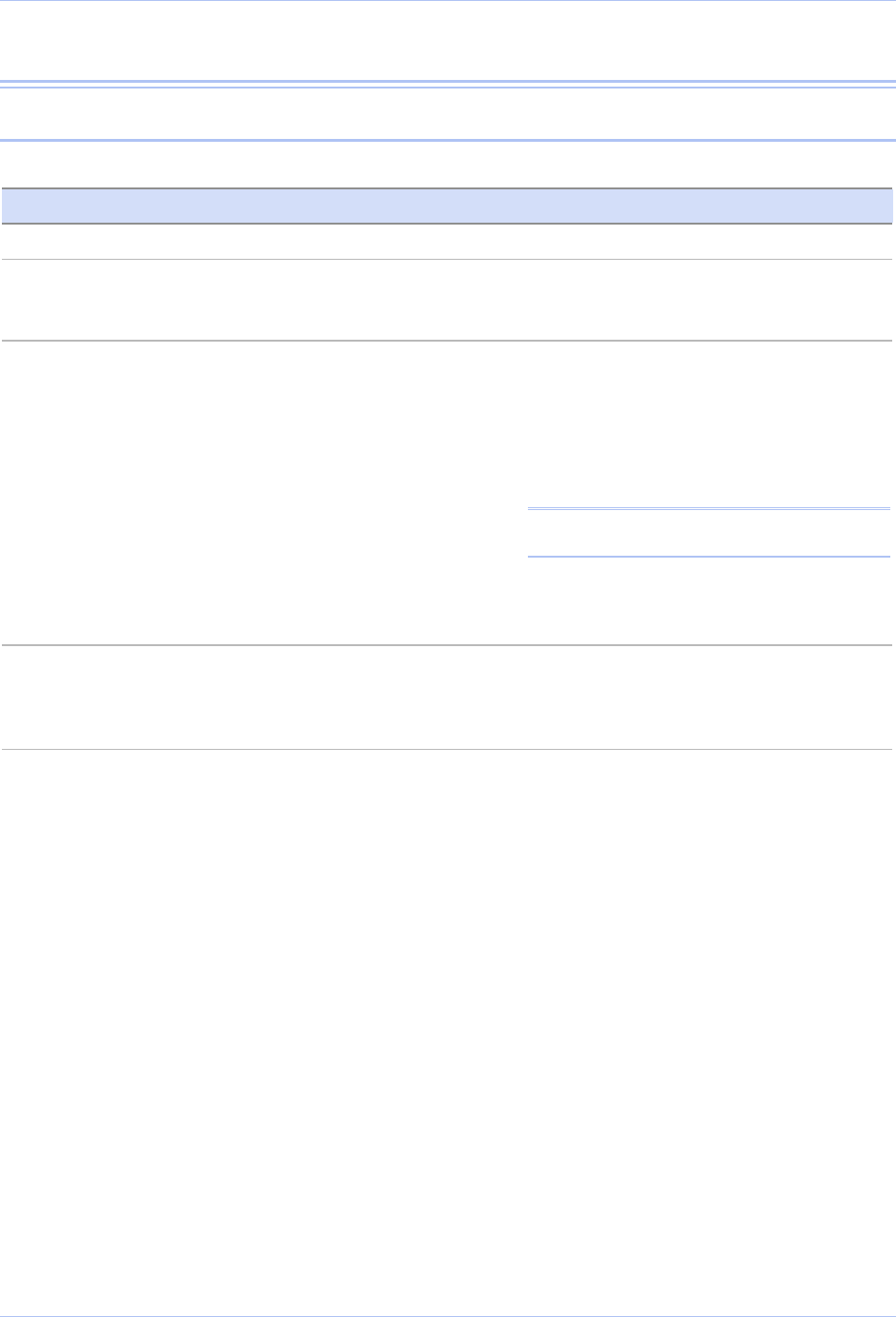
Quatech SDS User’s Manual Introduction
Rev 1.50 (3/13/2005) Page 7
Getting started
Unpacking your SDS
Follow these steps to unpack your SDS.
Step Procedure Description
# Step 1 Remove the SDS from the box.
# Step 2 Remove all packing material from the SDS. Save the packaging in case you ever need
to store the unit or return it to Quatech
for service.
# Step 3 Check the contents of the package to make
sure you have received everything listed
below:
! SDS
! Power cable
! Power source
! Ethernet crossover cable
! Loopback connector(s)
! CD-ROM containing the SDS device
drivers and configuration software
! QuickStart guide
The complete SDS package ships in a
single box.
Note: Crossover cables only ship with the
QSE-100 and ESE-100 models.
# Step 4 Check the SDS and accessories for shipping
damage.
Pay particular attention to the SDS’ case
and port connectors. If anything is
missing or damaged, contact your
Quatech sales representative.
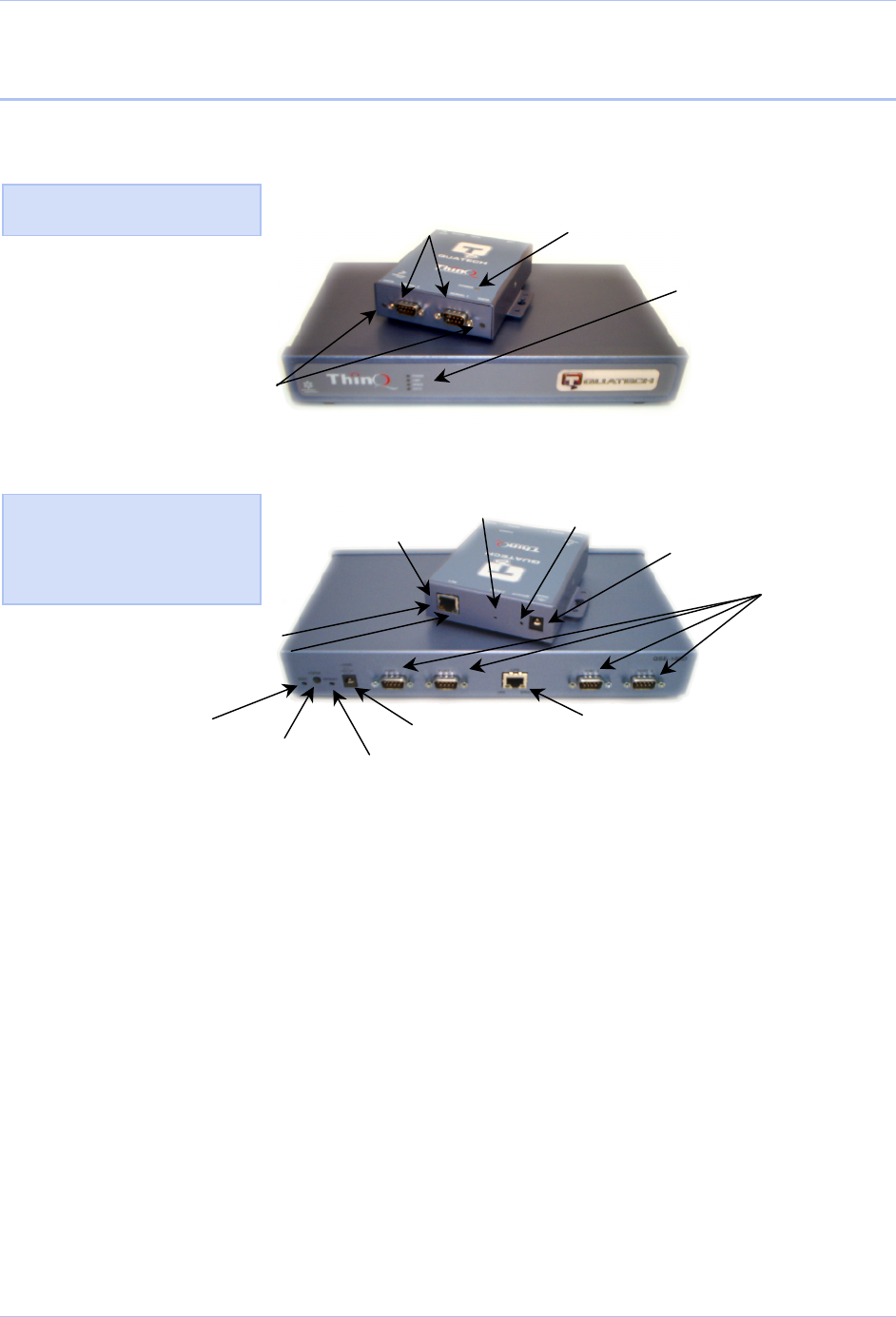
Introduction Quatech SDS User’s Manual
Page 8 Rev 1.50 (3/13/2005)
Identifying parts
Figures 1 and 2 show the parts of the SDS. See below for a description
of each part.
Figure 1 - SDS front view
Figure 2 - SDS back view
Figure 1 shows the front view
of the SDS.
1. The SDS has five indicator LEDs:
! Power (blue) – indicates when the SDS has line power
! Data (red/green) – indicates serial port data activity by blinking red for RS-232 or green for RS-422/485; QSE-/ESE-100s
have a single red Data LED that indicates any serial port activity by blinking
! Status (green) – indicates when the embedded processor is up and running
! Link (green) – indicates when a network link has been established; located on left side of Ethernet connector in RS-
232/422/485 units; QSE-/ESE-100s also have a separate Link LED
! Speed (amber) – differentiates between 100Base-T (glowing) and 10Base-T (off) Ethernet connection speeds; located on
right side of Ethernet connector in RS-232/422/485 units; QSE/ESE-100s also have a separate green Speed LED
2. The DB-9 serial port(s) connect to your serial device(s) and can support RS-232, RS-422, or RS-485 connections. They
are located either to the left, to either side of the Ethernet port, or on the front panel, depending on the model.
3. The RJ-45 Ethernet port connects the SDS to the Internet or to your Intranet. It has two small status LEDs: Link on the
left and Speed on the right.
4. The power jack should be connected to a +5V power source, provided with the SDS.
5. The Reset button puts the SDS through a reset cycle and can also restore the SDS to the factory default settings. The
QSE-100 and ESE-100 use a Default button to restore factory default settings.
6. The information label (not shown) is on the bottom of the SDS. It includes the following:
! MAC address
! Serial number
! Certifications
! Pinout diagram
(4) Power jack
(2) Serial ports
(1) Status LED
(5) Reset button
(3) Ethernet port
(4) Power jack
Figure 2 shows the rear view of
the SDS. The actual number
and location of serial ports
will vary according to the
model.
(2) Serial ports (1) Power LED
(1)
Link LED
Speed LED
(3) Ethernet port
(1) Data LEDs
(1)
Power LED
Link LED
Speed LED
Data LED
(5) Default button
(5) Reset button (1) Status LED
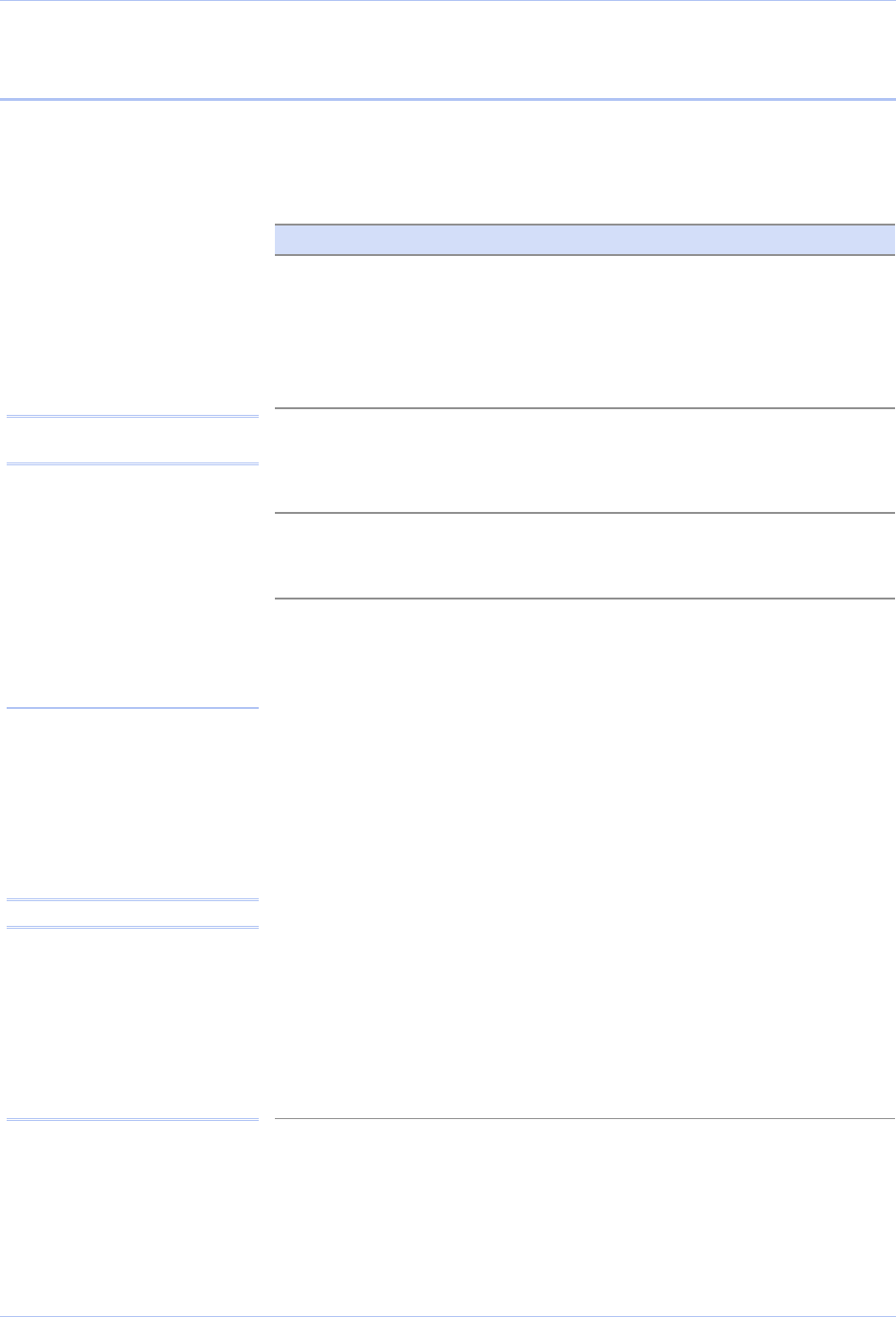
Quatech SDS User’s Manual Introduction
Rev 1.50 (3/13/2005) Page 9
Understanding LED codes
The SDS LEDs inform you of the communications status and activity
of the SDS. The following table lists the possible states of the LEDs
and their meaning.
Table 2 - SDS LED codes
LEDs Meaning
Link (green) On steady = connected to network
On steady for Wi-Fi SDS units:
! Infrastructure = SDS is
associated with Access Point
! Ad hoc = SDS has found
device to communicate with
Speed (amber) Off = 10 Mbps network connection
established if Link LED is on
On steady = 100 Mbps network
connection established
Data (red/green) Red = RS-232 connection
Green = RS-422/485 connection
Blinking = data activity
Status (green)
The Status LED also works in
conjunction with the Reset button
as follows:
On = SDS is up and running
1. To restore the SDS to the
factory default configuration,
push in and hold the Reset
(Default) button. When the
Status LED starts flashing
slowly, and before it starts
flashing rapidly, release the
button. The SDS then restarts
automatically.
If the Reset (Default) button is
held during the first 10 seconds of
bootup, the Status LED flashes at
a rate of 1 flash every 2 seconds
for 10 seconds. If the button is
released during this time period,
the configuration is reset to factory
defaults.
2. To restore the SDS to the
factory default firmware
revision, push in and hold the
Reset (Default) button. When
the Status LED changes from
a slow flash to a rapid flash,
release the button. The SDS
then restarts automatically.
If the Reset (Default) button is
held past the first 10 seconds of
bootup, the LED flashes faster at a
rate of 1 flash every second for 10
seconds. If the button is released
during this time period, the SDS
is reset back to the factory default
firmware revision.
Note: If you press and
immediately release the Reset
button, the SDS restarts
automatically with no changes.
Also, if you continue holding
the Reset (Default) button
longer than 20 seconds, the
Status LED stops flashing and
no changes are made.
Note: QSE-/ESE-100 units
have a Default button in
addition to a Reset button. If
you have one of these units,
hold the Default button (see
parentheses) and momentarily
press and release the Reset
button. Continue holding the
Default button as indicated.
Note: QSE-/ESE-100 units
have a green Speed LED.
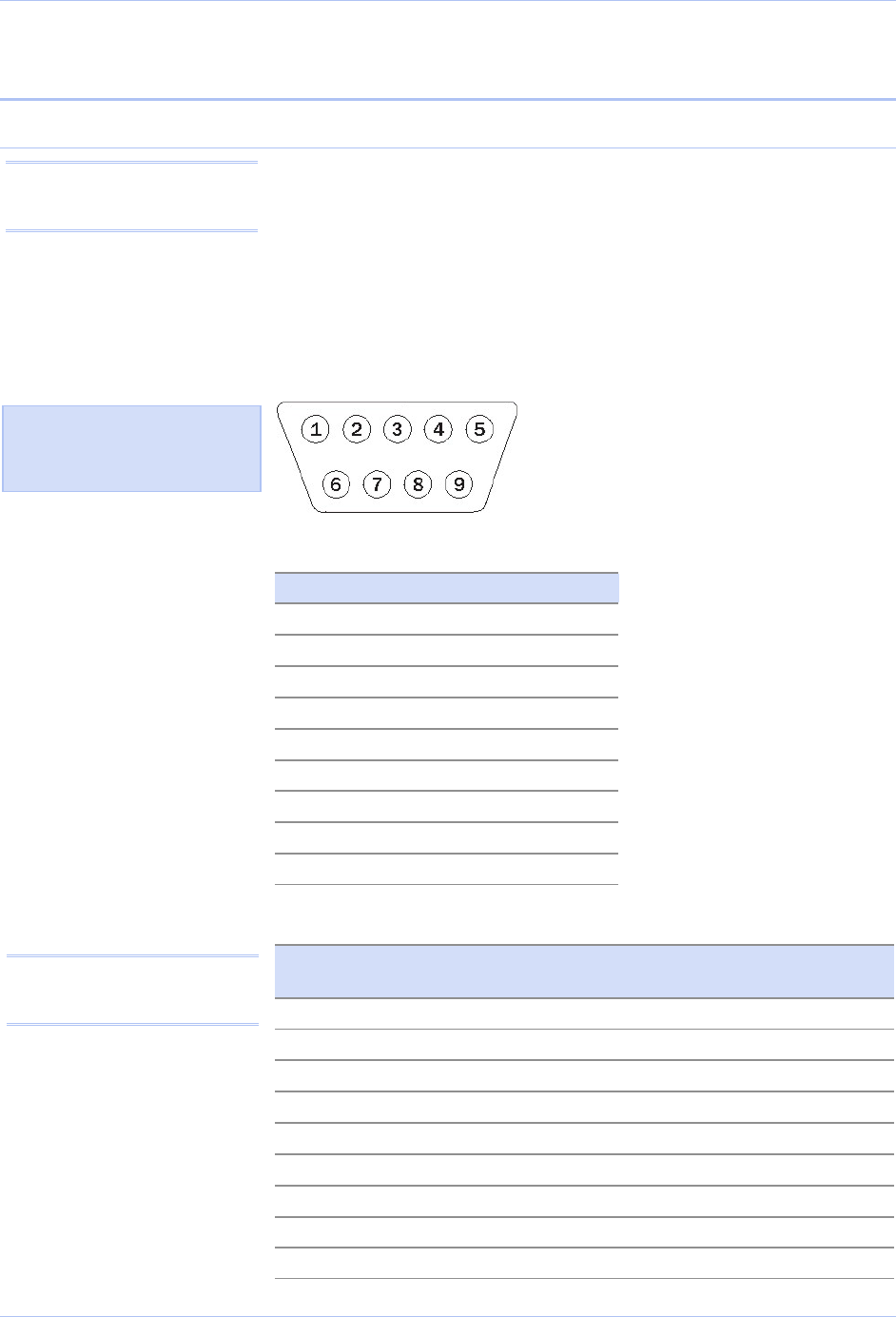
Introduction Quatech SDS User’s Manual
Page 10 Rev 1.50 (3/13/2005)
Locating serial and network ports
Serial port(s)
SDS serial ports connect via cables to your serial device(s). The
number of these ports will vary depending on the SDS model. All SDS
models come with DB-9 serial port connectors. RS-232 “M” models
include adapter plugs to convert the DB-9 connectors to RJ-45
connectors. See Making connections on page 13 for directions on
connecting an SDS serial port to a serial device.
The following figures and tables show the serial port pinouts for RS-
232 and RS-232/422/485 applications.
Figure 3 - DB-9 pinouts
Table 3 - RS-232 signals on DB-9 connector
RS-232 signal description DB-9
Data Carrier Detect (DCD) 1
Receive Data (RxD) 2
Transmit Data (TxD) 3
Data Terminal Ready (DTR) 4
Signal Ground (GND) 5
Data Set Ready (DSR) 6
Request To Send (RTS) 7
Clear To Send (CTS) 8
Ring Indicator (RI) 9
Table 4 - RS-422/485 signals on DB-9 connector
RS-422/485 signal description
four-wire mode DB-9 RS-422/485 signal description
two-wire mode
Auxiliary Input (AuxIn–) 1 NC
Receive Data (RxD+) 2 NC
Transmit Data (TxD+) 3 Transmit/Receive Data (Data+)
Auxiliary Output (AuxOut–) 4 NC
Signal Ground (GND) 5 Signal Ground (GND)
Receive Data (RxD–) 6 NC
Auxiliary Output (AuxOut+) 7 NC
Auxiliary Input (AuxIn+) 8 NC
Transmit Data (TxD–) 9 Transmit/Receive Data (Data–)
Figure 3 and Tables 3 and 4
show the RS-232/422/485
DB-9 pinouts and signal
descriptions.
Note: The location of the serial
port(s) varies, depending on
the model.
Note: Pins labeled NC are
indeterminate in two-wire mode
and should be left unconnected.

Quatech SDS User’s Manual Introduction
Rev 1.50 (3/13/2005) Page 11
Figure 4 - RJ-45 pinouts (DB-9 to RJ-45 adapter)
Table 5 - RS-232 signals on RJ-45 connector (DB-9 to RJ-45 adapter)
RS-232 signal description RJ-45
Ring Indicator (RI) 1
Request To Send (RTS) 2
Data Terminal Ready (DTR) 3
Signal Ground (GND) 4
Transmit Data (TxD) 5
Receive Data (RxD) 6
Data Carrier Detect (DCD) 7
Data Set Ready (DSR) 8
Clear To Send (CTS) 9
No Connection 10
Table 6 - RS-422/485 signals on RJ-45 connector (DB-9 to RJ-45 adapter)
RS-422/485 signal description
four-wire mode RJ-45 RS-422/485 signal description
two-wire mode
Transmit Data (TxD–) 1 Transmit/Receive Data (Data–)
Auxiliary Output (AuxOut+) 2 NC
Auxiliary Output (AuxOut–) 3 NC
Signal Ground (GND) 4 Signal Ground (GND)
Transmit Data (TxD+) 5 Transmit/Receive Data (Data+)
Receive Data (RxD+) 6 NC
Auxiliary Input (AuxIn–) 7 NC
Receive Data (RxD–) 8 NC
Auxiliary Input (AuxIn+) 9 NC
No Connection 10 No Connection
Figure 4 and Tables 5 and 6
show the RS-232/422/485
-RJ-45 pinouts and signal
descriptions.
Note: If your serial port cable
uses an 8-pin RJ-45 plug, you
can use the center eight pins of
the SDS’ RJ-45 connector for
RS-232 communications. You
will lose access to the Ring
Indicator signal.
Note: Pins labeled NC are
indeterminate in two-wire mode
and should be left unconnected.
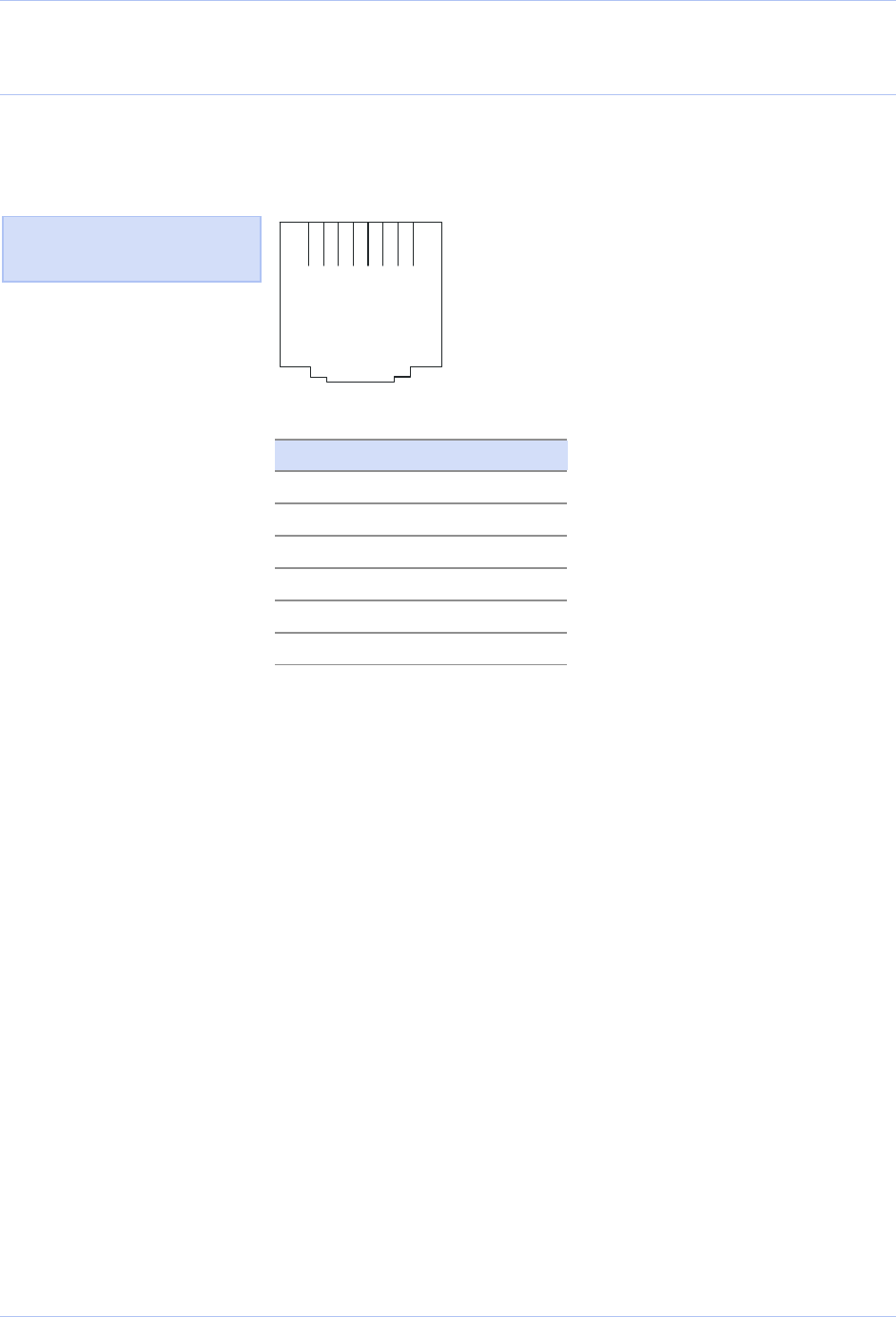
Introduction Quatech SDS User’s Manual
Page 12 Rev 1.50 (3/13/2005)
Network port
All SDS devices have one eight-pin RJ-45 Ethernet port on the back
panel.
Figure 5 - RJ-45 Ethernet port pinout
1 2 3 4 5 6 7 8
Table 7 - RJ-45 Ethernet port signals
Ethernet signal description RJ-45
Transmit Data (TxD+) 1
Transmit Data (TxD–) 2
Receive Data (RxD+) 3
No connection 4, 5
Receive Data (RxD–) 6
No connection 7, 8
Figure 5 and Table 7 show the
Ethernet RJ-45 pinouts and
signal descriptions.
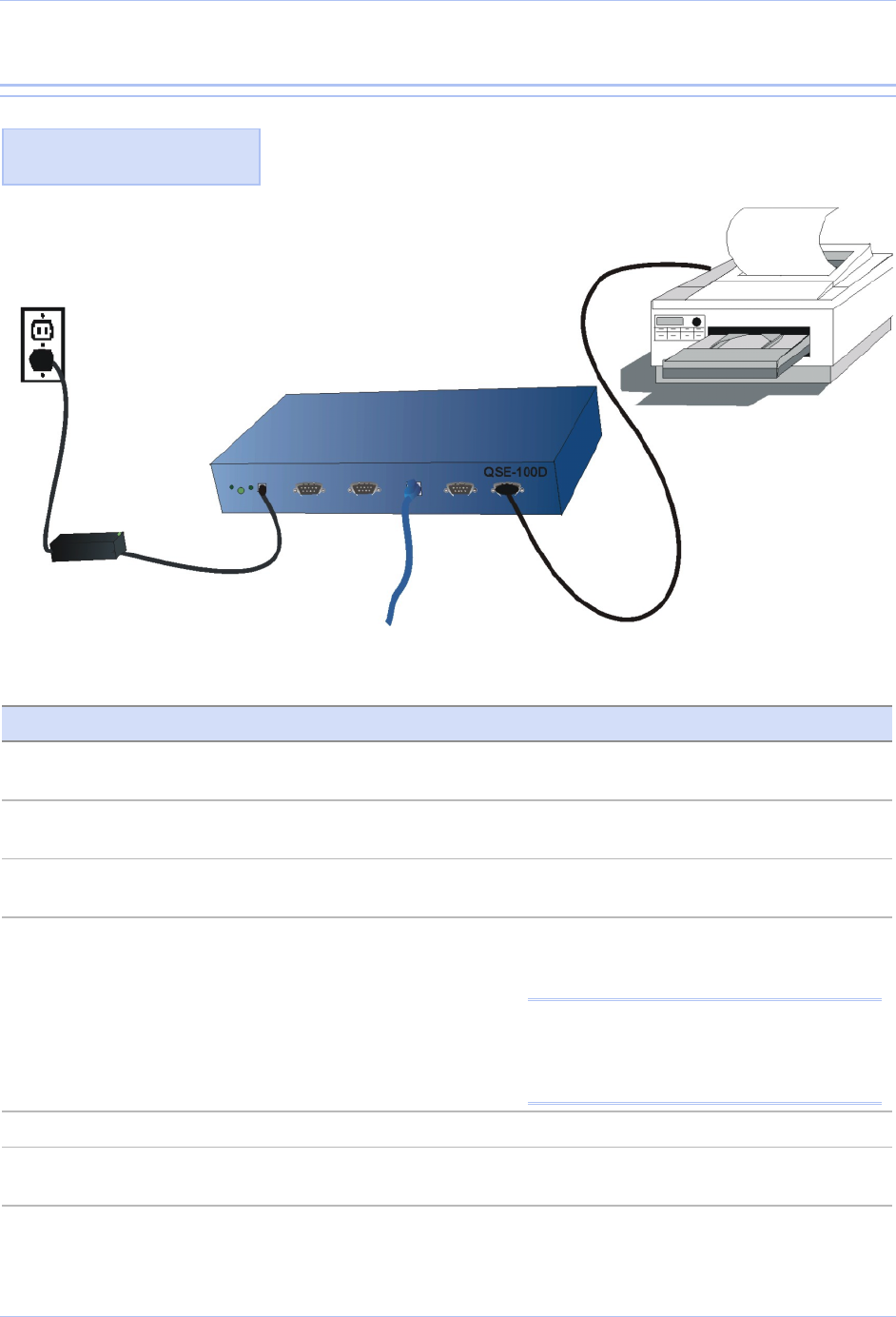
Quatech SDS User’s Manual Making connections
Rev 1.50 (3/13/2005) Page 13
Making connections
You can easily connect each serial port on your SDS to any serial device
that you want to make accessible to an Ethernet network.
Figure 6 - Connecting an SDS to a serial device
Follow these steps to connect your SDS to one or more serial devices.
Step Procedure Description
# Step 1 Make sure the serial device you are
connecting to the SDS is turned off.
The SDS should be unplugged.
# Step 2 Connect a serial cable between the SDS
and your serial device.
See Serial port(s) on page 10 for pinout
and connector information.
# Step 3 Connect an Ethernet cable between your
Ethernet outlet and the SDS’ 10/100 port.
The Ethernet port is located on the back
panel.
# Step 4 Insert the power source jack into the
power plug on the back of the SDS.
An SDS requires a 5-VDC, 2-A (10-W
max) power source. The power source
ships with the SDS.
Note: These are the available power cables:
920-0111-01A Std North America
920-0112-01A Std Continental Europe
920-0113-01A Std United Kingdom
920-0114-01A Std Australia
# Step 5 Plug the power source into a wall socket. The SDS powers up automatically.
# Step 6 Power up the serial device. Now you are ready to install the device
drivers!
Figure 6 shows a four-port
SDS connected to a printer.
Serial device
SDS
Power
source 10/100
Ethernet
connection
Serial cable
Electrical
outlet
Power
cord
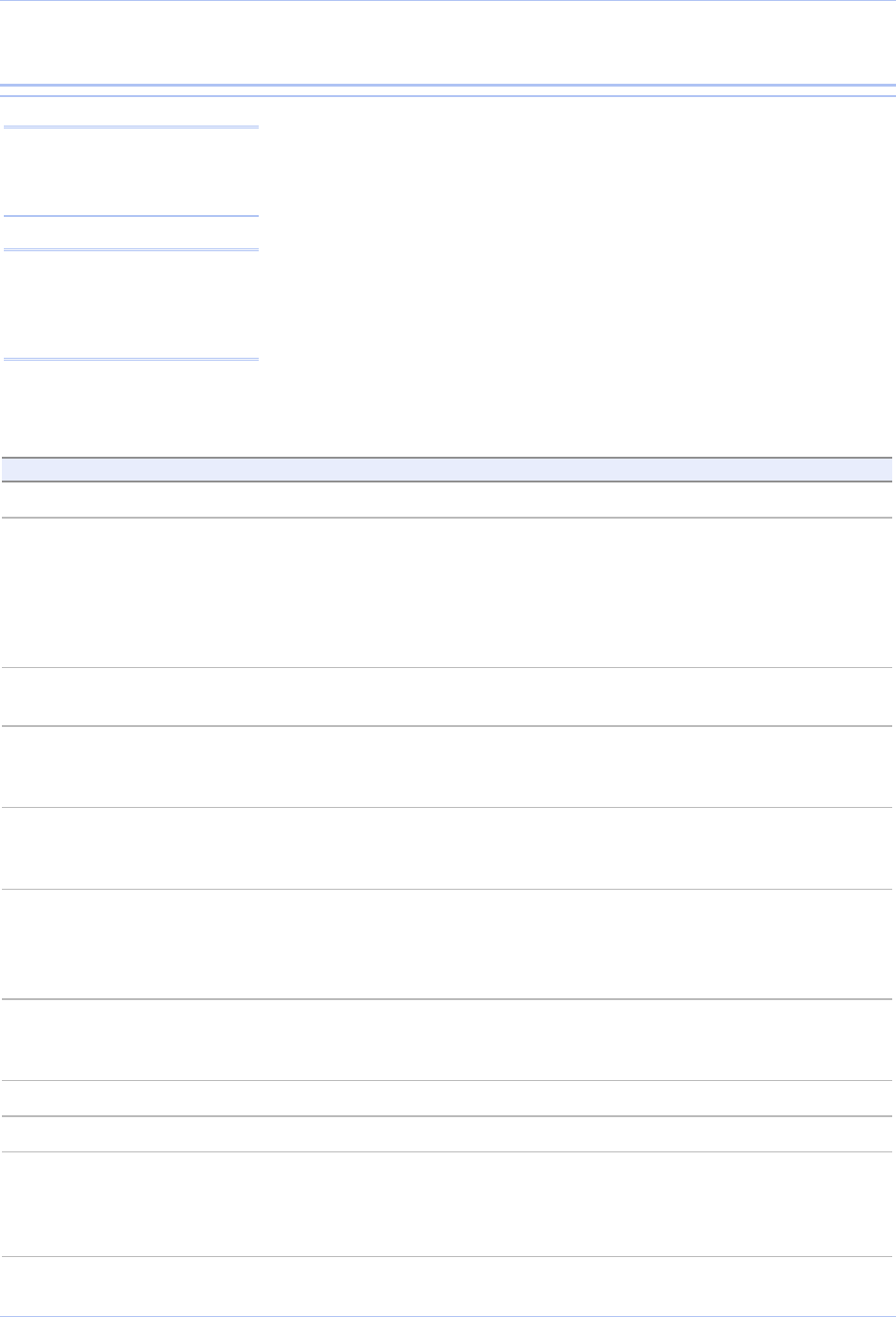
Enabling Wi-Fi Device Servers Quatech SDS User’s Manual
Page 14 Rev 1.50 (3/13/2005)
Enabling Wi-Fi Device Servers
Quatech’s Wi-Fi Device Servers need to have a wireless network
connection established before they can be configured for use. To
enable the wireless connection, you need to obtain the SDS’ IP
address as outlined below. Once you have the IP address, you can
configure the SDS for wireless communications via the Web interface.
In Infrastructure mode, you can use your wireless SDS just as you
would a wired SDS, but it will communicate via an access point on
the 801.11b network rather than through an Ethernet cable. The SDS
will scan all channels until it finds an AP, at which time the Link
LED on the Ethernet port will glow green.
The following briefly describes how to obtain the IP address of the SDS
and to enable wireless communications. For greater detail, see Installing
the device drivers on page 16 and Setting network parameters on page 45.
Step Procedure Description
# Step 1 Turn on the power to your computer system.
# Step 2 Insert the Quatech SDS installation CD-
ROM into your CD-ROM drive.
If the CD-ROM does not launch
automatically, select Start – Run from the
Task bar, browse to the CD-ROM drive,
and select the ThinQ.exe file. Click “OK” in
the Run window to launch the
installation.
# Step 3 From the Main Menu, select Install SDS.
Click Next.
# Step 4 Connect the Ethernet port on your SDS
either to the NIC port on your computer or
to a switch/hub.
Use a CAT5 or better Ethernet cable to
attach the SDS.
# Step 5 Connect power to the SDS. When the SDS
is ready, click the Next button to search for
Serial Device Servers.
When the SDS is ready, the Status, Power,
and Link LEDs should glow.
# Step 6 When the search is finished, find your SDS
and make note of its IP address.
Press Cancel to abort the installation
procedure.
You will need this address for the network
configuration.
# Step 7 Open your Web browser and type the IP
address for the SDS in the Web browser’s
URL (address) field.
The Quatech Device Server Home page
displays.
# Step 8 Click on Network in the selection bar.
# Step 9 Select Infrastructure as the Access Mode.
# Step 10 Configure the Device Server’s SSID to
match the access point’s SSID.
To communicate wirelessly, the AP and
the SDS must both use the same SSID. If
you don’t know the proper SSID, check
with your system administrator.
Note: Wi-Fi Device Servers link
via an AP in Infrastructure
mode; they connect directly to
another device in Ad hoc mode.
Note: In Ad hoc mode, the Link
LED on the Ethernet port will
glow green when your wireless
SDS finds and communicates
with another device.
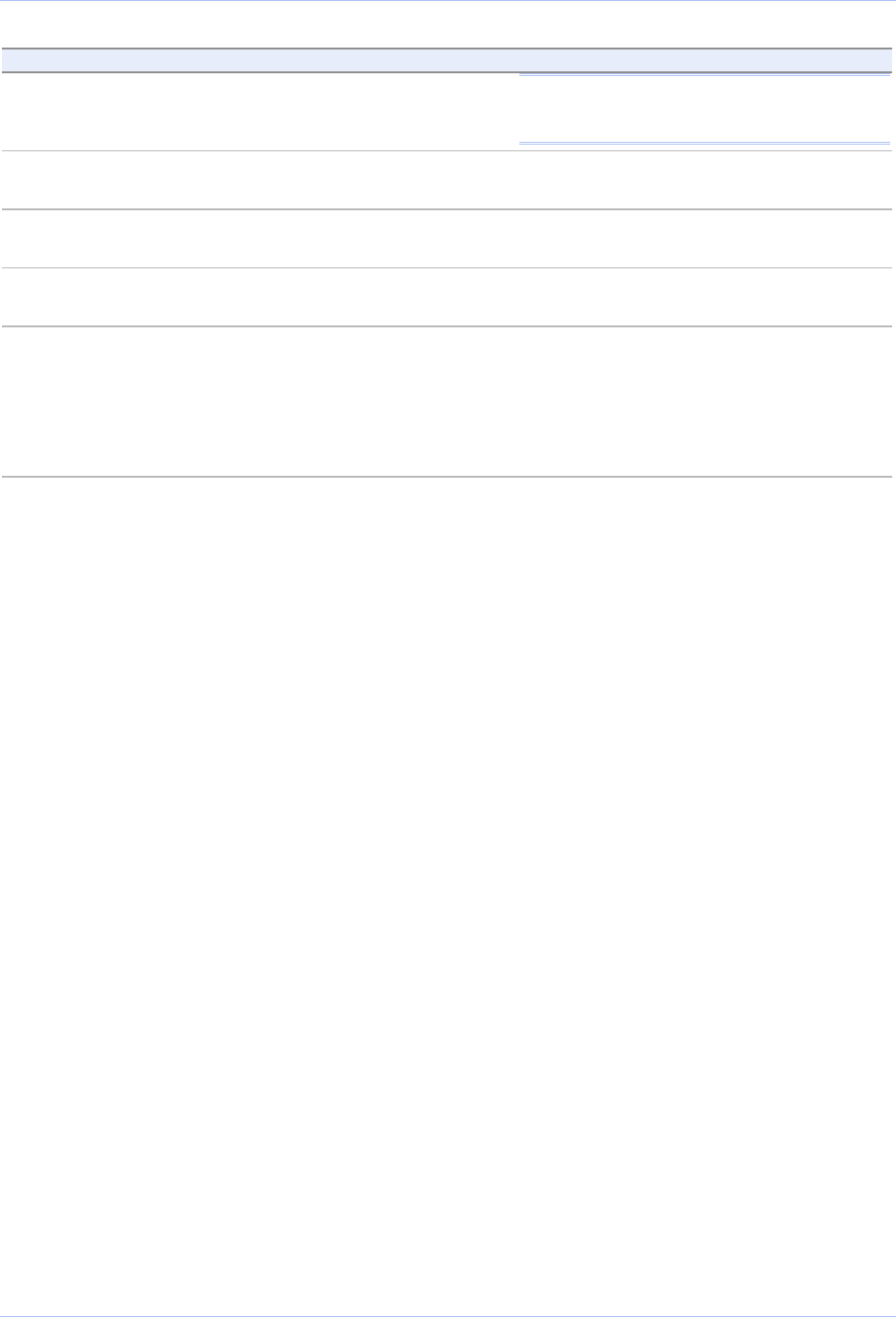
Quatech SDS User’s Manual Enabling Wi-Fi Device Servers
Rev 1.50 (3/13/2005) Page 15
Step Procedure Description
Note: The Channel setting is only used in Ad
hoc mode. In Infrastructure mode, the AP
determines the channel.
# Step 11 Press Submit to configure the SDS with
your settings.
The IP Address Update successful screen
displays.
# Step 12 Reset the SDS. Click on the link to perform a remote reset,
and then press Reset.
# Step 13 Remove the Ethernet cable from the SDS
during the reset process.
Be sure to remove the Ethernet cable before
the reset process is finished.
# Step 14 Leaving the Ethernet port unconnected,
perform the procedure shown in Installing
the device drivers starting on page 16,
skipping □ Step 6.
When you are finished, you are ready to
install your wireless SDS in its final
location. For details on connecting your
wireless SDS to a serial device, see
Making connections starting on page 13,
skipping □ Step 3.
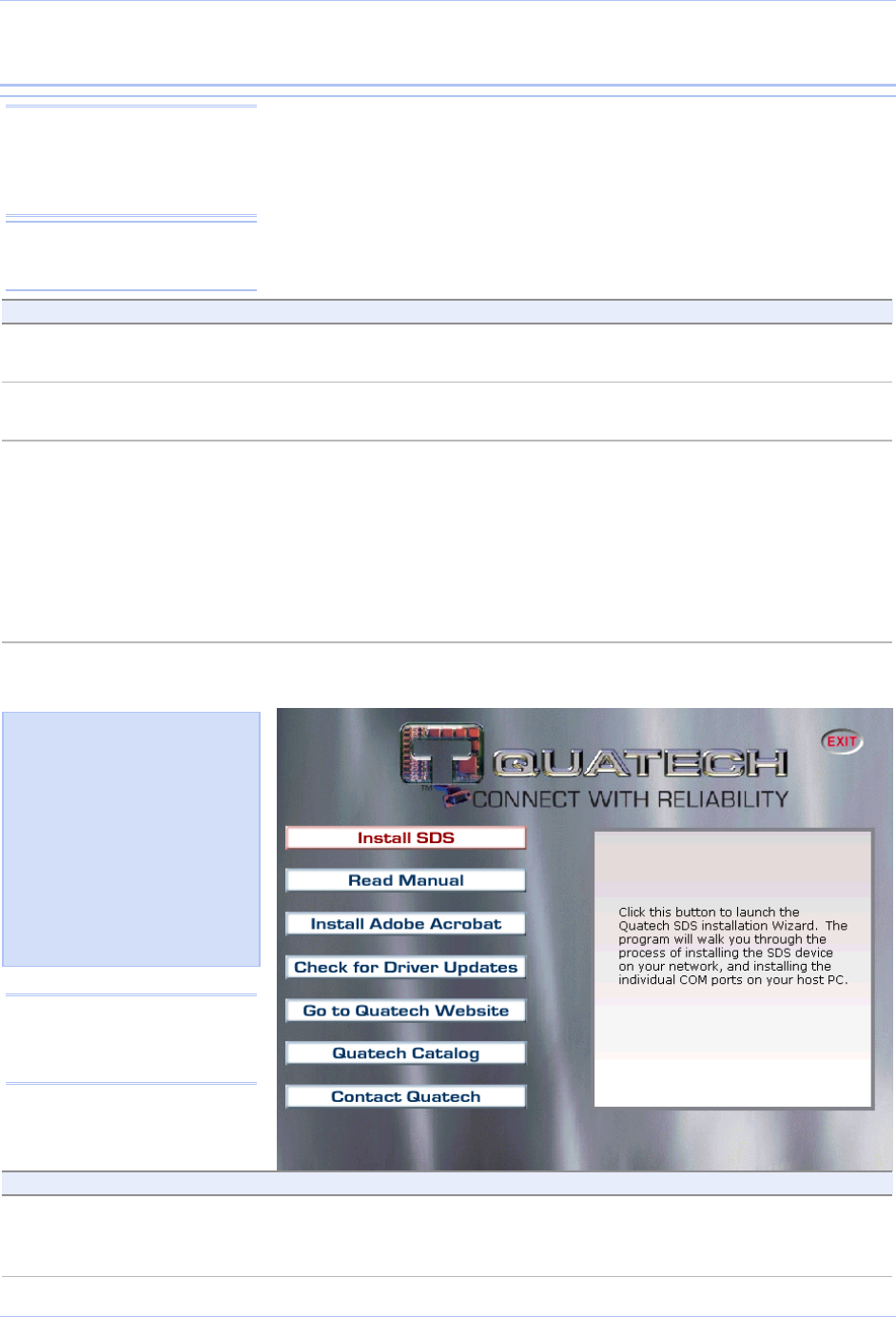
Installing the device drivers Quatech SDS User’s Manual
Page 16 Rev 1.50 (3/13/2005)
Installing the device drivers
This section explains how to install the SDS software under the
Windows 2000, Windows NT4, and Windows XP operating systems.
The Quatech Device Server Install Wizard helps you to add new SDS
hardware. It takes into account a variety of circumstances and directs
you to jump to different Steps as needed. Click on the blue “Go to
□ Step” text in the Description column to automatically jump to that
step. Continue from that point until you are directed to a different location.
Step Procedure Description
Step 1 Turn on the power to your computer system. This is the client PC in which the SDS
drivers are to be installed.
Step 2 Insert the Quatech SDS installation CD-
ROM into your CD-ROM drive.
This is the CD that shipped with the SDS.
Step 3 The CD-ROM should launch automatically.
If the CD-ROM does not launch
automatically, select Start – Run from the
Task bar, browse to the CD-ROM drive,
and select the ThinQ.exe file. Click “OK” in
the Run window to launch the installation.
The Quatech Serial Device screen displays,
followed by the Main Menu screen.
Continue with □ Step 4.
The Quatech Serial Device screen displays,
followed by the Main Menu screen.
Continue with □ Step 4.
Figure 7 - Main Menu screen
Step Procedure Description
Step 4 From the Main Menu, select Install SDS. The Quatech Install Wizard launches and
displays the Welcome screen. Continue
with □ Step 5.
Note: You must install the
drivers on the installation CD-
ROM on every computer that
accesses the device(s) attached
to the SDS.
Hint: Click on Go to □ Step in
the rightmost column to jump
to your next step.
Figure 7 illustrates the Quatech
Install Wizard’s Main Menu
screen. The Wizard helps you
to install the drivers and
configure the SDS. This
installation adds the SDS to
the devices in the Windows
Device Manager under Multi-
port serial adapters and
installs the serial port(s) as it
would a standard COM port(s)
under Ports (COM & LPT).
Note: Press the Help key for
additional information as you
go through the installation
procedure.
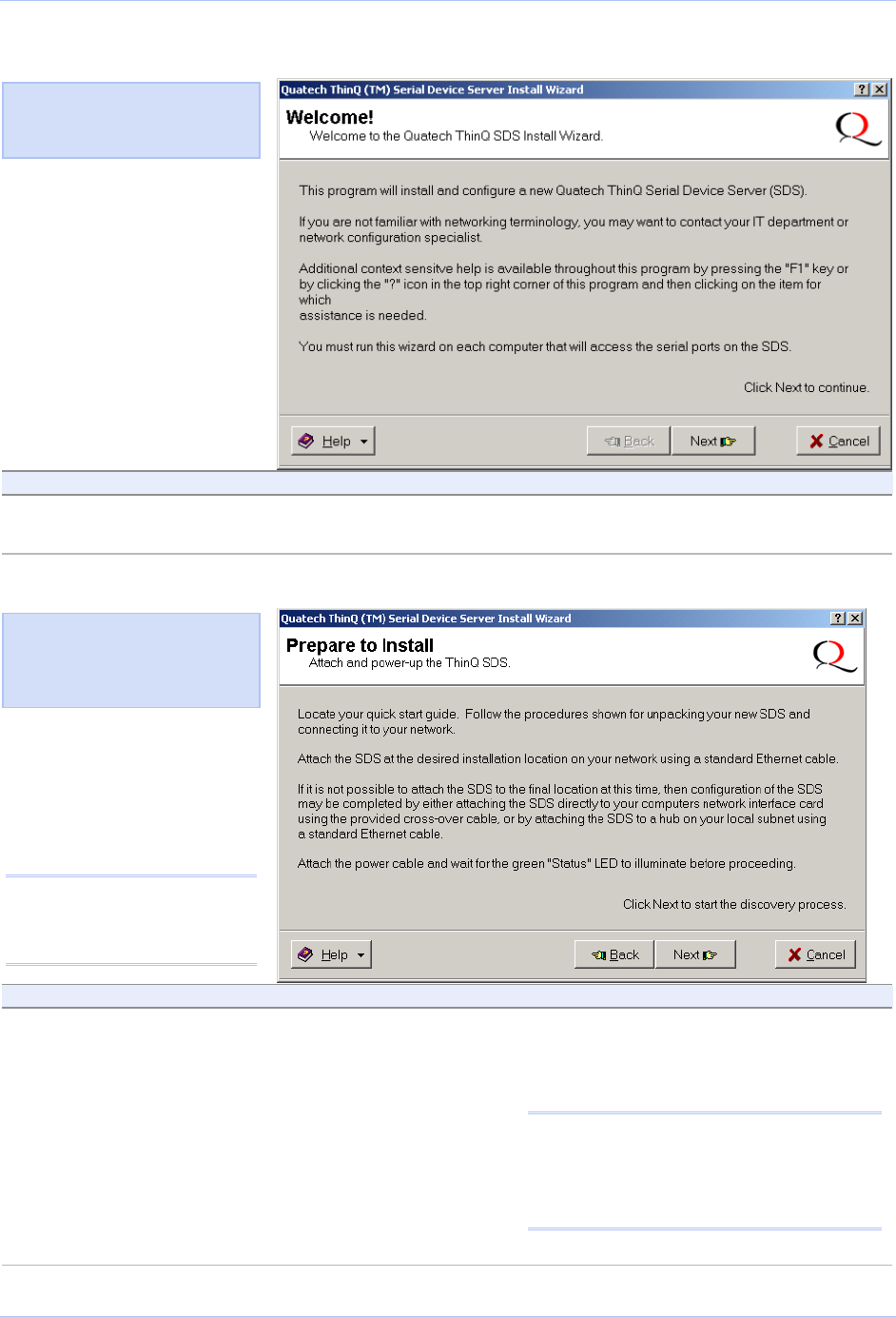
Quatech SDS User’s Manual Installing the device drivers
Rev 1.50 (3/13/2005) Page 17
Figure 8 - Welcome screen
Step Procedure Description
Step 5 Click the Next button to continue. The Prepare to Install screen displays.
Continue with □ Step 6.
Figure 9 - Prepare to Install screen
Step Procedure Description
Step 6 Connect the Ethernet port on your SDS to
one of the following:
! Desired installation location,
! Hub on your local subnet, or
! Network Interface Connection (NIC)
on your computer using an Ethernet
crossover patch cable.
If you cannot immediately attach the SDS
to the target installation site, temporarily
attach it to the local hub or your computer’s
NIC for configuration purposes.
Notes: Use a CAT5 or better Ethernet cable
to attach the SDS to your network.
If your SDS is pre-configured for your
network, attach it now to the appropriate
subnet location.
Continue with □ Step 7.
Figure 8 illustrates the Quatech
Install Wizard’s Welcome
screen.
Figure 9 illustrates the Prepare
to Install prompt. Be sure to
read this screen carefully
before proceeding.
Note: Press the Help key for
additional information as you
go through the installation
procedure.

Installing the device drivers Quatech SDS User’s Manual
Page 18 Rev 1.50 (3/13/2005)
Step Procedure Description
Step 7 Connect power to the SDS. Connect the cable attached to the power
source to the SDS. Plug the connector of
the unattached power cable into the
power source’s socket. Plug the other end
of the cable into a power outlet. The SDS
powers up and the blue Power LED
lights.
Step 8 Confirm that the SDS is ready to proceed. The Status LED to the left of the power
jack should glow green. The Power LED
should glow blue and the Link LED
should glow green.
Step 9 Click the Next button to search for device
servers.
The Search network for Serial Device
Servers screen displays and the Wizard
searches the local subnet for active serial
device servers.
Continue with □ Step 10.
Figure 10 - Search network for Serial Device Server(s) screen
Step Procedure Description
Step 10 When the search is completed, look in the
list of detected devices.
! If you find your SDS, highlight it and
click on I have selected the device I
wish to install. Press Next.
! If you do not see your SDS, click on
the Retry Search button. If it still is
not found, click on “My device was not
found.” Press Next.
Continue with □ Step 11.
The Locate the Serial Device Server
screen displays. Go to □ Step 42.
Figure 10 shows the search
results for all active device
servers on the local subnet.

Quatech SDS User’s Manual Installing the device drivers
Rev 1.50 (3/13/2005) Page 19
Step Procedure Description
Step 11 One of two possible screens displays:
! Where is the Serial Device Server
attached?
! Reconfigure the Serial Device Server
If your SDS is directly connected to your
computer or to the local subnet, the
Where is the Serial Device Server
attached screen displays.
Continue with □ Step 12.
If your SDS is remotely connected, the
Wizard offers you the option to change
the configuration and move the SDS to
the subnet where it will be permanently
installed. The Reconfigure the Serial
Device Server screen displays.
Go to □ Step 30.
Figure 11 - Where is the Serial Device Server attached screen
Step Procedure Description
Step 12 Select one of two options:
! The SDS is attached to the location
where it will be installed and used.
! The SDS is plugged into a temporary
location for configuration purposes.
Choose this option if the SDS is
installed where you intend to use it.
Continue with □ Step 13.
Choose this option if you need to move
the SDS to another location before using
it. Continue with □ Step 13.
Step 13 Press Next to continue.
One of two possible screens displays:
! Network Connectivity Test
! Reconfigure the Serial Device Server
If your SDS is installed in its final location,
the Network Connectivity Test screen
displays. Continue with □ Step 14.
The Wizard helps you to configure and
move the SDS to its permanent spot.
Go to □ Step 30.
Figure 11 asks you to specify
whether the SDS is in its final
installation location of if it is
temporarily installed while you
configure it.
Caution! Do not unplug or
move the SDS at this time.

Installing the device drivers Quatech SDS User’s Manual
Page 20 Rev 1.50 (3/13/2005)
Figure 12 - Network Connectivity Test screen
Step Procedure Description
Step 14 Press the Next button to run the IP
connectivity test.
The Retrieving Unit Configuration pop-
up box displays briefly.
Continue with □ Step 15.
Figure 13 - Retrieving Unit Configuration pop-up box
Step Procedure Description
Step 15 Depending on whether the test passes or
fails, one of two screens displays:
! TCP/IP Network Configuration
Parameters
! Network Connectivity Test Failed
If the test passes, the TCP/IP Network
Configuration Parameters screen
displays. Continue with □ Step 16.
If the test fails, the Network Connectivity
Test Failed screen displays.
Go to □ Step 55.
Figure 13 shows the Retrieving
Unit Configuration pop-up box.
This box shows the configuration
retrieval progress and closes
when it is complete.
Figure 12 shows the Network
Connectivity Test prompt. This
prompt informs you that the
Wizard is ready to check the IP
connectivity of the SDS.

Quatech SDS User’s Manual Installing the device drivers
Rev 1.50 (3/13/2005) Page 21
Figure 14 - TCP/IP Network Configuration Parameters screen
Step Procedure Description
Step 16 Note the TCP/IP configuration parameters.
! If you need to change the parameters,
press the Change Properties button.
! If you are satisfied with the
parameters, press the Next button.
One of two possible screens displays,
depending on whether your address
type is:
Static Address
or
Assigned by DHCP.
The SDS initially ships with a DHCP
address type.
Note: If the SDS is attached to a network
utilizing a DHCP server, it will ask for and
obtain a valid IP address from that server.
If not, the SDS will default to the IP
address 192.168.192.168.
The Internet Protocol (TCP/IP)
Properties dialog box displays.
Continue with □ Step 17.
If your address type is Static Address,
the Install the Device Drivers screen
displays. Go to □ Step 27.
If your address type is Assigned by
DHCP, the DHCP server will assign an
IP address for your SDS. The DHCP
confirmation pop-up box displays.
Go to □ Step 40.
Figure 14 shows the following
TCP/IP network configuration
parameters:
! Address type
! IP Address
! Subnet mask
! Default gateway
Caution! If your address
type is Dynamic, the Wizard
asks you to confirm that
you want the DHCP server
to assign the IP address for
your SDS. Be aware that if
your DHCP server is not
configured to assign the
same address to the SDS
every time, communication
with the SDS may fail should
the SDS ever be reset.
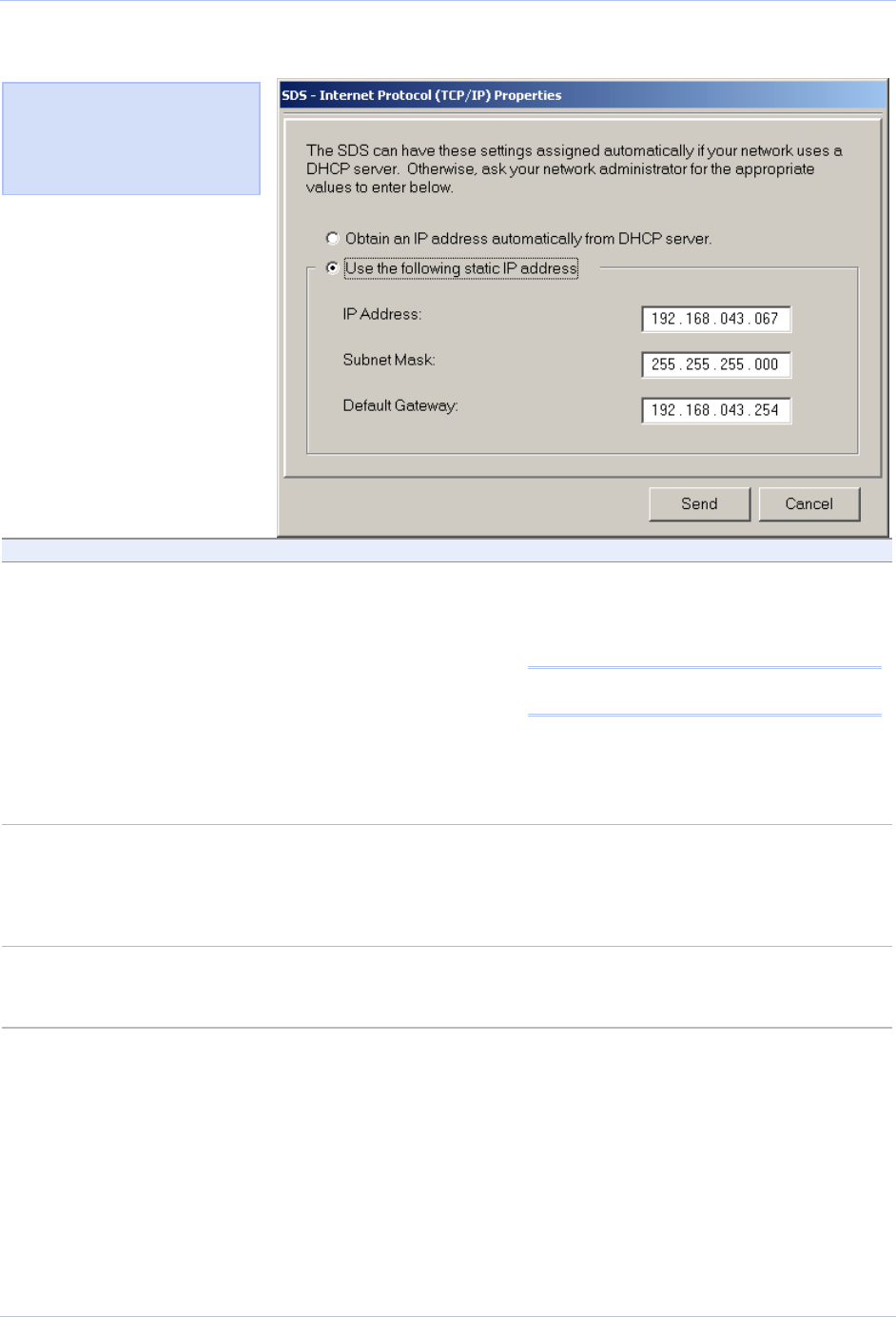
Installing the device drivers Quatech SDS User’s Manual
Page 22 Rev 1.50 (3/13/2005)
Figure 15 - Internet Protocol (TCP/IP) Properties dialog box
Step Procedure Description
Step 17 The Internet Protocol Properties (TCP/IP)
dialog box lets you change the SDS
configuration so that it can operate in its
permanent location.
Select one of the following options:
! Use the following static IP address.
! Obtain an IP address automatically
from the DHCP server.
If you are not sure of the configuration
parameters, consult your system
administrator.
Note: For reliable operation, we recommend
a static IP address.
Continue with □ Step 18.
Go to □ Step 19.
Step 18 Key in any necessary changes to the:
! IP address,
! Subnet mask, and
! Default gateway.
If you are not sure of the configuration
parameters, consult your system
administrator for the specific
parameters.
Step 19 Press Send to send your changes to the
SDS.
The Restart confirmation pop-up box
displays.
Continue with □ Step 20.
Figure 15 shows the current
configuration parameters for
the SDS. You can change these
parameters by keying in the
desired values.

Quatech SDS User’s Manual Installing the device drivers
Rev 1.50 (3/13/2005) Page 23
Figure 16 - Restart confirmation pop-up box
Step Procedure Description
Step 20 Press OK to restart the SDS and make
your changes active.
The SDS reboots and takes on the new
configuration. The Information pop-up
box displays. Continue with □ Step 21.
Figure 17 - Information pop-up box
Step Procedure Description
Step 21 When the Status light glows green, press
OK.
The glowing Status light indicates that
the SDS is ready. The TCP/IP Network
Configuration Parameters screen displays.
Continue with □ Step 22.
Figure 16 shows the Restart
confirmation pop-up box.
Figure 17 warns you that the
SDS needs time to reset. Wait
until the Status LED glows
green, and then press OK.
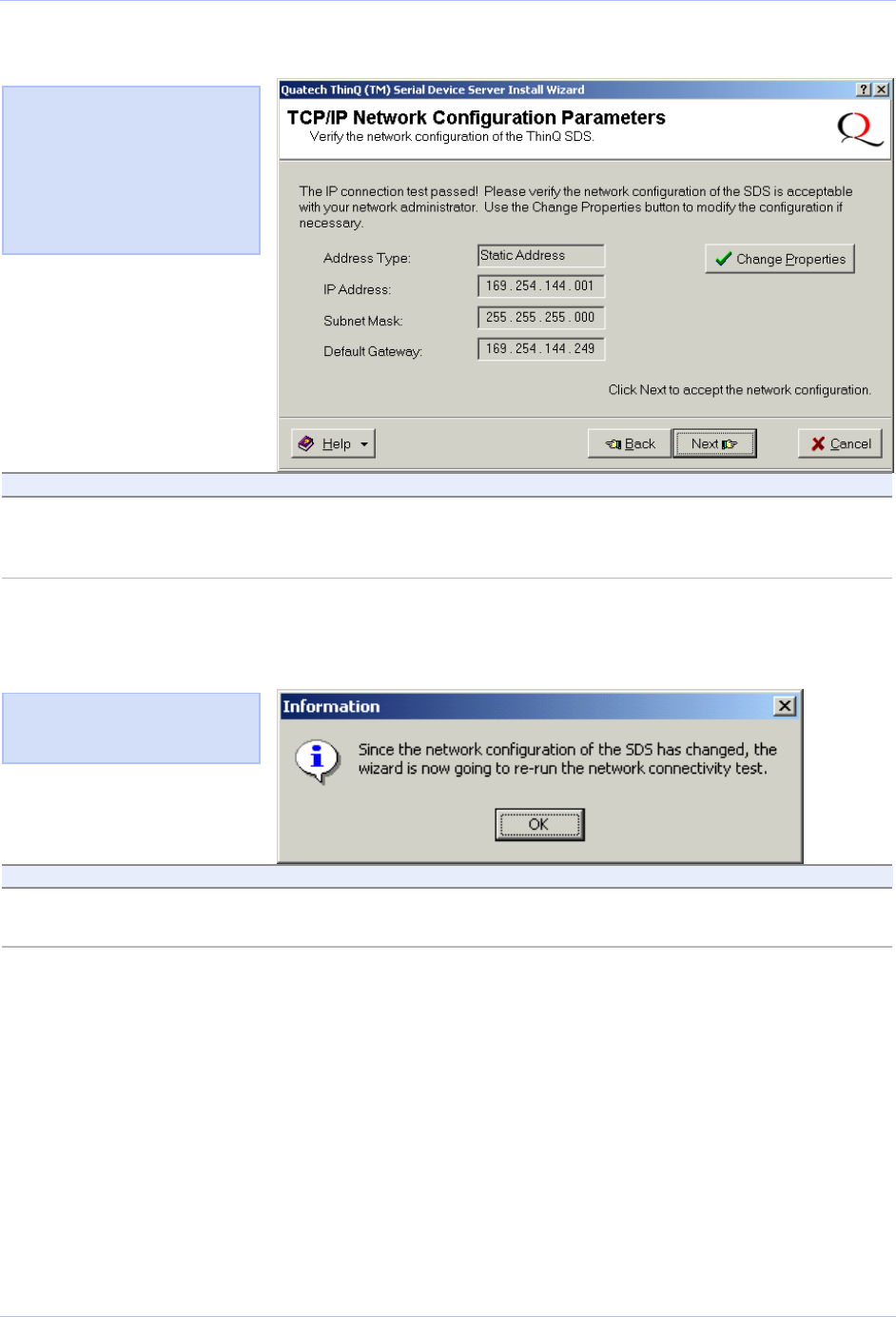
Installing the device drivers Quatech SDS User’s Manual
Page 24 Rev 1.50 (3/13/2005)
Figure 18 - TCP/IP Network Configuration Parameters screen
Step Procedure Description
Step 22 Press the Next button to continue. The Rerun network connectivity test pop-
up box displays.
Continue with □ Step 23.
Figure 19 - Rerun network connectivity test pop-up box
Step Procedure Description
Step 23 Press the OK button to continue. The Network Connectivity Test screen
displays. Continue with □ Step 24.
Figure 18 shows the TCP/IP
network configuration parameters
including the following:
! Address type
! IP Address
! Subnet mask
! Default gateway
Figure 19 shows the Rerun
network connectivity test pop-
up box.
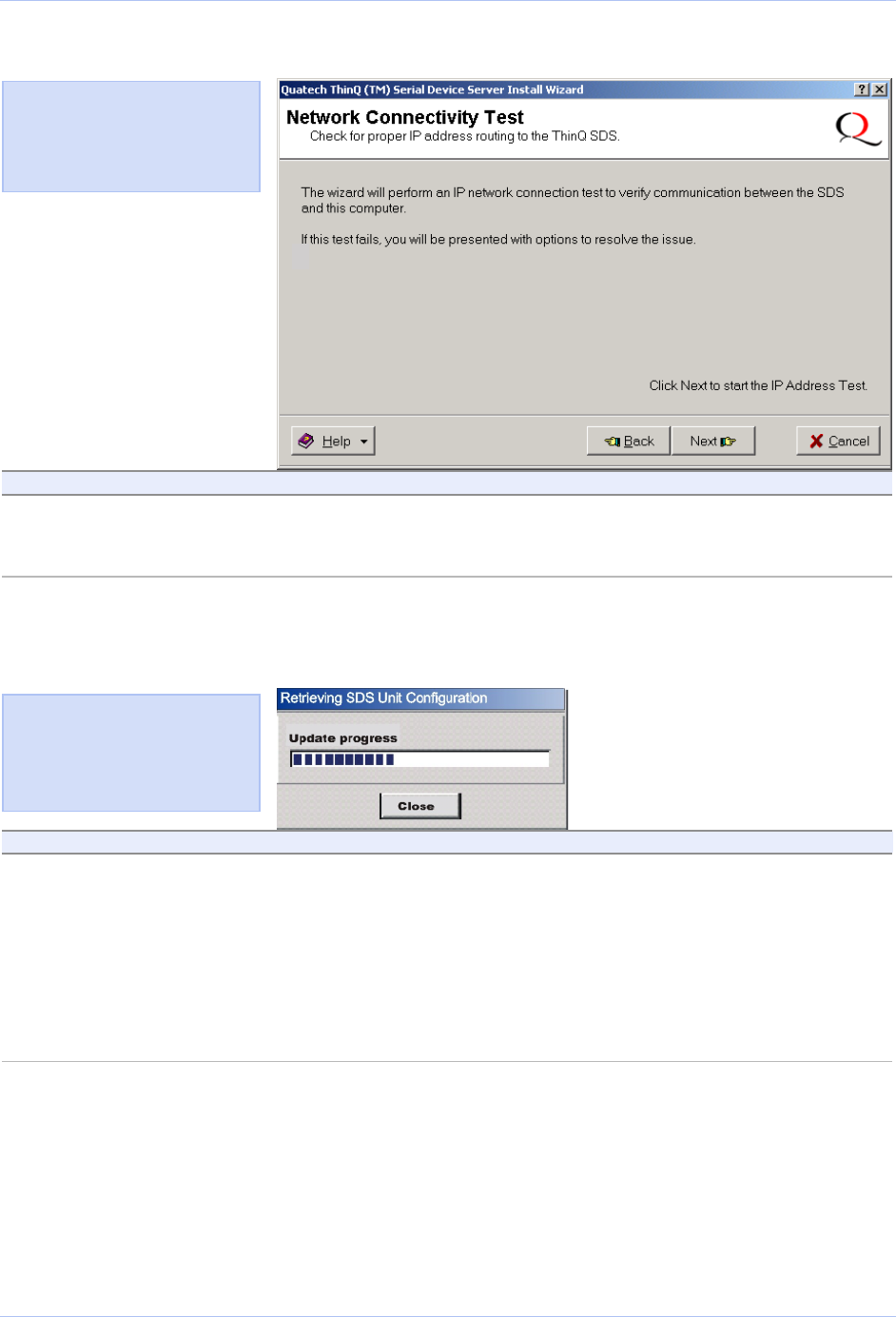
Quatech SDS User’s Manual Installing the device drivers
Rev 1.50 (3/13/2005) Page 25
Figure 20 - Network Connectivity Test screen
Step Procedure Description
Step 24 Press the Next button to run the IP
connectivity test.
The Retrieving Unit Configuration pop-
up box displays briefly.
Continue with □ Step 25.
Figure 21 - Retrieving Unit Configuration pop-up box
Step Procedure Description
Step 25 Depending on whether the test passes or
fails, one of two screens displays:
! TCP/IP Network Configuration
Parameters
! Network Connectivity Test Failed
If the test passes, the TCP/IP Network
Configuration Parameters screen
displays. Continue with □ Step 26.
If the test fails, the Network Connectivity
Test Failed screen displays.
Go to □ Step 55.
Figure 21 shows the Retrieving
Unit Configuration pop-up box.
This box shows the configuration
retrieval progress and closes
when it is complete.
Figure 20 shows the Network
Connectivity Test prompt. This
prompt informs you that the
Wizard is ready to check the IP
connectivity of the SDS.
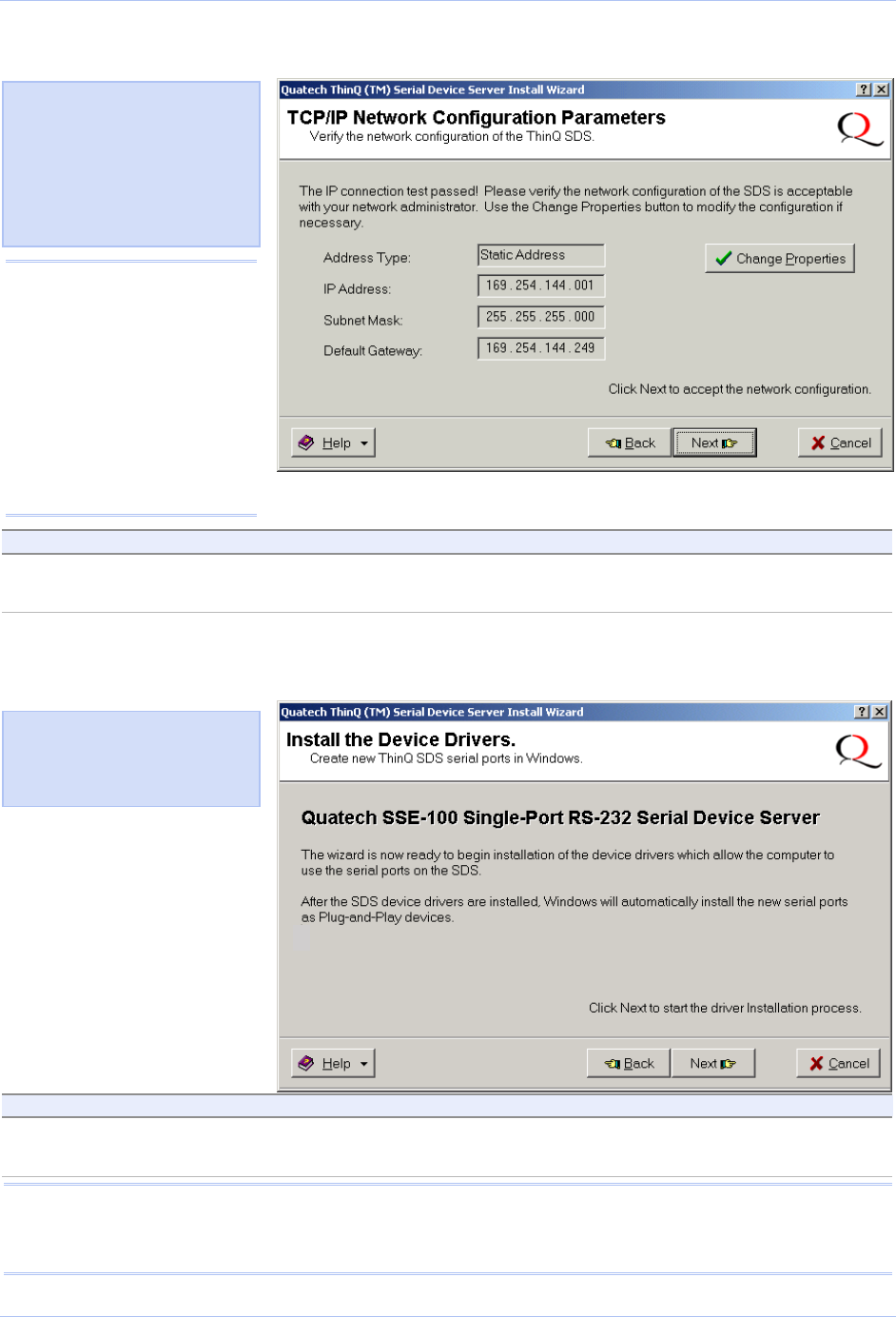
Installing the device drivers Quatech SDS User’s Manual
Page 26 Rev 1.50 (3/13/2005)
Figure 22 - TCP/IP Network Configuration Parameters screen
Step Procedure Description
Step 26 Press the Next button to continue. The Install the Device Drivers screen
displays. Continue with □ Step 27.
Figure 23 - Install the Device Drivers screen
Step Procedure Description
Step 27 Press the Next button to continue. The Installation Complete screen
displays. Continue with □ Step 28.
Note: If dialog boxes appear warning you that the SDS drivers are unsigned, please click through these
warnings and continue with the installation. Microsoft is currently evaluating the SDS drivers at their Windows
Hardware Quality Labs (WHQL). Once WHQL testing is completed, Quatech will make the signed drivers
available on our website.
Figure 23 informs you that the
Wizard is ready to install the
device driver(s) and create the
serial port(s).
Figure 22 shows the TCP/IP
network configuration parameters
including the following:
! Address type
! IP Address
! Subnet mask
! Default gateway
Caution! If your address
type is Dynamic, the Wizard
asks you to confirm that
you want the DHCP server
to assign the IP address for
your SDS. Be aware that if
your DHCP server is not
configured to assign the
same address to the SDS
every time, communication
with the SDS may fail should
the SDS ever be reset.

Quatech SDS User’s Manual Installing the device drivers
Rev 1.50 (3/13/2005) Page 27
Figure 24 - Installation Complete screen
Step Procedure Description
Step 28
Win 2000/XP
(Optional) Click on the Open Windows
Device Manager link to open the Device
Manager panel.
Click Finish to close the Installation
Wizard.
Expand the Multi-port serial adapters.
Right-click the Quatech Device Server
and select Properties. Click on the
HTTP Connect button to launch the
SDS Web interface.
The Installation Complete screen closes.
Windows briefly displays a Found New
Hardware pop-up screen as it installs
each serial port on the SDS. Your SDS
installation is complete!
Step 28
Win NT
Win NT, only:
Click Finish to launch the Quatech
Device Manager Installation Wizard.
The wizard installs Quatech’s Device
Manager. Follow the prompts.
Step 29
Win NT
Win NT, only:
Click Finish on the Installation Complete
screen when the Device Manager
installation is finished.
The SDS installation wizard closes.
Your SDS installation is complete!
Note: You may see a warning to reboot your
machine. Do not reboot until the installation
is completely finished. Note also that there
is no need to reboot your machine after
installing the first SDS. Only subsequent
installations require rebooting.
Figure 24 illustrates the
Installation Complete screen.
Note: This screen provides a
link to Windows Device
Manager where you can view
or change the SDS configuration
parameters or uninstall the
SDS.
Hint: To open Device Manager
at a later time, select Settings
– Control Panel from the Start
menu. Open the System folder
and select the Device Manager
tab.

Installing the device drivers Quatech SDS User’s Manual
Page 28 Rev 1.50 (3/13/2005)
Win NT Device Manager
Windows NT does not provide a Device Manager; however, you can
use Quatech’s Device Manager to manage all the Quatech devices
installed on your machine. Double click the Device Manager (DM)
icon on your desktop to launch. Expand the Quatech Device Server
group at the bottom. Select your Device Server (SSE-x00, DSE-x00,
QSE-x00, or ESE-x00) and click Properties.
Four tabs display:
! General – information on device type, manufacturer, location, and
device status
! Driver – information on drivers used including location and
version
! Resources – COM port enumeration and first port number
! SDS Configuration – network information including MAS
address, IP address, subnet mask, and default gateway
The SDS Configuration tab will be the most useful to you. You can
differentiate between SDS units using the MAC address, which is
equivalent to the serial number. The IP number shows how this PC is
set up to talk to the SDS.
The Diagnostic Tools button runs a Ping test. Use the Web Interface
button to bring up the Web interface. See Configuring the SDS using
the Web interface on page 44 for details on using this interface.
Use the Advanced button to repair a broken connection. For instance,
if the SDS’ IP address changes and your DM can no longer find it, you
can search for the SDS and note its changed IP address.
Win NT – Changing port numbers
Click on the first port to see its designated port number. You can use
the DM to change the port numbers if necessary. Changing the first
port causes the others to change sequentially. See page 44 for details.
Uninstalling your SDS
Uninstalling from Windows XP/2000
Follow these steps in the event that you need to uninstall or reinstall
the SDS software on a Windows XP or 2000 system.
1. From the Control Panel, select System.
2. Click on the Hardware tab.
3. Click on Device Manager.
4. Expand Multi-port serial adapters and select your Quatech
Device Server (SSE-x00, DSE-x00, QSE-x00, or ESE-x00).
5. Right click and select Uninstall.
Note: Use the Device Manager
only to make changes to PC-
related settings, such as port
numbers. Any settings related
to the SDS, such as IP address,
should be made only through
the Web interface.
Note: Remember, only use the
Web interface to make changes
to the SDS configuration.

Quatech SDS User’s Manual Installing the device drivers
Rev 1.50 (3/13/2005) Page 29
6. At the Confirmation screen, click OK.
7. Click Finish at the Completing the Add/Remove Hardware
Wizard screen.
Uninstalling from Windows NT4
Follow these steps in the event that you need to uninstall the SDS on
a Windows NT4 system.
1. Click on Quatech Device Manager.
2. Expand the SDS devices and select your Quatech Device Server
(SSE-x00, DSE-x00, QSE-x00, or ESE-x00).
3. Click Remove at the bottom of the screen.
4. If desired, use Add/Remove programs to remove the Device
Manager.
5. Reboot your machine.
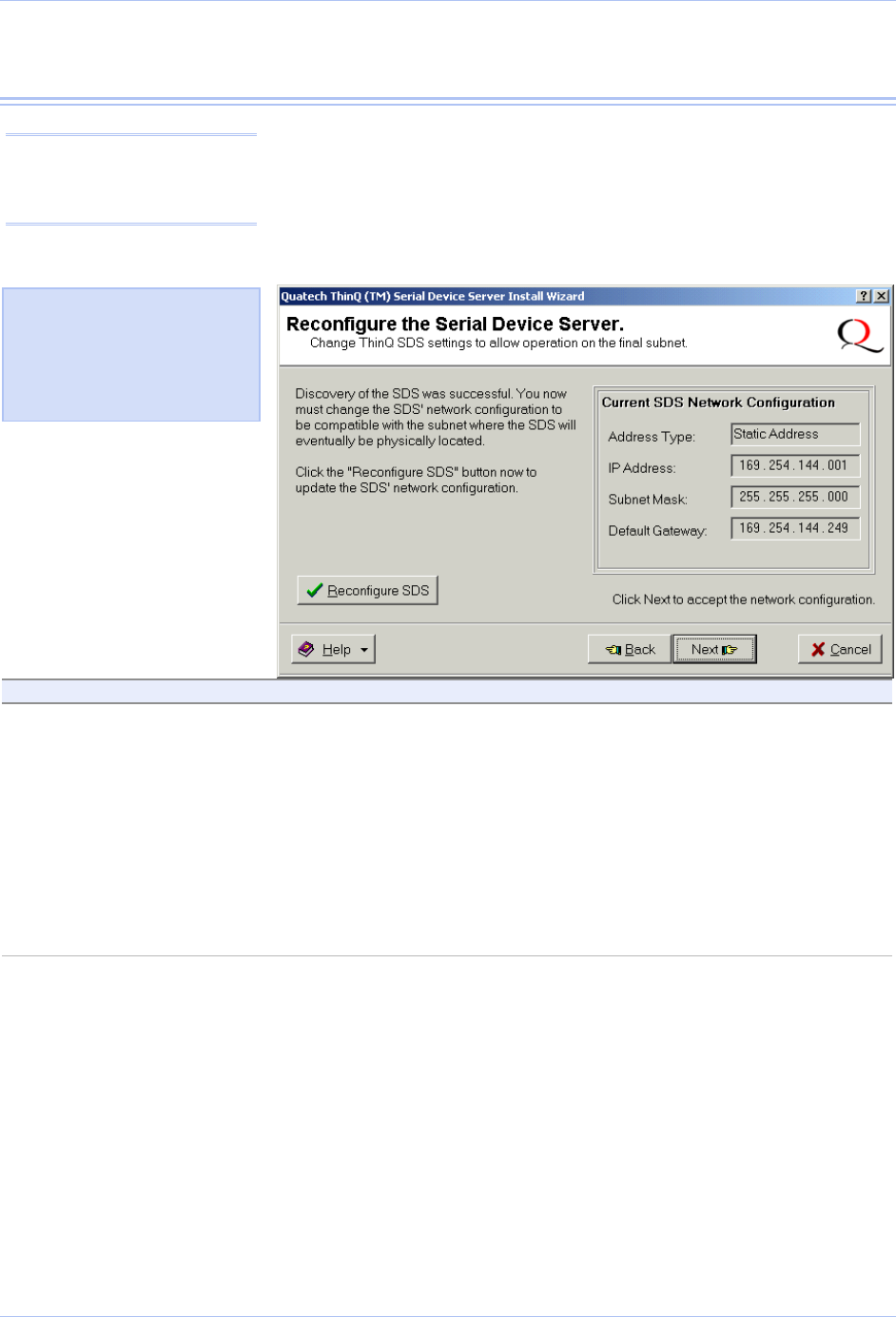
Installing the device drivers Quatech SDS User’s Manual
Page 30 Rev 1.50 (3/13/2005)
Alternative installation steps
This section supplements the basic installation procedure by taking
you through alternative installation scenarios. It then directs you to
the appropriate step in the basic procedure.
Figure 25 - Reconfigure the Serial Device Server screen
Step Procedure Description
Step 30 The Reconfigure the Serial Device Server
screen lets you change the SDS’
configuration so that it can operate in its
permanent location.
! If you do not need to change the
configuration, press the Next button
to continue.
! To change the configuration, click the
Reconfigure SDS button.
If your SDS is temporarily attached to
your computer’s NIC port, you may need
to attach it to a different subnet when
you do a permanent installation.
The Serial Device Server is Configured
for a Remote Subnet screen displays.
Continue with □ Step 31.
The Internet Protocol (TCP/IP)
Properties dialog box displays.
Go to □ Step 32.
Figure 25 shows the current
configuration parameters for
the SDS. You can accept these
parameters by pressing Next or
you can change them by
pressing Reconfigure SDS.
Note: This section has steps
that are used less frequently
than those in the preceding
section.
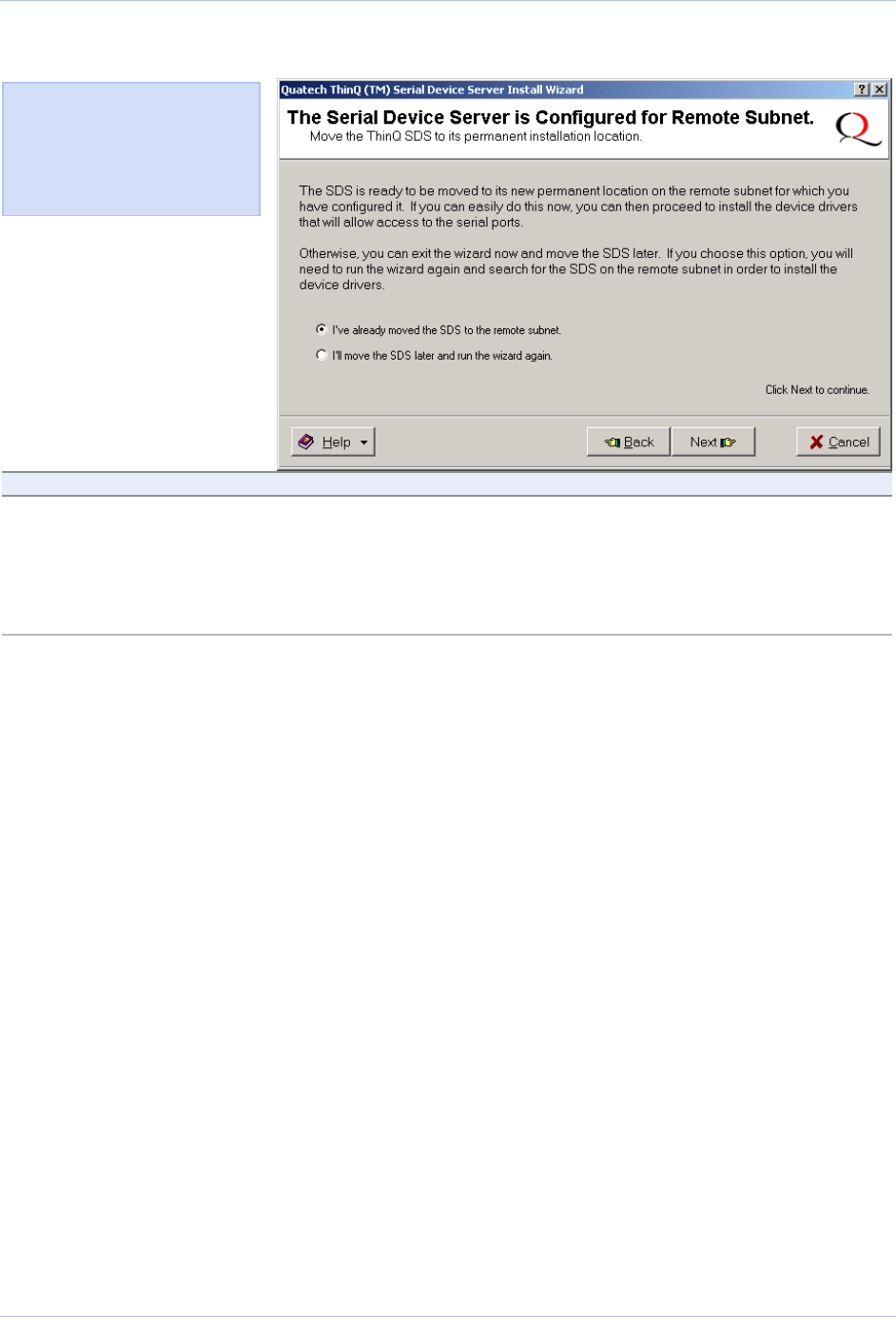
Quatech SDS User’s Manual Installing the device drivers
Rev 1.50 (3/13/2005) Page 31
Figure 26 - Serial Device Server is Configured for a Remote Subnet
Step Procedure Description
Step 31 Select one of the following options:
! I’ve already moved the SDS to the
remote subnet. Press Next to continue.
! I’ll move the SDS later and run the
wizard again. Press Next to continue.
The Network Connectivity Test screen
displays. Go to □ Step 14.
The Wizard closes and returns you to the
desktop.
Figure 26 allows you either to
move the SDS to its permanent
subnet location and continue
the installation or to exit the
wizard and install the SDS at
a later time.
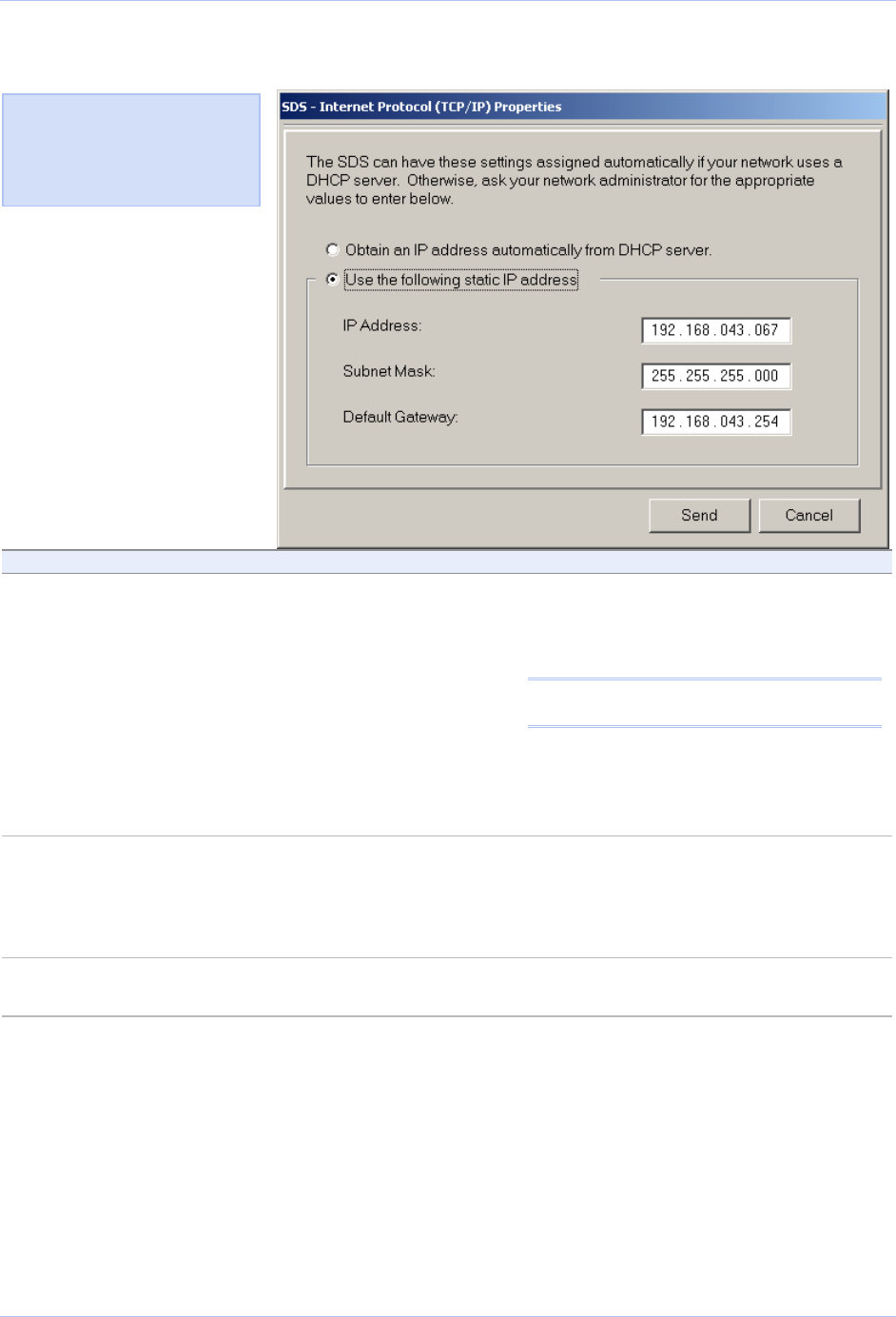
Installing the device drivers Quatech SDS User’s Manual
Page 32 Rev 1.50 (3/13/2005)
Figure 27 - Internet Protocol (TCP/IP) Properties dialog box
Step Procedure Description
Step 32 The Internet Protocol (TCP/IP) Properties
dialog box lets you change the SDS’
configuration so that it can operate in its
permanent location.
Select one of the following options:
! Use the following static IP address.
! Obtain an IP address automatically
from the DHCP server.
If you are not sure of the configuration
parameters, consult your system
administrator.
Note: We recommend that you use a static
IP address to ensure reliable operation.
Continue with □ Step 33.
Go to □ Step 34.
Step 33 Key in any necessary changes to the:
! IP address,
! Subnet mask, and
! Default gateway.
Your system administrator can provide
you with specific parameters.
Step 34 Press Send to send your changes to the
SDS.
The Restart confirmation pop-up box
displays. Continue with □ Step 35.
Figure 27 shows the current
configuration parameters for
the SDS. You can change these
parameters by keying in the
desired values.
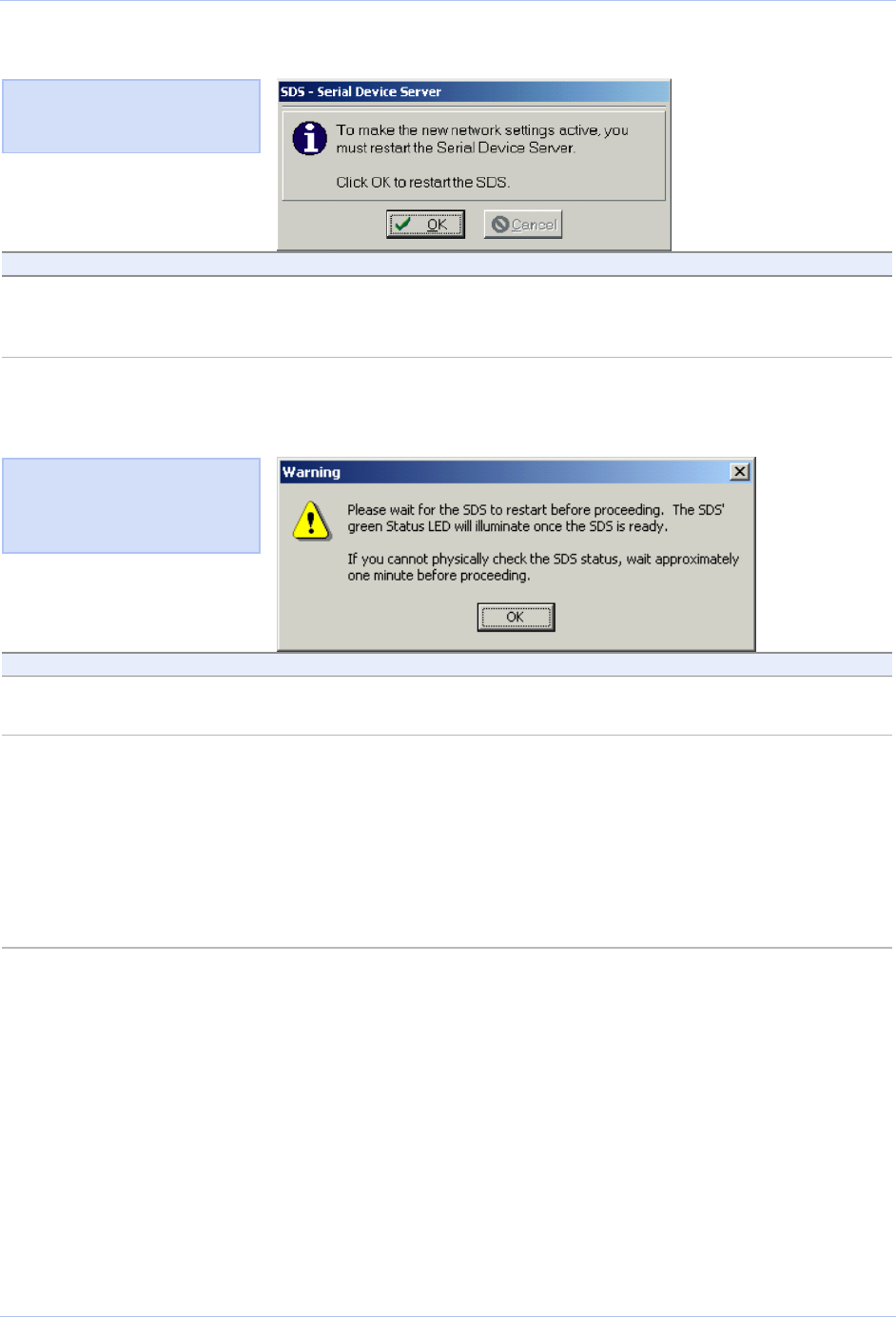
Quatech SDS User’s Manual Installing the device drivers
Rev 1.50 (3/13/2005) Page 33
Figure 28 - Restart confirmation pop-up box
Step Procedure Description
Step 35 Press OK to restart the SDS and make
your changes active.
The SDS reboots and takes on the new
configuration. The Information pop-up
box displays. Continue with □ Step 36.
Figure 29 - Information pop-up box
Step Procedure Description
Step 36 When the Status light glows green, press
OK.
This indicates that the SDS is ready.
Continue with □ Step 37.
Step 37 Depending on your path to this step, one
of three possible screens will display:
! TCP/IP Network Configuration
Parameters
! Reconfigure the Serial Device Server
! SDS Wizard Information
Continue with □ Step 38.
Go to □ Step 30.
Go to □ Step 41.
Figure 28 shows the Restart
confirmation pop-up box.
Figure 29 warns you that the
SDS needs time to reset. Wait
until the status LED glows
green before pressing OK.
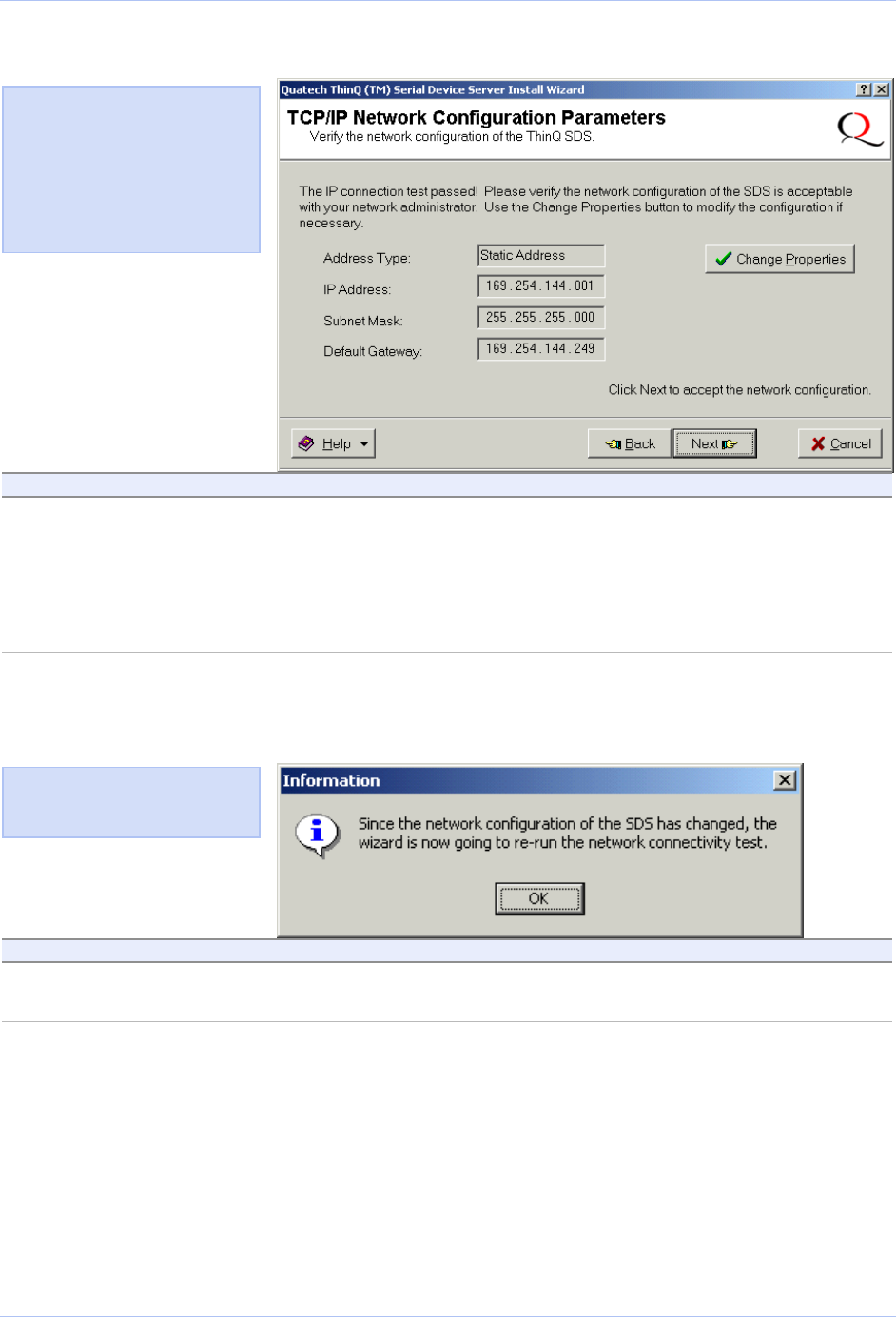
Installing the device drivers Quatech SDS User’s Manual
Page 34 Rev 1.50 (3/13/2005)
Figure 30 - TCP/IP Network Configuration Parameters screen
Step Procedure Description
Step 38 If you are satisfied with the parameters,
press Next to continue.
If you are not satisfied, press Change
Properties to change the TCP/IP
properties.
The Rerun network connectivity test pop-
up box displays.
Continue with □ Step 39.
The Internet Protocol (TCP/IP)
Properties dialog box displays.
Go to □ Step 32.
Figure 31 - Rerun network connectivity test pop-up box
Step Procedure Description
Step 39 Press OK. The Network Connectivity Test screen
displays. Go to □ Step 14.
Figure 30 shows the TCP/IP
network configuration parameters
including the following:
! Address type
! IP Address
! Subnet mask
! Default gateway
Figure 31 shows the Rerun
network connectivity test pop-
up box.

Quatech SDS User’s Manual Installing the device drivers
Rev 1.50 (3/13/2005) Page 35
Figure 32 - DHCP confirmation pop-up box
Step Procedure Description
Step 40 Press Yes to have the DHCP server assign
the IP address only if you are sure it will
assign the same IP address each time.
Otherwise, press No.
If you answer Yes, the DHCP server will
assign the IP address for your SDS. If
this address changes, communication
with the SDS may fail. The SDS
Wizard Information DHCP screen
displays. Continue with □ Step 41.
If you answer No, you return to the
TCP/IP Network Configuration
Parameters screen. Go to □ Step 16.
Figure 33 - SDS Wizard Information DHCP screen
Step Procedure Description
Step 41 Press the Next button. The Search network for Serial Device
Servers screen displays.
Go to □ Step 10.
Figure 32 shows DHCP server
confirmation pop-up box. Only
answer Yes if you are sure that
the DHCP server will always
assign the same IP address to
the SDS.
Figure 33 informs you that the
Wizard going to search for the
SDS using the last known IP
parameters.
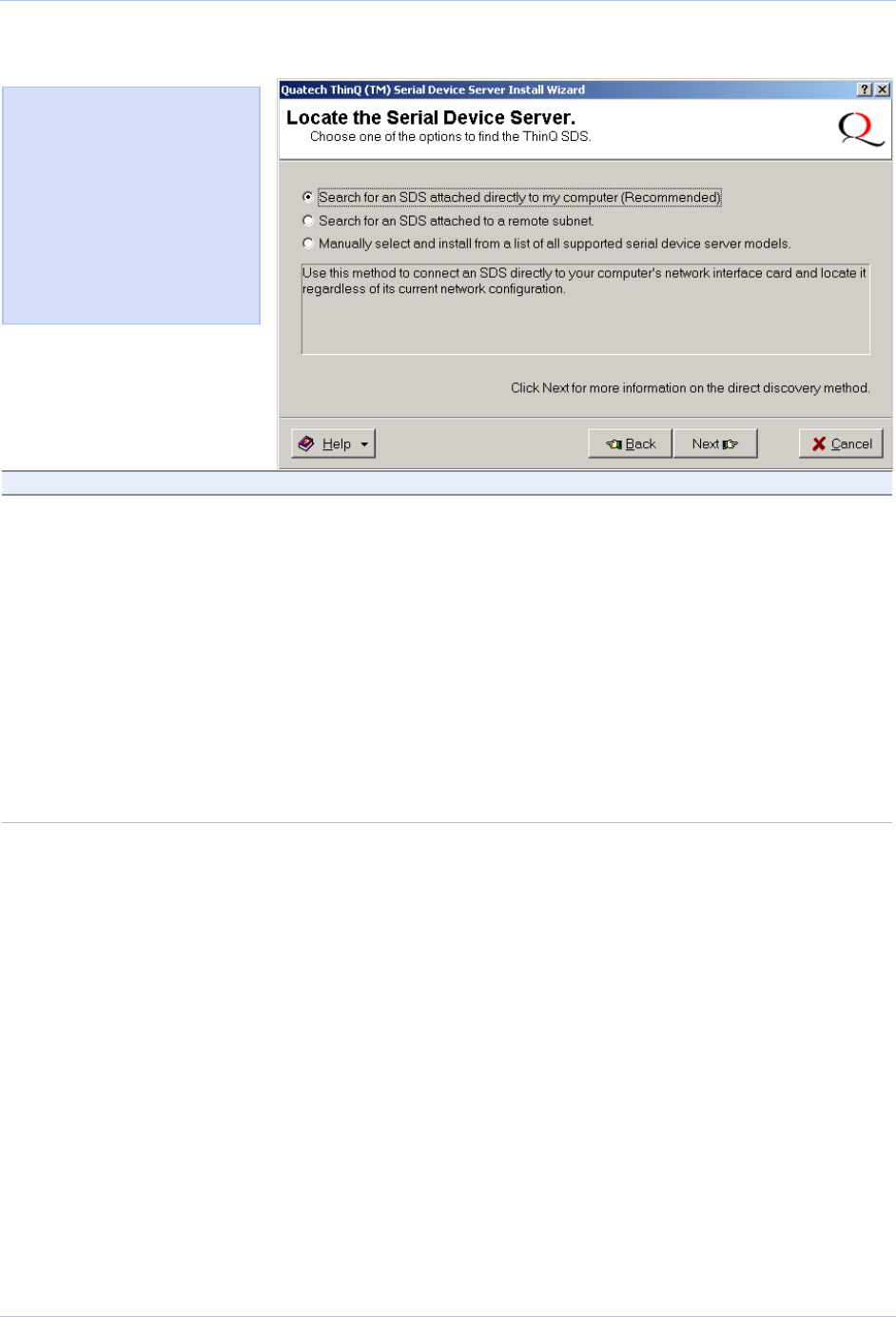
Installing the device drivers Quatech SDS User’s Manual
Page 36 Rev 1.50 (3/13/2005)
Figure 34 - Locate the Serial Device Server screen
Step Procedure Description
Step 42 Select one of the following options:
! Search for an SDS attached directly to
my computer (Recommended).
Press Next to continue.
! Search for an SDS attached to a
remote subnet.
Press Next to continue.
! Manually select and install from a list
of all supported serial device server
models.
Press Next to continue.
The Locate the Serial Device Server
using direct discovery screen displays.
Continue with □ Step 43.
The Locate the Serial Device Server on a
remote subnet screen displays.
Go to □ Step 45.
The Select Desired Serial Device Server
from list screen displays.
Go to □ Step 53.
Figure 34 offers you three
options to locate your new
SDS:
! Find an SDS that is plugged
directly into your computer’s
NIC using a crossover cable.
! Find an SDS that is attached to
a remote subnet.
! Select your SDS model from a
list of all supported serial
device servers.

Quatech SDS User’s Manual Installing the device drivers
Rev 1.50 (3/13/2005) Page 37
Figure 35 - Locate the Serial Device Server using direct discovery screen
Step Procedure Description
Step 43 Connect the Ethernet port on your SDS to
the Network Interface Connection (NIC)
on your computer using an Ethernet
crossover patch cable.
Continue with □ Step 44.
Step 44 Connect power to the SDS and confirm
that it is ready to proceed.
Press Next to continue.
The Status LED should glow green.
The Search network for Serial Device
Drivers screen displays.
Go to □ Step 10.
Figure 35 explains how to
connect the SDS to your
computer for location and
configuration purposes.
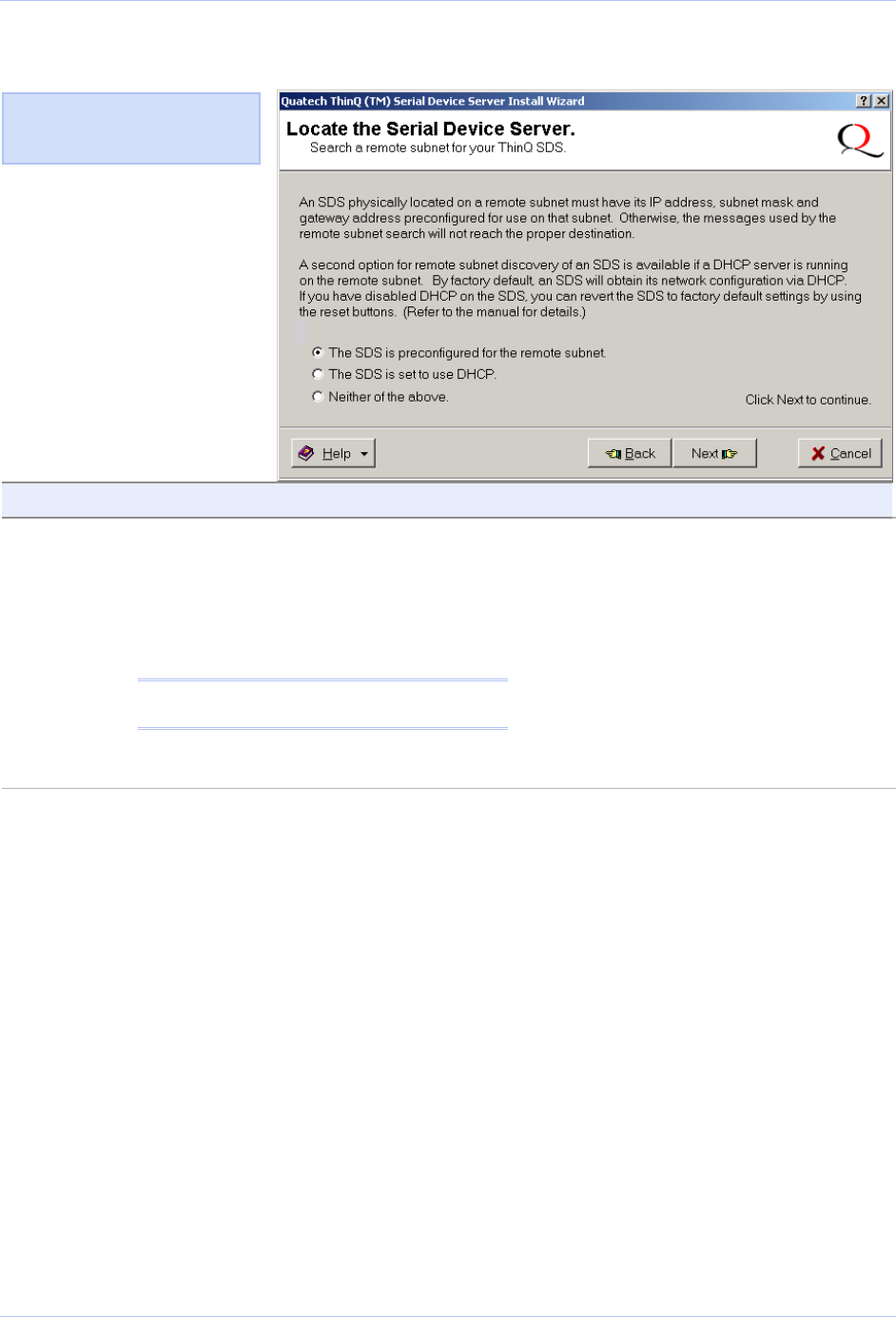
Installing the device drivers Quatech SDS User’s Manual
Page 38 Rev 1.50 (3/13/2005)
Figure 36 - Locate the Serial Device Server on a remote subnet screen
Step Procedure Description
Step 45 Select one of the three following options:
! The SDS is preconfigured for the
remote subnet.
Press Next to continue.
! The SDS is set to use DHCP.
Press Next to continue.
Note: If DHCP is disabled on the SDS, press
the Reset button on the back to enable it.
! Neither of the above.
Press Next to continue.
The Describe the Remote Subnet screen
displays. Continue with □ Step 46.
The Describe the Remote Subnet screen
displays. Continue with □ Step 46.
The Locate the Serial Device Server
screen displays. Go to □ Step 48.
Figure 36 explains the options
you have to search for an SDS
on a remote subnet.
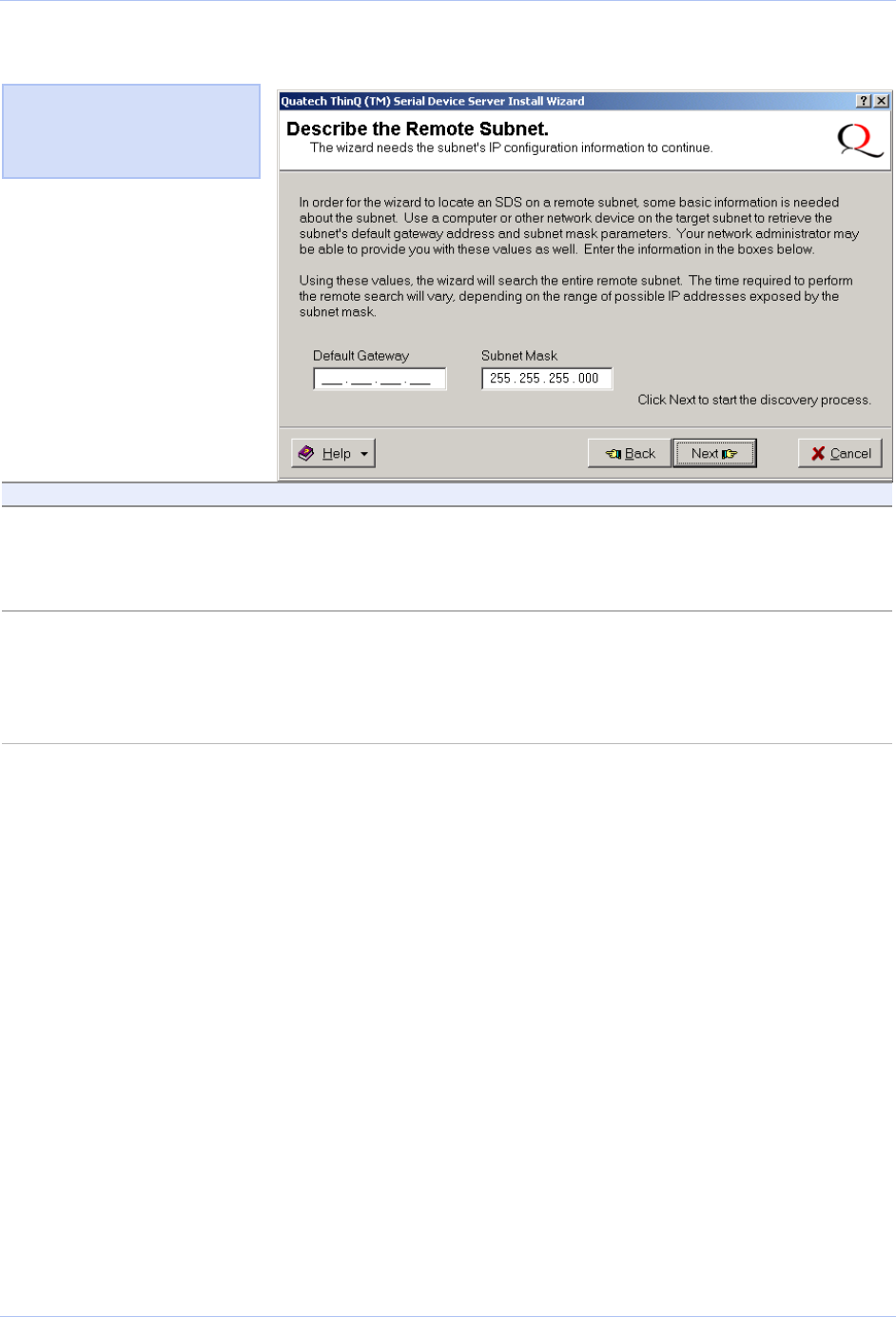
Quatech SDS User’s Manual Installing the device drivers
Rev 1.50 (3/13/2005) Page 39
Figure 37 - Describe the Remote Subnet screen
Step Procedure Description
Step 46 Locate the target subnet’s default
gateway address.
You can get this address from a device
already on the target subnet. Your
system administrator should also be
able to provide this information.
Step 47 Enter the target subnet’s default gateway
address in the space provided.
Press Next to continue.
The Wizard initiates a search of the
specified target subnet.
The Search network for Serial Device
Servers screen displays.
Go to □ Step 10.
Figure 37 explains how to
gather the information you
need to search for your SDS on
a remote subnet.
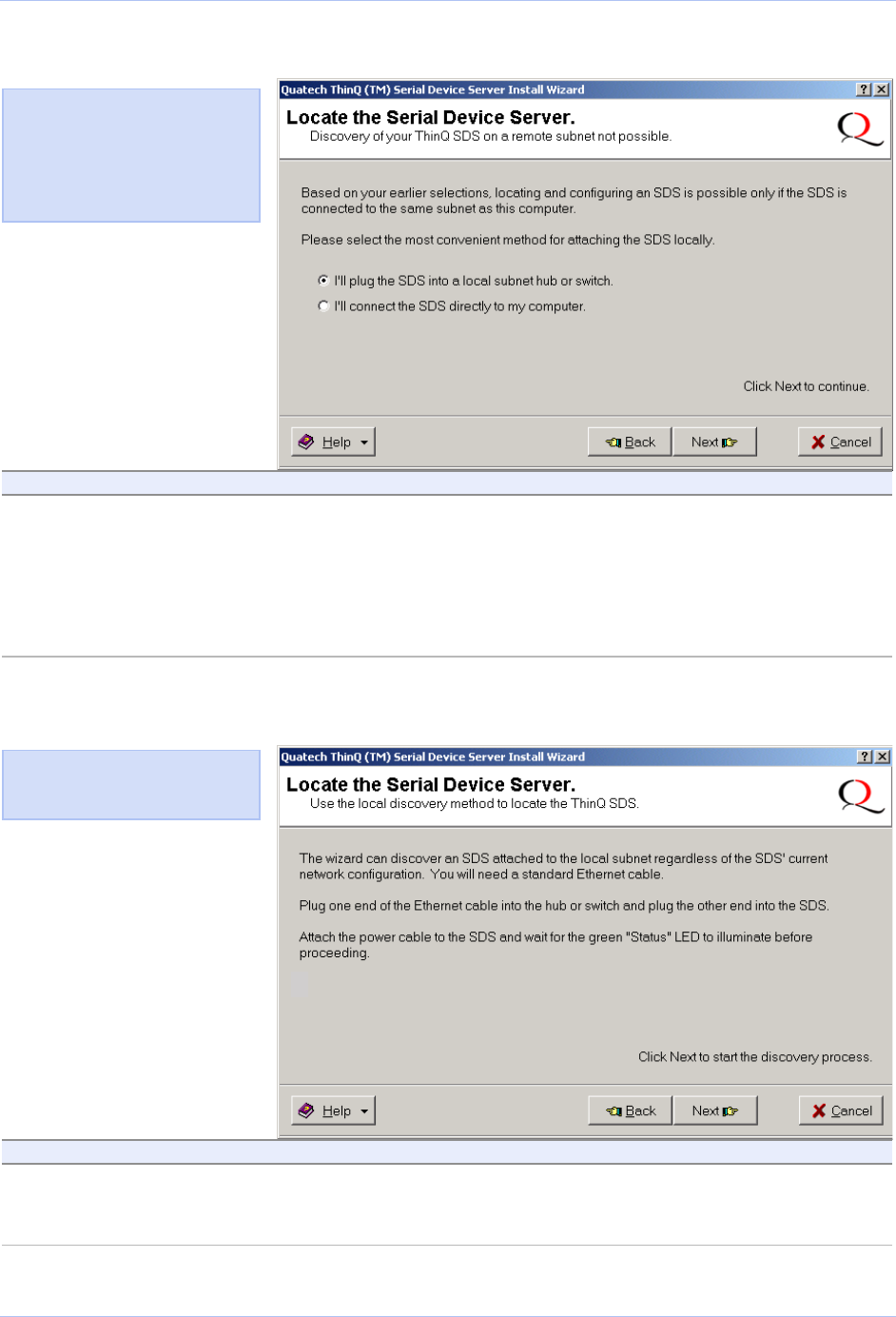
Installing the device drivers Quatech SDS User’s Manual
Page 40 Rev 1.50 (3/13/2005)
Figure 38 - Locate the Serial Device Server options screen
Step Procedure Description
Step 48 Select one of two options:
! I’ll plug the SDS unit into a local
subnet hub or switch. Press Next to
continue.
! I’ll connect the SDS directly to my
computer. Press Next to continue.
The Locate the Serial Device Server local
discovery screen displays. Continue
with □ Step 49.
The Locate the Serial Device Server
screen displays. Go to □ Step 43.
Figure 39 - Locate the Serial Device Server local discovery screen
Step Procedure Description
Step 49 Connect the SDS to a local hub or switch. Use a standard Ethernet cable to connect
the Ethernet port on the SDS to the hub
or switch. Continue with □ Step 50.
Figure 39 illustrates the Locate
the Serial Device Server local
discovery prompt.
Figure 38 illustrates the
Locate the Serial Device Server
screen. You can either connect
the SDS to a local hub or
switch or you can connect it
directly to your computer.

Quatech SDS User’s Manual Installing the device drivers
Rev 1.50 (3/13/2005) Page 41
Step Procedure Description
Step 50 Connect power to the SDS. Connect the cable attached to the power
source to the SDS. Plug the connector of
the unattached power cable into the
power source’s socket. Plug the other end
of the cable into a power outlet. The SDS
powers up.
Step 51 Confirm that the SDS is ready to proceed. The Status LED to the left of the power
jack should glow green and the Power
LED should glow blue.
Step 52 Click the Next button to continue. The Search network for Serial Device
Servers screen displays and the Wizard
searches the local subnet for active serial
device servers. Go to □ Step 10.
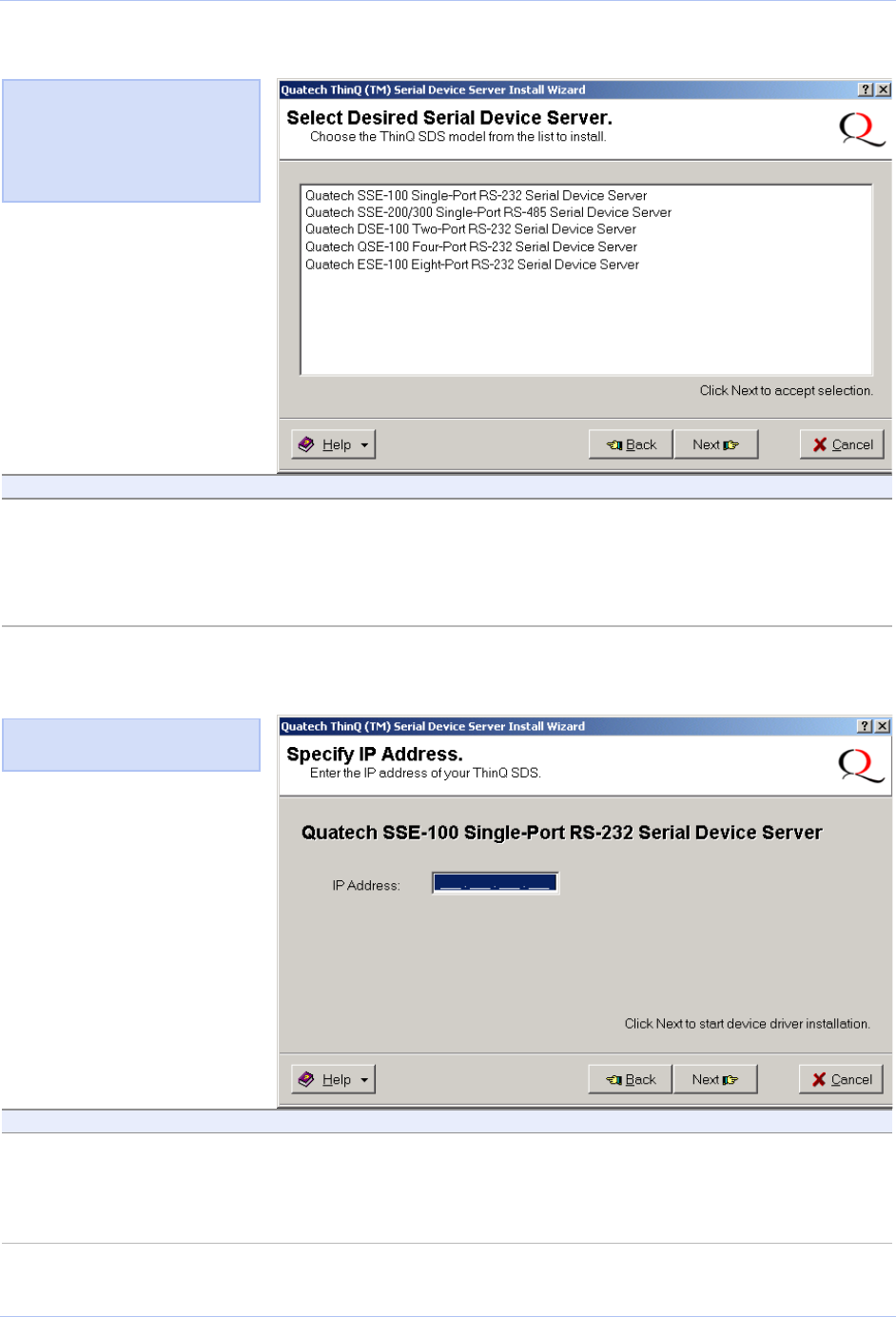
Installing the device drivers Quatech SDS User’s Manual
Page 42 Rev 1.50 (3/13/2005)
Figure 40 - Select Desired Serial Device Server from list screen
Step Procedure Description
Step 53 Locate and highlight your SDS device.
Press the Next button to continue.
This screen shows a complete list of all
currently available Quatech device
servers.
The Specify IP Address screen displays.
Continue with □ Step 54.
Figure 41 - Specify IP Address screen
Step Procedure Description
Step 54 Enter the IP address for your SDS in the
box provided.
Press the Next button to continue.
If you are not sure of the IP address, see
your system administrator.
The Install the Device Drivers screen
displays. Go to □ Step 27.
Figure 41 prompts you for the
IP address of your SDS.
Figure 40 shows a complete
list of all the Quatech serial
device servers. This list will
change as the SDS family
grows.
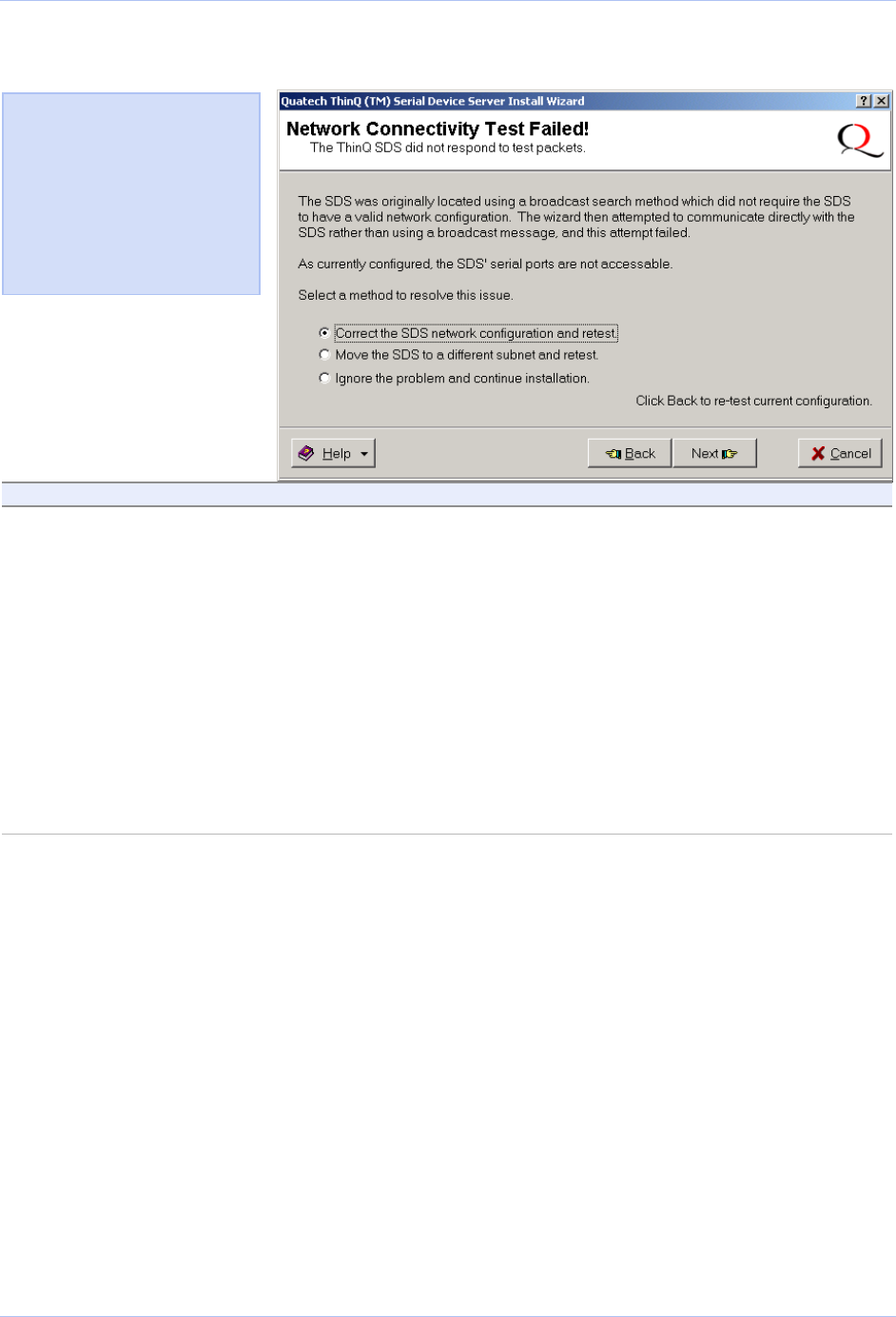
Quatech SDS User’s Manual Installing the device drivers
Rev 1.50 (3/13/2005) Page 43
Figure 42 - Network Connectivity Test Failed screen
Step Procedure Description
Step 55 Select one of the following options:
! Correct the SDS network
configuration and retest. Press Next to
continue.
! Move the SDS to a different subnet
and retest. Press Next to continue.
! Ignore the problem and continue
installation. Press Next to continue.
Click Back to retest current configuration.
If you are not sure of the configuration
parameters, consult your system
administrator. The Internet Protocol
(TCP/IP) Properties dialog box displays.
Go to □ Step 32.
Check with your system administrator
for the subnet address. The Locate the
Serial Device Server on remote subnet
screen displays. Go to □ Step 45.
The TCP/IP Network Configuration
Parameters screen displays.
Go to □ Step 16.
Figure 42 displays when the IP
connection test fails. It presents
you with these three options:
! Change the SDS’ IP
configuration and retest
! Move the SDS to a different
location and retest
! Ignore the problem and
continue installing

Configuring the SDS using a Web interface Quatech SDS User’s Manual
Page 44 Rev 1.50 (3/13/2005)
Configuring the SDS using the Web interface
This section explains how to configure an SDS using a standard Web
browser so that it can communicate over a network with a serial
device.
After the installation program included on the SDS CD-ROM is
finished, the Device Server will be ready for use as configured. If you
wish to make changes to the configuration at a future time, it is a
simple matter of entering the IP address of the Device Server into the
address bar of your computer’s Web browser.
Quatech recommends the use of Microsoft’s Internet Explorer for
accessing the Web browser-based configuration utilities built into our
Device Servers. Other browsers can be used but be aware that we
have not tested the many alternative browsers available, so some
graphics and page formatting could be misaligned.
The SDS stores its configuration in nonvolatile memory (Flash),
which is retained even when the unit is turned off.
Once you have installed the drivers on your computer and established
an Ethernet connection with the SDS, you can maintain and configure
the SDS using a Web interface.
Using a Web interface, you can:
! Configure the network settings (static vs. DHCP; if static, you can
set the IP address, Gateway address, and Address mask)
! View and set the serial port parameters (set per serial device
application; setup lets you set data rate multiplier, performance
mode, heartbeat timer, operating mode and operating mode settings)
! Perform diagnostic tests (Ping test, view port status list)
! Perform administrative functions (view, add, or remove users,
give the SDS a descriptive name, upgrade software, and perform
a remote reset)
! Contact Quatech corporate headquarters, sales, and technical
support
Follow these steps to manage your SDS using a Web interface.
Step Procedure Description
# Step 1 Open your Web browser. We recommend Internet Explorer 5.0 or
higher.
# Step 2 Type the IP address for the SDS in the
Web browser’s URL (address) field.
The format for an IP address is http://
followed by a series of numbers
separated by periods, such as
http://123.456.789.123.
The Quatech Serial Device Server Home
page displays.
Note: We have eliminated the
need to use console ports, DOS
shell commands, Telnet and
other complicated methods of
configuration. Just enter the IP
address after the HTTP://
prefix in your Web browser’s
Address bar, click Go, and you
are ready to reconfigure the
Device Server remotely!
Note: Wi-Fi units must have
their parameters configured
before they can communicate
wirelessly. See page 6 for Wi-Fi
information and page 14 for
configuration information.

Quatech SDS User’s Manual Configuring the SDS using a Web interface
Rev 1.50 (3/13/2005) Page 45
Figure 43 - Home page screen
Setting network parameters
Once you have made the initial network connection, you can maintain
and configure this connection using Quatech’s Web interface. Of course,
you can always go back and use the Installation Wizard to program the
settings for the SDS. Contact your network administrator if you are
unsure of any of these settings.
See Setting TCP/IP (LAN) and Wi-Fi (Wireless) parameters below or
see Setting SNMP parameters on page 49.
Setting TCP/IP (LAN) and Wi-Fi (Wireless) parameters
Step Procedure Description
# Preliminary
Step
Click on Network in the selection bar. The Network Setup screen shown on
the following page displays.
Figure 43 shows Quatech’s
Serial Device Server Home
page. From this screen, you
can:
! Access network settings
! Change serial port settings
! Run diagnostics
! Perform admin functions
! Contact Quatech
This screen shows you the
hardware revision level, the
SDS product description, and
the software revision level.
Note: If you inadvertently lose
contact with the SDS, use the
Installation Wizard to re-establish
contact.
Note: To setup for a Wireless
(Wi-Fi) SDS, you must first
connect to it using the wired
Ethernet mode. See Enabling
Wi-Fi Device Servers on page
14 for details.
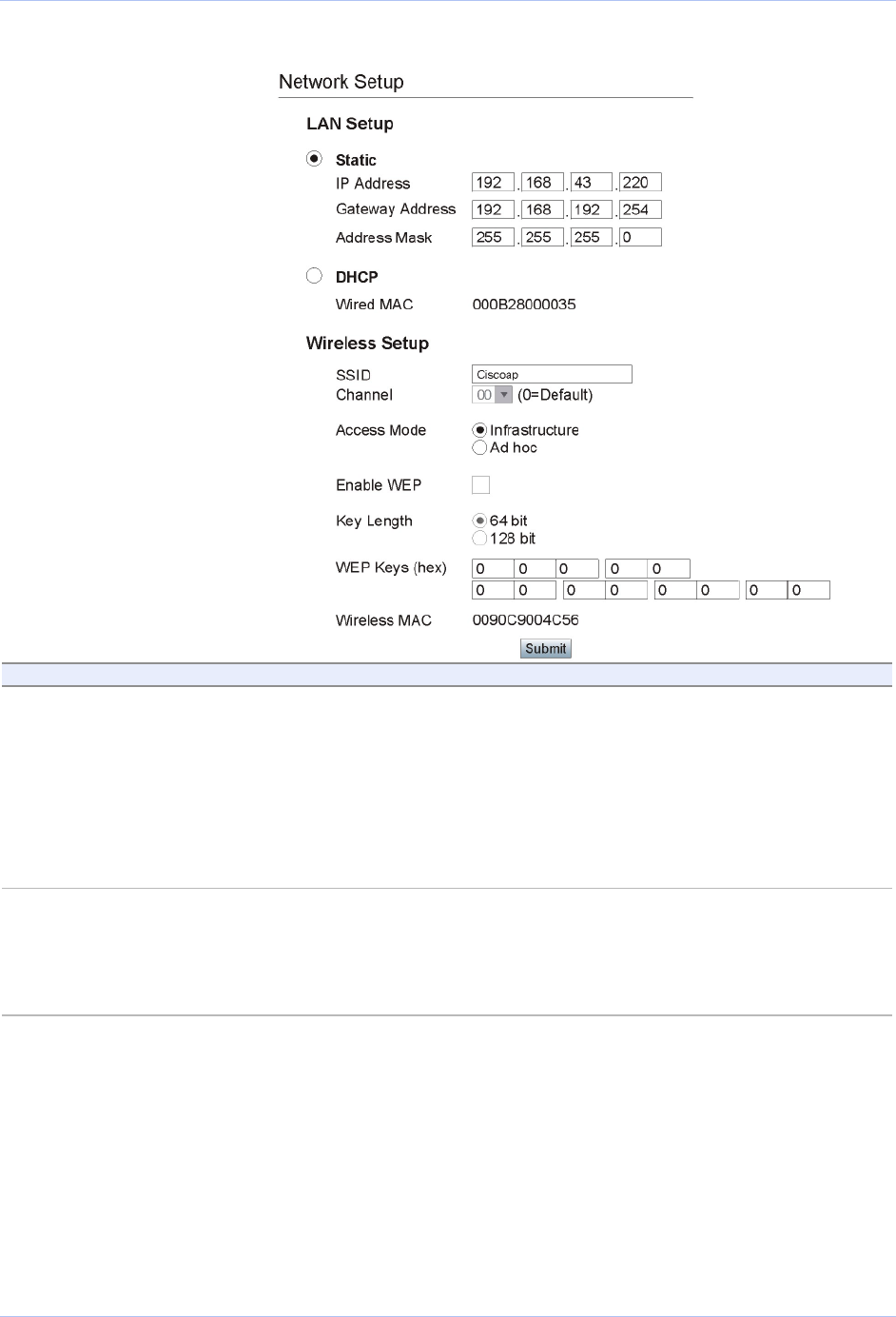
Configuring the SDS using a Web interface Quatech SDS User’s Manual
Page 46 Rev 1.50 (3/13/2005)
Figure 44 - Network Setup screen
Step Procedure Description
# Step 1 Select between a Static IP address and
one set by the DHCP server.
For Static only, set the IP address.
This must be a unique address in your
network. Only let the DHCP server set
the IP address if it is configured to
always assign the same address to the
SDS; otherwise, the connection will fail.
Note that the SDS’ MAC address is
displayed. The MAC address is an
Ethernet serial number.
# Step 2 For Static only, set the Gateway IP
address.
The Gateway address must be within
your local network. It should be the
same as the IP address for the router
that is connected to the same LAN
segment as the SDS.
# Step 3 For Static only, set the Address mask. The Address mask is a string of 0's and
1's that screens out the network part of
an IP address so that only the host
computer part remains. Most people
select the Class C Address mask.
! Class A: 24 bits
! Class B: 16 bits
! Class C: 8 bits

Quatech SDS User’s Manual Configuring the SDS using a Web interface
Rev 1.50 (3/13/2005) Page 47
Step Procedure Description
Table 8 - Class A, B, and C address masks
Class Host bits visible Address mask
A 24 255.0.0.0
B 16 255.255.0.0
C 8 255.255.255.0
Table 9 - Complete list of address masks
Address mask Host bits
255.255.255.252 2
255.255.255.248 3
255.255.255.240 4
255.255.255.224 5
255.255.255.192 6
255.255.255.128 7
255.255.255.0 8
255.255.254.0 9
255.255.252.0 10
255.255.248.0 11
255.255.240.0 12
… …
255.255.0.0 16
255.254.0.0 17
… …
255.128.0.0 23
255.0.0.0 24
# Step 4 For Wired Setup, go to □ Step 11.
For Wireless Setup, continue with
□ Step 5.
Before the SDS can communicate on an
802.11b wireless network, the WLAN
settings must match the wireless
network. By default, the SDS is set to
Infrastructure network mode and its
SSID, which is its wireless Network
Name, is blank. This allows it to connect
to any available wireless network.
# Step 5 Configure the SSID (network name).
The Service Set Identifier (SSID) is the
name assigned to your wireless network.
All devices on a wireless network must
be configured with the same SSID.
# Step 6 Select the Access Mode.
! Infrastructure (using the access point)
If using Infrastructure mode,
go to □ Step 8.
! Ad hoc (no access point)
If using Ad hoc mode,
continue with □ Step 7.
In Infrastructure mode, an AP bridges
or joins a wireless network (WLAN) to a
wired Ethernet network (LAN).
Ad hoc is a wireless communication
mode that allows all wireless devices
within range of each other to discover
and communicate with one another

Configuring the SDS using a Web interface Quatech SDS User’s Manual
Page 48 Rev 1.50 (3/13/2005)
Step Procedure Description
without involving central access points.
Devices communicating in ad hoc mode
do so in peer-to-peer fashion. All wireless
adapters on the ad-hoc network must
use the same SSID and the same
channel number.
# Step 7 For Ad hoc only, configure the Channel. As with the SSID, devices sharing a
wireless link must be tuned to the same
channel.
Note: The Channel setting is only used in
Ad hoc mode. In Infrastructure mode, the
access point (AP) determines which channel
all devices associated with it must use.
# Step 8 Enable or disable WEP.
! Select the Enable WEP checkbox to
enable WEP. Continue with □ Step 9.
! Clear the checkbox to disable WEP.
Go to □ Step 11.
An optional security protocol for wireless
local area networks, WEP provides
security by encrypting data over radio
waves so that it is protected as it is
transmitted from the SDS to the AP.
# Step 9 Select the Key Length.
! 64 bit
! 128 bit
Sets the WEP key length to be used.
Selecting 64 bit activates the top row of
hex number boxes.
Selecting 128 bit activates both rows.
# Step 10 Enter the WEP Keys in hex. These are two digit hex values that will
be used for the WEP keys. Valid
characters are 0-9, a, b, c, d, e, and f.
# Step 11 Press Submit to configure the SDS with
your settings.
Note: Press the browser’s Back button to make
no changes to the original settings.
The IP Address Update successful screen
displays. You must reset the SDS for
your changes to take effect.
If you press the browser’s Back button,
your original settings remain unchanged.
Figure 45 - IP Address Successful screen
Step Procedure Description
# Step 12 Click on the link to reset the SDS. The Remote Reset screen displays.
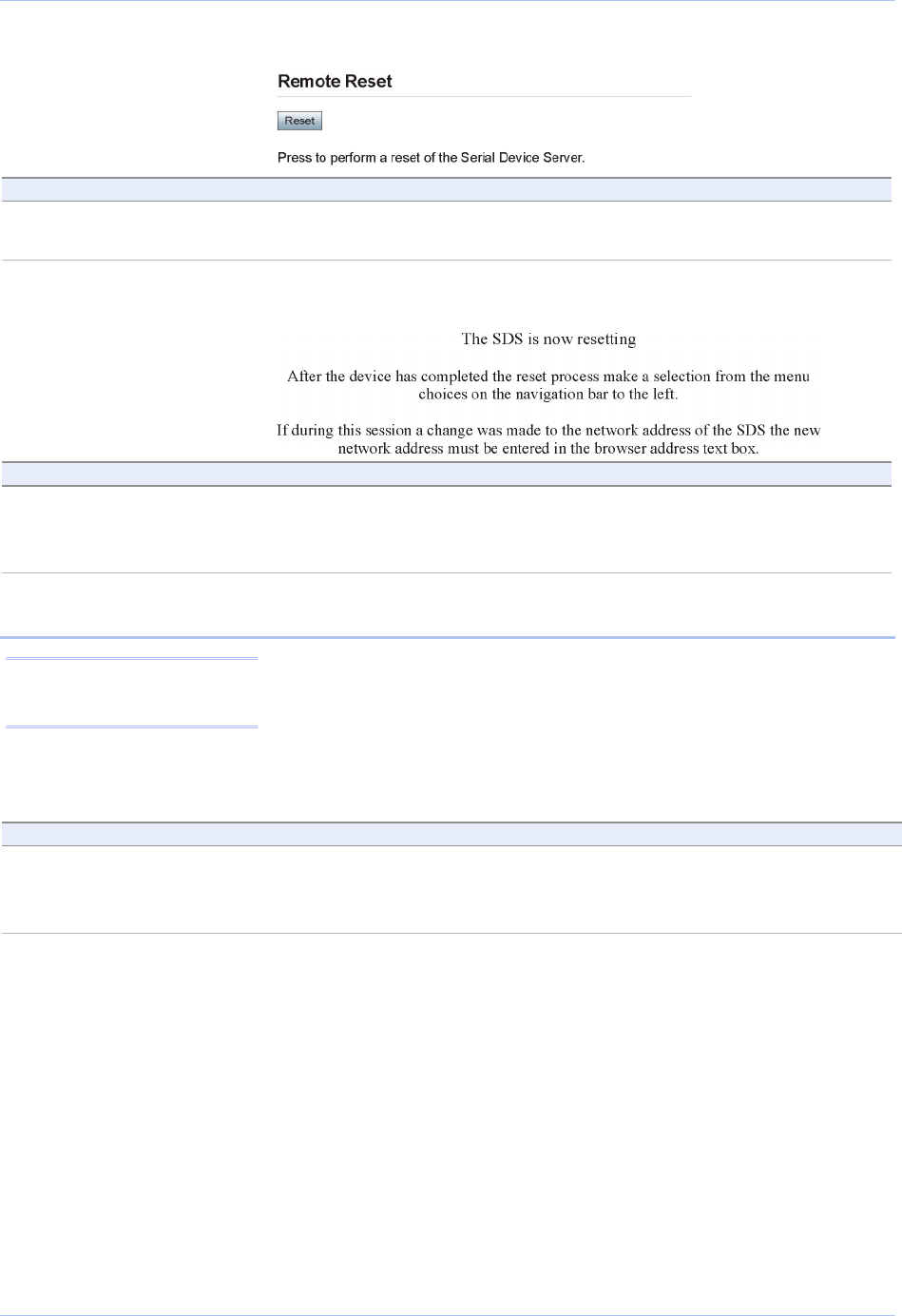
Quatech SDS User’s Manual Configuring the SDS using a Web interface
Rev 1.50 (3/13/2005) Page 49
Figure 46 - Remote Reset screen
Step Procedure Description
# Step 13 Press Reset to activate your settings. The SDS is now resetting screen
displays.
Figure 47 - SDS is now resetting screen
Step Procedure Description
# Step 14 Close and reopen the browser.
! Enter the new IP address in the URL
address block.
This confirms that the SDS is accessible.
Setting SNMP parameters
Newer versions of SDS hardware with 5.x.x firmware have been
enhanced with additional Flash RAM to support SNMP. Older
hardware does not have sufficient memory to store the SNMP agent.
To determine the firmware revision level of an SDS, navigate to the
Home page in the Web-based interface (see page 44). The F/W
revision level is shown at the bottom of the Home page.
Step Procedure Description
# Preliminary
Step
Click on Network in the selection bar
and then select SNMP Setup from the
left panel.
The SNMP Setup screen shown on the
following page displays.
Note: Only SDS devices with a
firmware revision level of 5.0
and above can support SNMP.
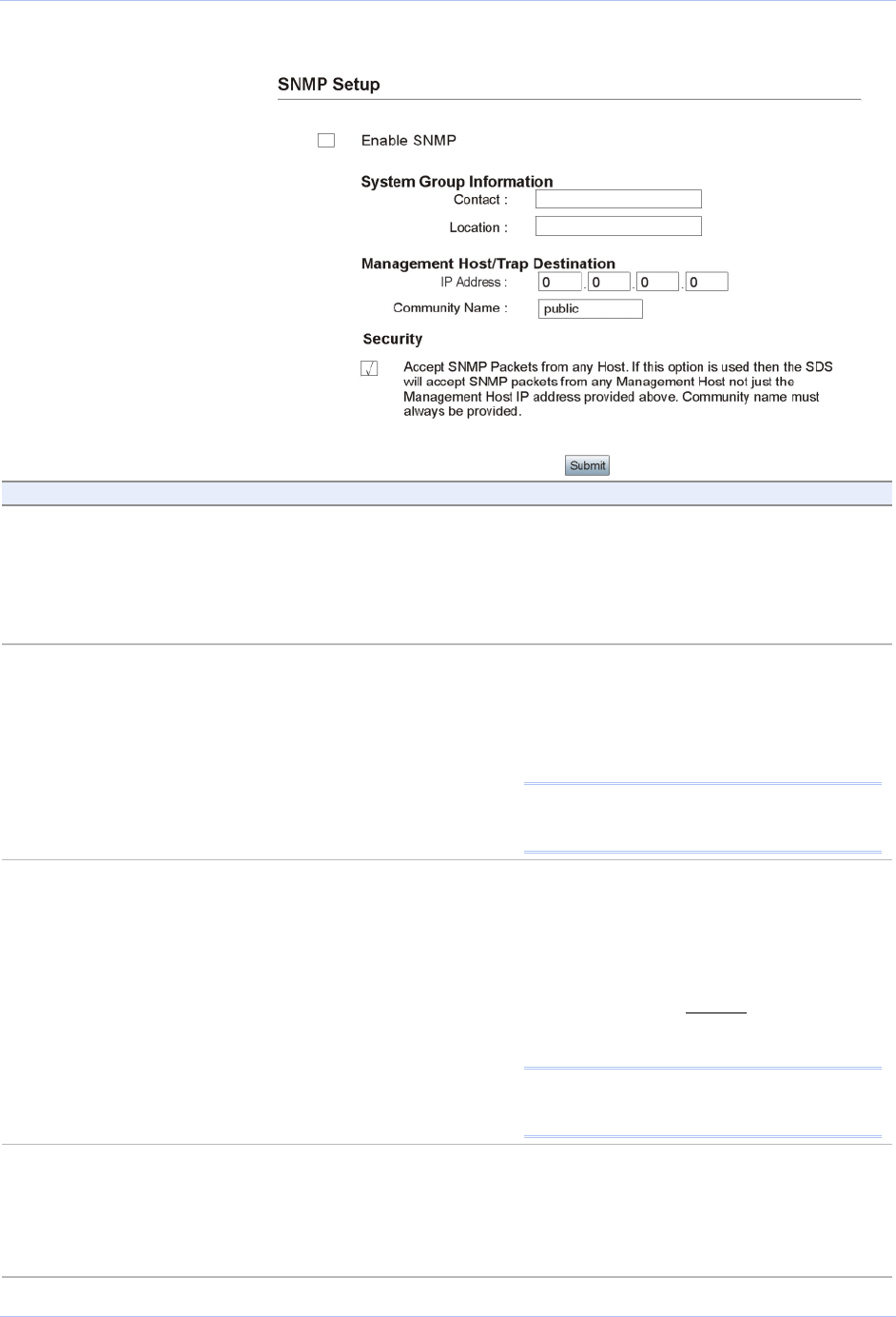
Configuring the SDS using a Web interface Quatech SDS User’s Manual
Page 50 Rev 1.50 (3/13/2005)
Figure 48 - SNMP Setup screen
Step Procedure Description
# Step 1 Enable or disable SNMP in the SDS.
! Select the Enable SNMP checkbox to
enable SNMP. Continue with □ Step 2.
! Clear the checkbox to disable SNMP.
Go to □ Step 5.
By default, SNMP is disabled and the
checkbox is cleared.
# Step 2 Enter the System Group information.
! Contact:
! Location:
The Contact should be the person
responsible for the operation of the SDS.
The Location could be as general as Italy
or as specific as the 3rd floor storage closet.
Note: The System Group Description is the
same as the SDS Descriptive Name, which
you can set on the Administration screen.
# Step 3 Enter the Management Host/Trap
Destination information.
! IP Address:
! Community Name:
The host IP address you set here is
where the SDS will send its traps.
A community name, which is similar to
a password, must always be provided.
To receive traps from an SDS, the host
must have the same community name.
Note: If you set a host address of 0.0.0.0,
then you must disable Security. The SDS
will not send any traps.
# Step 4 Enable or disable Security.
! Check to allow the SDS to accept
SNMP packets from any host in the
same community group.
By default, the SDS can accept SNMP
packets from any host with the same
community name.
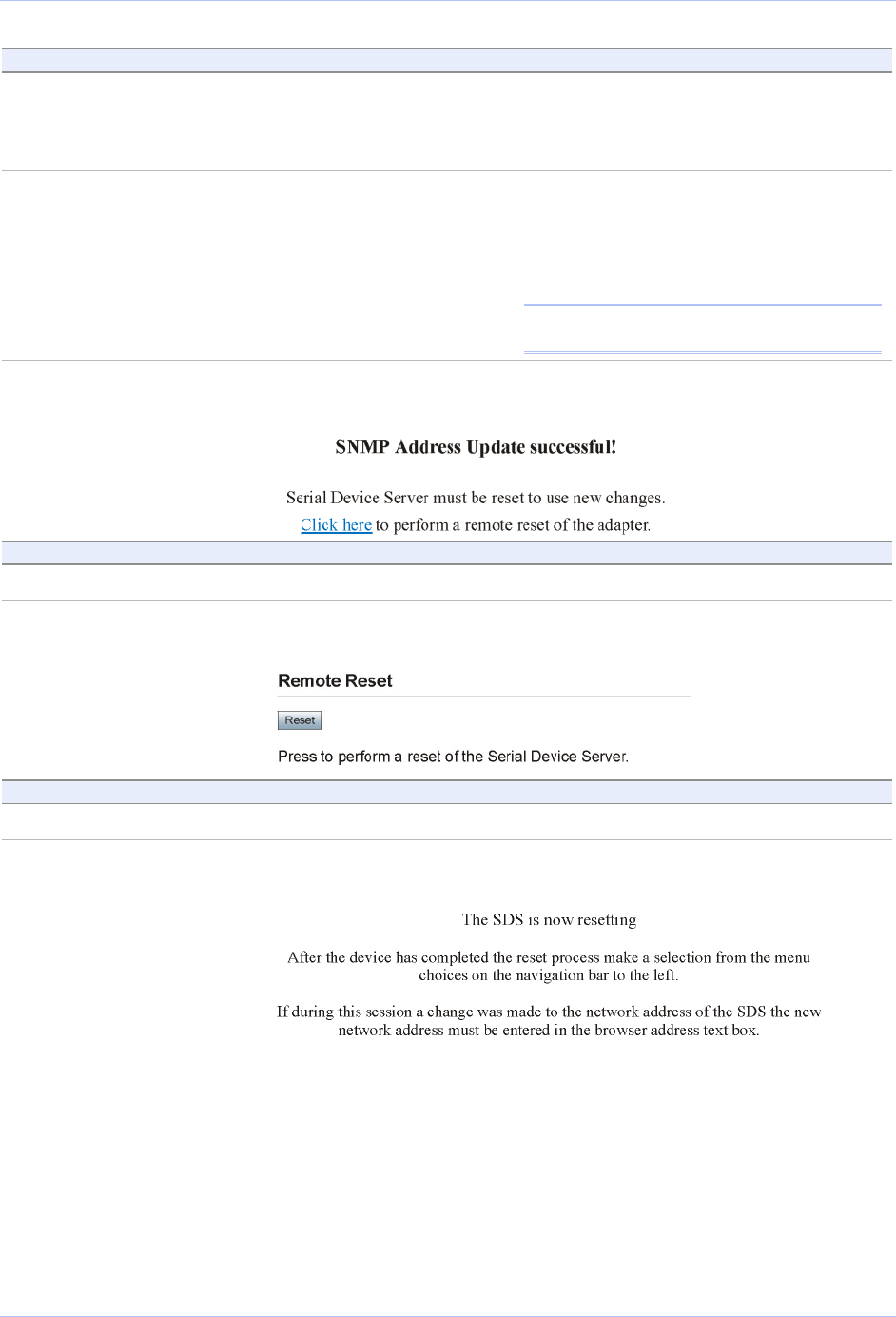
Quatech SDS User’s Manual Configuring the SDS using a Web interface
Rev 1.50 (3/13/2005) Page 51
Step Procedure Description
! Clear the check box to allow the SDS
to accept packets only from the host
you specify in the Management Host/
Trap Destination configuration.
# Step 5 Press Submit to configure the SDS with
your settings.
The SNMP Update Successful screen
displays. You must reset the SDS for
your changes to take effect.
If you press the browser’s Back button,
your original settings remain unchanged.
Note: Press the browser’s Back button to
make no changes to the original settings.
Figure 49 - SNMP Address Update Successful screen
Step Procedure Description
# Step 6 Click on the link to reset the SDS. The Remote Reset screen displays.
Figure 50 - Remote Reset screen
Step Procedure Description
# Step 7 Press Reset to activate your settings. The SDS is now resetting screen displays.
Figure 51 - SDS is now resetting screen

Configuring the SDS using a Web interface Quatech SDS User’s Manual
Page 52 Rev 1.50 (3/13/2005)
Viewing the serial port parameters
Step Procedure Description
# Preliminary
Step
Select Serial Ports from the selection
bar and then select Serial Port Status
from the left panel.
The Serial Port Status screen shown
on the following page displays.
Note: You cannot make any changes to
port parameters from this screen. To
adjust these settings, select the Setup link.
! In Use indicates whether the port
has been opened by a serial port
application and so cannot be
opened by another user application.
If the port is open, In Use further
indicates whether the port is open
in Normal, Tunneling, Raw TCP,
Auto TCP, or Raw UDP mode.
Figure 52 - Serial Port Status screen
Setting serial port parameters
In configuring your Serial Device Server’s serial port parameters,
there are two main considerations:
! Which operating mode should you use?
! Is your serial port RS-232 or RS-232/422/485 (MEI)?
Setting Normal operating mode parameters
This section explains how to set your RS-232 and RS-422/485 parameters
and also provides details on setting up your SDS in the Normal operating
mode. In the following sections, you’ll find information on configuring your
SDS for Tunneling, Raw TCP, Auto TCP, and Raw UDP operating modes.
In most cases, you will use the Normal operating mode for your SDS.
This allows you to use either Quatech’s virtual COM port drivers or the
IntelliSock SDK to communicate over a network.
Step Procedure Description
# Preliminary
Step
Click on Serial Ports in the selection
bar.
The Serial Port Setup screen shown on
the following page displays.
Note: Normal is the standard
connection mode for an SDS.
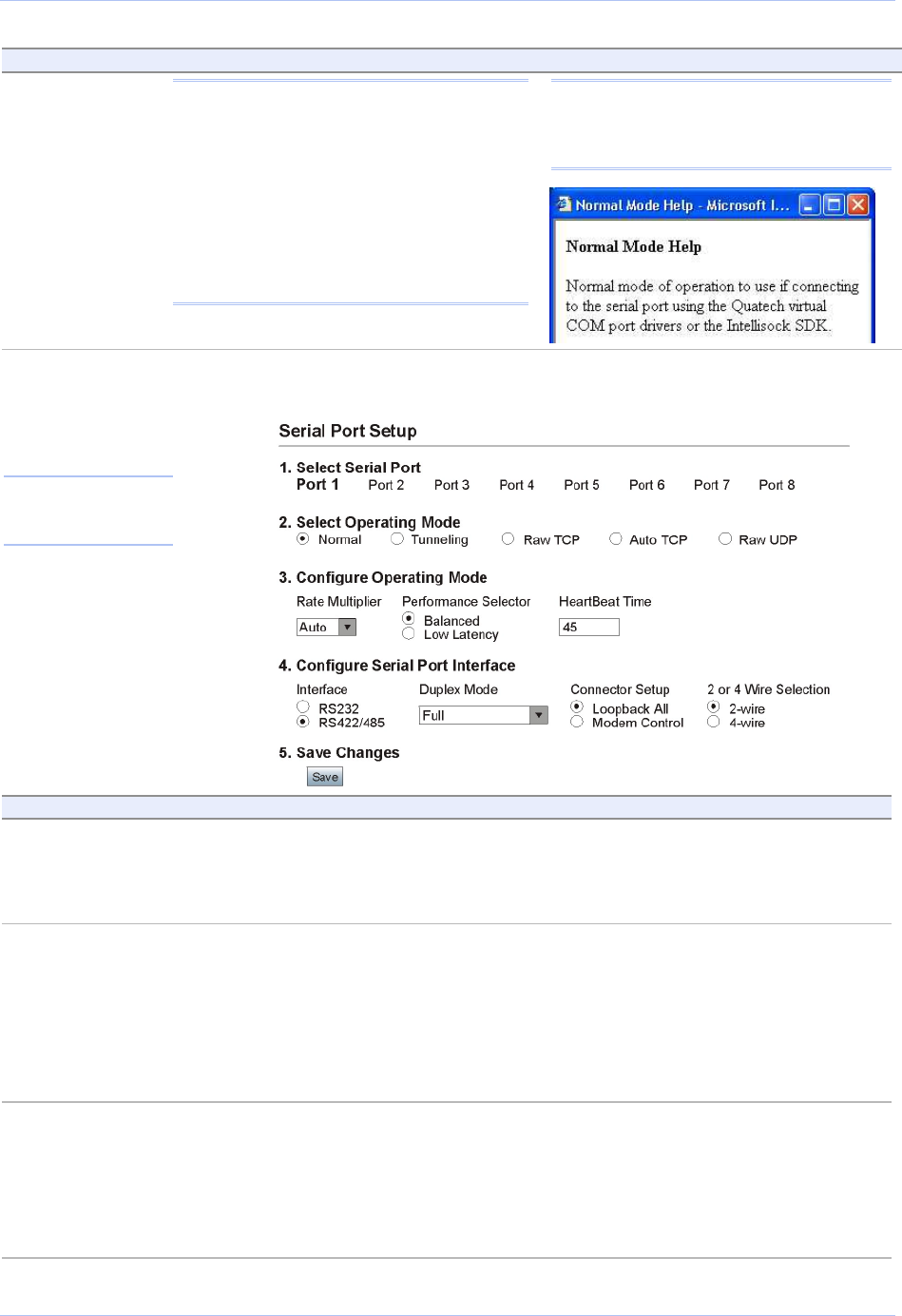
Quatech SDS User’s Manual Configuring the SDS using a Web interface
Rev 1.50 (3/13/2005) Page 53
Step Procedure Description
Note: Setup screens vary slightly between
RS-232 and RS-232/422/485 (MEI) units.
If you have an RS-232/422/485 (MEI) SDS,
the Configure Serial Port Interface step will
display so that you can select between RS-
232 and RS-422/485 operation.
If you have an RS-232 SDS, the Configure
Serial Port Interface step will not display
and you will not be presented with any RS-
422/485 configuration options.
Note: Click on a link to see a pop-up help
screen for that item. For example, if you
click on the Normal Mode link, the
following help screen pops up.
Figure 53 - Serial Port Setup screen for Normal mode
Step Procedure Description
# Step 1 Click on the serial port you want to
configure.
Clicking on a port number highlights
and selects that port. The selections on
the screen are automatically populated
with the parameters for the selected port.
# Step 2 Click on the Normal Operating Mode
selector.
Select Normal mode if you are using the
Quatech virtual COM port drivers or
IntelliSock SDK.
You will find directions for configuring
ports in Tunneling, Raw TCP, Auto
TCP, and Raw UDP modes in the
following sections.
# Step 3a Configure the Operating mode.
Click on the desired data Rate Multiplier.
Your choices are:
! Auto (Recommended)
! Force X2 mode
The auto setting has no effect on the
baud rate you set. However, if you select
X2, X4, or X8, the baud rate of the serial
port will be the baud rate that you set
multiplied by 2, 4, or 8, respectively.
Note: Click on a link
to see a pop-up help
screen for that item.

Configuring the SDS using a Web interface Quatech SDS User’s Manual
Page 54 Rev 1.50 (3/13/2005)
Step Procedure Description
! Force X4 mode
! Force X8 mode
Note: Forcing a change in the data rate may
cause communication problems with some
serial devices. If this is the case, change the
setting back to Auto (Recommended).
# Step 3b Click on the desired Performance
Selector.
Choose balanced mode except in those
cases where the serial device cannot
tolerate the slight delays inherent in
normal TCP/IP operation.
Balanced mode offers excellent performance
for most applications.
Low Latency mode heavily favors
responsiveness over throughput.
# Step 3c Set the Heart Beat Time to a value from 1
to 65534 seconds. Default is 45 seconds.
Note: Use a value of 0 to disable the heartbeat
timer.
Heartbeat messages help detect when a
connection has been lost between the PC
driver and the SDS.
If you need quick notification that the
connection has been lost, set this timer to
a shorter value.
If you are more concerned about network
traffic, set this timer to a longer value.
Steps 4a through 4d apply only to RS-232/422/485 (MEI) units
# Step 4a
(MEI only)
Configure the serial port interface.
Click on the desired interface selector.
This series of steps only applies to MEI
units, such as the SSE-400.
If you select RS232, the RS422/485
selections will be grayed out. Continue
with □ Step 5.
# Step 4b
(MEI only)
Click on the desired duplex mode selector. Select Full Duplex to always enable
transmit and receive drivers.
Select Half Rx to only enable the
transmit drivers when the SDS is
transmitting; receivers will always be
enabled.
Select Half Rx Tog to disable receivers
and enable the transmit drivers only
when the SDS is transmitting.
# Step 4c
(MEI only)
Click on the desired connector setup. Select Loopback All to internally loopback
RTS and CTS in the SDS. AuxIn and
AuxOut are looped at the connector.
Select Modem Control to send RTS on
the AuxOut signal and to receive CTS on
the AuxIn signal.
# Step 4d
(MEI only)
Select 2- or 4-wire communication. Select 2-wire to use the transmit pair for
both transmit and receive in RS-422/485.
Select 4-wire to use a separate pair of wires
for transmit and receive in RS-422/485.

Quatech SDS User’s Manual Configuring the SDS using a Web interface
Rev 1.50 (3/13/2005) Page 55
Step Procedure Description
Step 4 (non-MEI) / Step 5 (MEI) applies to all units
# Step 4
(non-MEI)
or
# Step 5
(MEI only)
Repeat the steps above for each port you
need to configure and then press Save to
implement all of your changes.
Close and re-open the port to activate
your changes.
That’s it! You’re done. Normal is the
most common operating mode and the
easiest to set up.
Setting Tunneling operating mode parameters
Serial Tunneling allows two SDS units to create a virtual cable
connection between each other’s serial ports with one end configured
as a master and the other end as a slave. You set up the master with
the slave’s IP address and serial port number that you want use for
the virtual connection. The master finds the slave and makes the
connection. The master configures the slave’s parameters (baud rate,
parity, and so forth) as necessary. A master can connect either to an
SDS in Normal mode or to a slave in Tunneling mode.
On the slave end, all you have to do is click Slave and leave the rest of
the Operating Mode settings blank. The slave waits for a master to
connect to it and to provide the configuration parameters.
A master connects to one of a slave’s serial ports. A second master can
connect to another port on the slave at the same time. However, you
can only have one Tunnel master/slave combination working at the
same time between any single set of ports.
Step Procedure Description
# Preliminary
Step
Select Serial Ports from the selection
bar.
Note: Setup screens vary slightly between
RS-232 and RS-232/422/485 (MEI) units.
If you have an RS-232/422/485 (MEI) SDS,
the Configure Serial Port Interface step will
display so that you can select between RS-
232 and RS-422/485 operation.
If you have an RS-232 SDS, the Configure
Serial Port Interface step will not display
and you will not be presented with any RS-
422/485 configuration options.
The Serial Port Setup screen shown on
the following page displays.
Note: Click on a link to see a pop-up help
screen for that item. For example, if you
click on the Tunnel Slave link, the
following help screen pops up.
Note: In Tunneling, a master
configures a slave so that the
slave can communicate with it.
Note: A Tunnel master needs to
know the slave’s IP address
and serial port number.

Configuring the SDS using a Web interface Quatech SDS User’s Manual
Page 56 Rev 1.50 (3/13/2005)
Figure 54 - Serial Port Setup screen for Tunneling mode
Step Procedure Description
# Step 1 Select the serial port you want to
configure.
Click on a port number to select that
port. The selections on the screen are
automatically populated with any
existing parameters for the selected port.
# Step 2 Click on the Tunneling Operating Mode
selector.
Tunneling allows two SDS devices to
create a virtual connection between their
serial ports.
You will find directions for configuring
ports in Normal mode in the previous
section. Directions for Raw TCP, Auto
TCP and Raw UDP modes are in the
following sections.
# Step 3a Configure the Operating mode.
Click on the desired data Rate Multiplier.
Your choices are:
! Auto (Recommended)
! Force X2 mode
! Force X4 mode
! Force X8 mode
The auto setting has no effect on the
baud rate you set. However, if you select
X2, X4, or X8, the baud rate of the serial
port will be the baud rate that you set
multiplied by 2, 4, or 8, respectively.
Note: Forcing a change in the data rate may
cause communication problems with some
serial devices. If this is the case, change the
setting back to Auto (Recommended).
# Step 3b Click on the desired Performance
Selector.
Choose balanced mode except in those
cases where the serial device cannot
tolerate the slight delays inherent in
normal TCP/IP operation.
Note: Click on a link
to see a pop-up help
screen for that item.
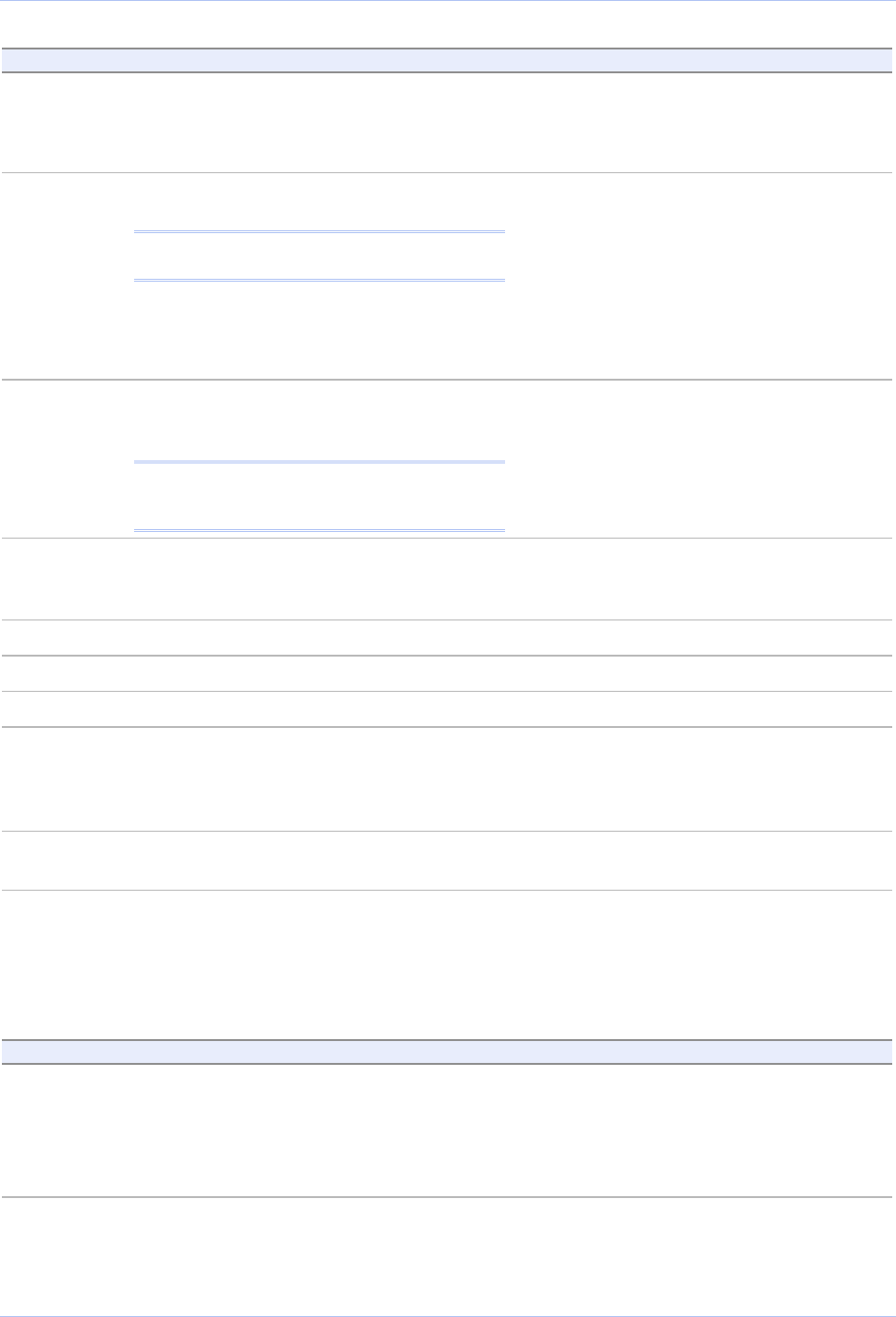
Quatech SDS User’s Manual Configuring the SDS using a Web interface
Rev 1.50 (3/13/2005) Page 57
Step Procedure Description
Balanced mode offers excellent performance
for most applications.
Low Latency mode heavily favors
responsiveness over throughput.
# Step 3c Set the Heart Beat Time to a value from 1
to 65534 seconds. Default is 45 seconds.
Note: Use a value of 0 to disable the heartbeat
timer.
Heartbeat messages help detect when a
connection has been lost between the PC
driver and the SDS.
If you need quick notification that the
connection has been lost, set this timer to
a shorter value.
If you are more concerned about network
traffic, set this timer to a longer value.
# Step 3d Click on the desired Tunnel End Type
selector. If Slave, skip to Step 4. If
Master, continue with Steps 3e–3k.
Note: Steps 3e–3k are only available if the
Tunnel End Type is set to Master. If it is set to
Slave, they are grayed out.
This selection determines which end of
the serial tunnel connection is the
Master and which is the Slave. At this
point, your Slave ports are completely
configured. Master ports must have the
following parameters set.
# Step 3e Set the Baud Rate. The SDS and the serial device(s) to
which it is attached must use the same
serial connection speed.
# Step 3f Set the Parity. Parity can be odd, even, or none.
# Step 3g Set the Data Bits. Data Bits can be 7 or 8.
# Step 3h Set the Stop Bits. Stop Bits can be 1 or 2.
# Step 3i Set the Flow Control. Flow control determines the handshake
method used between the SDS and the
serial device(s) to stop the serial
input/output process
# Step 3j Set the IP Address of the Slave SDS. This selection sets the IP address to be
used in Serial Tunneling mode.
# Step 3k Set the Serial/TCP Port number on the
Slave SDS.
This selection sets the serial port for
Serial Tunneling mode. For a single-
port Slave SDS, enter “1”; for a multi-
port Slave SDS, enter the port number
according to the label next to the
connector you plan to use.
Steps 4a through 4d apply only to RS-232/422/485 (MEI) units
# Step 4a
(MEI only)
Configure the serial port interface.
Click on the desired interface selector.
This series of steps only applies to MEI
units, such as the SSE-400.
If you select RS232, the RS422/485
selections will be grayed out. Continue
with □ Step 5.
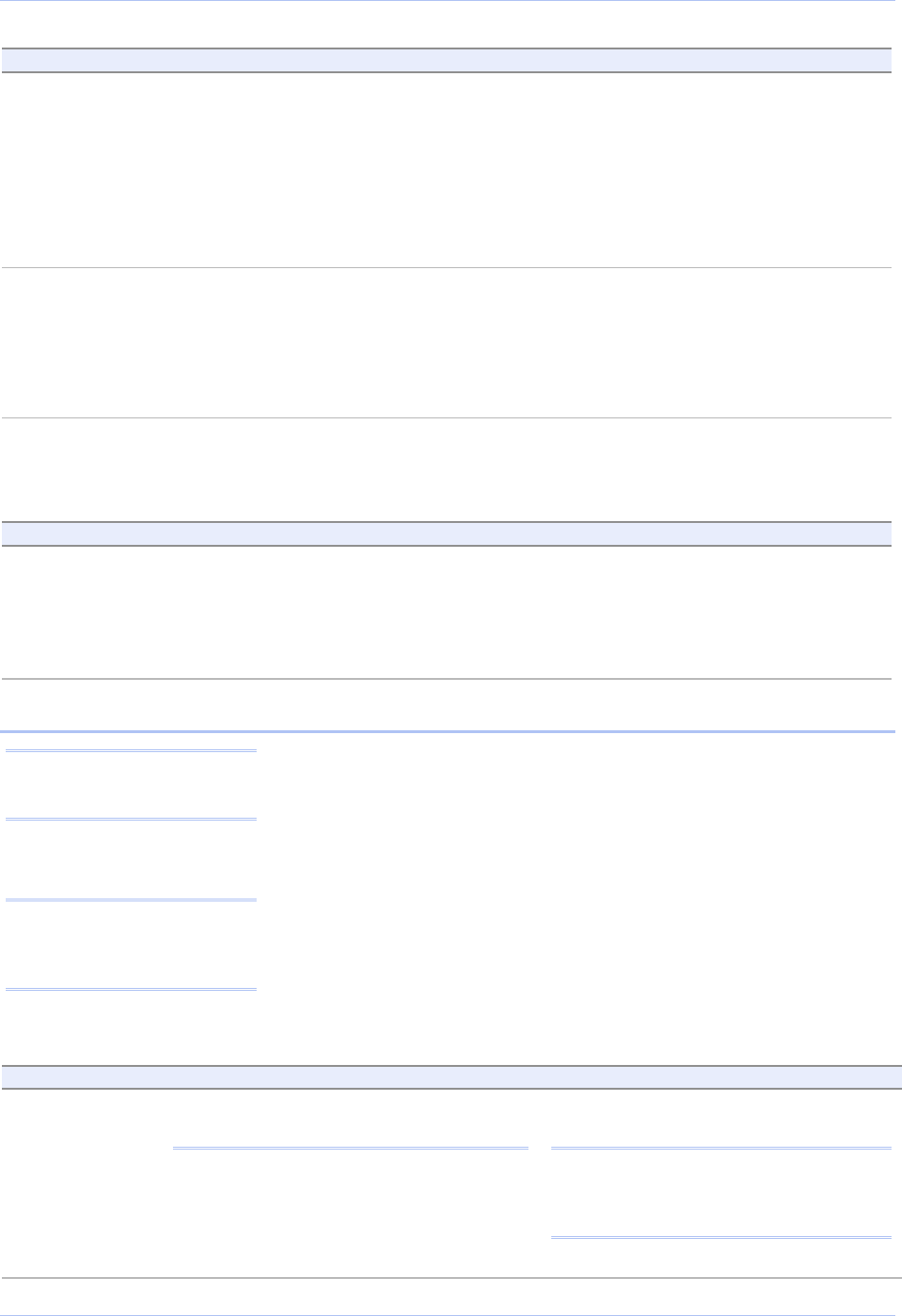
Configuring the SDS using a Web interface Quatech SDS User’s Manual
Page 58 Rev 1.50 (3/13/2005)
Step Procedure Description
# Step 4b
(MEI only)
Click on the desired duplex mode selector. Select Full Duplex to always enable
transmit and receive drivers.
Select Half Rx to enable the transmit
drivers only when the SDS is transmitting;
receivers are always enabled.
Select Half Rx Tog to enable the transmit
drivers and to disable receivers when the
SDS is transmitting.
# Step 4c
(MEI only)
Click on the desired connector setup. Select Loopback All to internally loopback
RTS and CTS in the SDS. AuxIn and
AuxOut are looped at the connector.
Select Modem Control to send RTS on
the AuxOut signal and to receive CTS on
the AuxIn signal.
# Step 4d
(MEI only)
Select 2- or 4-wire communication. Select 2-wire to use the transmit pair for
both transmit and receive in RS-422/485.
Select 4-wire to use a separate pair of wires
for transmit and receive in RS-422/485.
Step 4 (non-MEI) / Step 5 (MEI) applies to all units
# Step 4
(non-MEI)
or
# Step 5
(MEI only)
Repeat the steps above for each port you
need to configure and then press Save to
implement all of your changes.
Close and re-open the port to activate
your changes.
That’s it! You’re done. Your SDS is
configured for the Tunneling operating
mode.
Setting Raw TCP operating mode parameters
Raw TCP mode allows an application to communicate with an SDS
without any custom protocol overhead. In this mode, the only data
sent over the TCP connection is that which will be sent or received
over the serial port.
An SDS port in Raw TCP mode cannot connect to an SDS port in
Normal mode because our Normal virtual COM port wraps the data
in headers before it transmits. In Raw TCP mode, you can’t send
down a packet that says change the baud rate; you have to set up the
serial port configuration yourself.
Raw TCP lets you write your own simple program to communicate
without having to put headers on the packet (no custom protocol
overhead).
Step Procedure Description
# Preliminary
Step
Select Serial Ports from the selection
bar.
Note: Setup screens vary slightly between
RS-232 and RS-232/422/485 (MEI) units.
If you have an RS-232/422/485 (MEI) SDS,
the Configure Serial Port Interface step will
display so that you can select between RS-
232 and RS-422/485 operation.
The Serial Port Setup screen shown on
the following page displays.
Note: Click on a link to see a pop-up help
screen for that item. For example, if you
click on the Raw TCP mode link, the
following help screen pops up.
Note: You could use Raw TCP
if you were running a simple,
custom TCP application.
Note: Raw TCP settings must
include the baud rate, parity,
data bits, stop bits, and flow
control.
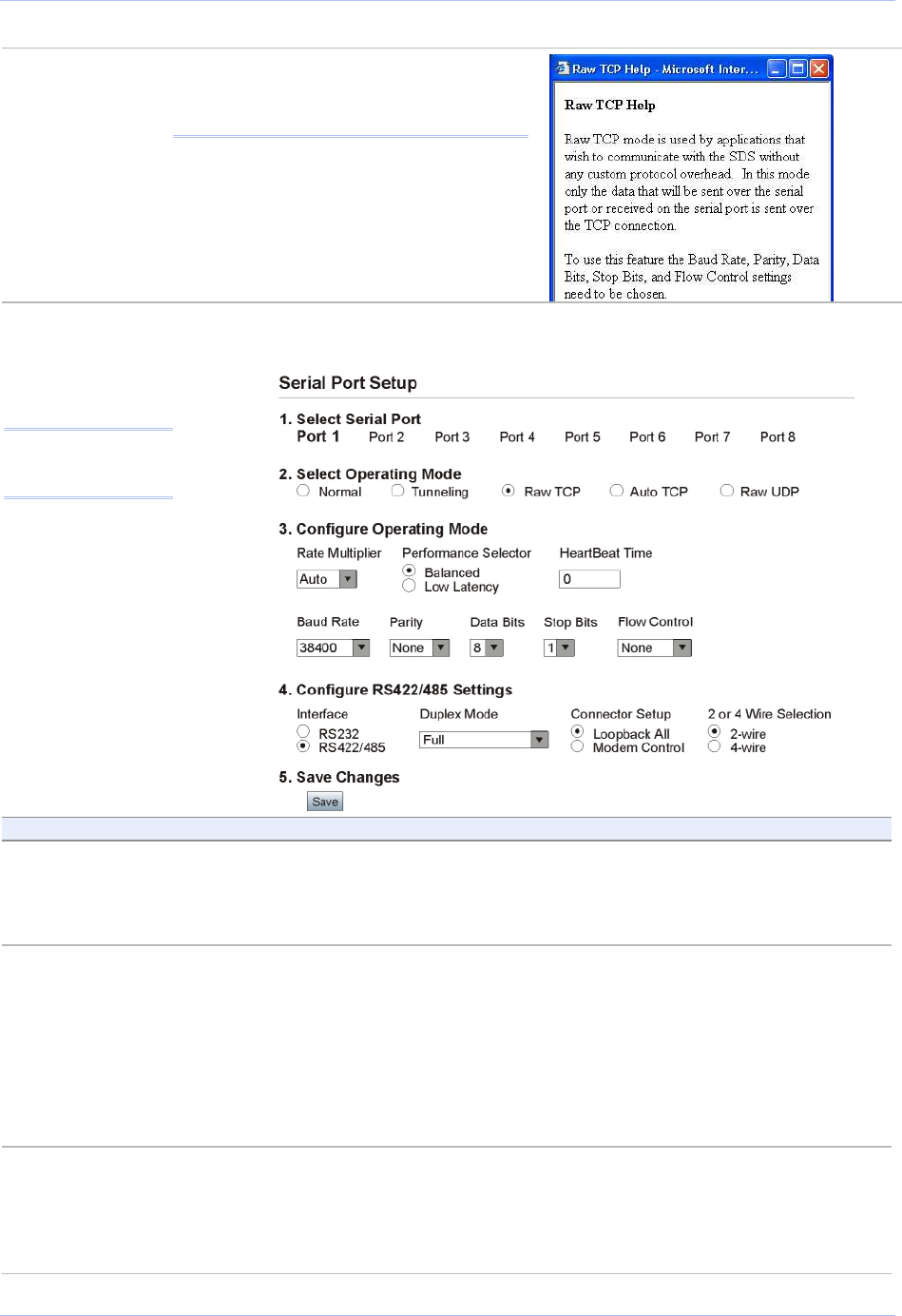
Quatech SDS User’s Manual Configuring the SDS using a Web interface
Rev 1.50 (3/13/2005) Page 59
If you have an RS-232 SDS, the Configure
Serial Port Interface step will not display
and you will not be presented with any RS-
422/485 configuration options.
Figure 55 - Serial Port Setup screen for Raw TCP mode
Step Procedure Description
# Step 1 Select the serial port you want to
configure.
Click on a port number to select that
port. The selections on the screen are
automatically populated with any
existing parameters for the selected port.
# Step 2 Click on the Raw TCP operating mode
selector.
Raw TCP allows an SDS device to
communicate without any protocol
overhead.
You will find directions for configuring
ports in Normal and Tunneling modes
in the preceding sections. Directions for
Auto TCP and Raw UDP modes are in
the following section.
# Step 3a Configure the Operating mode.
Click on the desired data Rate Multiplier.
Your choices are:
! Auto (Recommended)
The auto setting has no effect on the
baud rate you set. However, if you select
X2, X4, or X8, the baud rate of the serial
port will be the baud rate that you set
multiplied by 2, 4, or 8, respectively.
Note: Click on a link
to see a pop-up help
screen for that item.

Configuring the SDS using a Web interface Quatech SDS User’s Manual
Page 60 Rev 1.50 (3/13/2005)
Step Procedure Description
! Force X2 mode
! Force X4 mode
! Force X8 mode
Note: Forcing a change in the data rate may
cause communication problems with some
serial devices. If this is the case, change the
setting back to Auto (Recommended).
# Step 3b Click on the desired Performance
Selector.
Choose balanced mode except in those
cases where the serial device cannot
tolerate the slight delays inherent in
normal TCP/IP operation.
Balanced mode offers excellent performance
for most applications.
Low Latency mode heavily favors
responsiveness over throughput.
# Step 3c Set the Heart Beat Time to a value from 1
to 65534 seconds. Default is 45 seconds.
Note: Use a value of 0 to disable the heartbeat
timer.
Heartbeat messages help detect when a
connection has been lost between the PC
driver and the SDS.
If you need quick notification that the
connection has been lost, set this timer to
a shorter value.
If you are more concerned about network
traffic, set this timer to a longer value.
# Step 3d Set the Baud Rate. The SDS and the serial device(s) to
which it is attached must use the same
serial connection speed.
# Step 3e Set the Parity. Parity can be odd, even, or none.
# Step 3f Set the Data Bits. Data Bits can be 7 or 8.
# Step 3g Set the Stop Bits. Stop Bits can be 1 or 2.
# Step 3h Set the Flow Control. Flow control determines the handshake
method used between the SDS and the
serial device(s) to stop the serial
input/output process.
Steps 4a through 4d apply only to RS-232/422/485 (MEI) units
# Step 4a
(MEI only)
Configure the serial port interface.
Click on the desired interface selector.
This series of steps only applies to MEI
units, such as the SSE-400.
If you select RS232, the RS422/485
selections will be grayed out. Continue
with □ Step 5.
# Step 4b
(MEI only)
Click on the desired duplex mode selector. Select Full Duplex to always enable
transmit and receive drivers.
Select Half Rx to only enable the
transmit drivers when the SDS is
transmitting; receivers always enabled.
Select Half Rx Tog to disable receivers
and enable the transmit drivers only
when the SDS is transmitting.
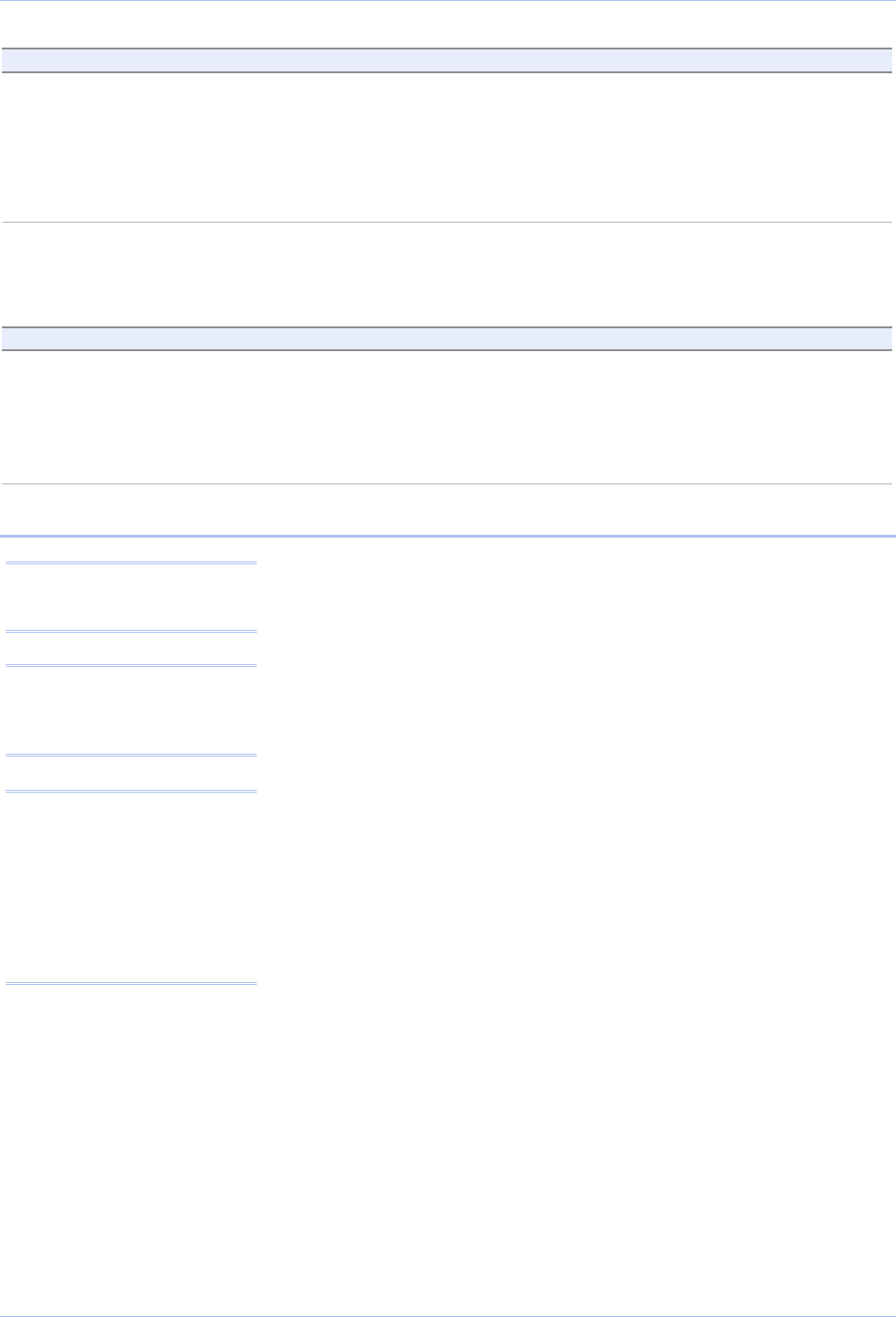
Quatech SDS User’s Manual Configuring the SDS using a Web interface
Rev 1.50 (3/13/2005) Page 61
Step Procedure Description
# Step 4c
(MEI only)
Click on the desired connector setup. Select Loopback All to internally loopback
RTS and CTS in the SDS. AuxIn and
AuxOut are looped at the connector.
Select Modem Control to send RTS on
the AuxOut signal and to receive CTS on
the AuxIn signal.
# Step 4d
(MEI only)
Select 2- or 4-wire communication. Select 2-wire to use the transmit pair for
both transmit and receive in RS-422/485.
Select 4-wire to use a separate pair of wires
for transmit and receive in RS-422/485.
Step 4 (non-MEI) / Step 5 (MEI) applies to all units
# Step 4
(non-MEI)
or
# Step 5
(MEI only)
Repeat the steps above for each port you
need to configure and then press Save to
implement all of your changes.
Close and re-open the port to activate
your changes.
That’s it! You’re done. Your SDS is
configured for the Raw TCP operating
mode.
Setting Auto TCP operating mode parameters
In Auto TCP, the SDS acts both as a client and as a server. As a
client, it connects to the server at the specified TCP address and port.
As a server, it will accept a Raw TCP mode connection.
You can configure an SDS port to use either DSR or Data to initiate a
connection. As with Raw TCP, you must configure all the connection
information (baud rate, data bits, and so forth) on the Serial Port
Setup page. There is no way for the application to tell the SDS what
to use for that serial port connection.
Auto TCP is also somewhat similar to Raw TCP in that only data
passes through an SDS serial port – there are no headers and no
packet. For this reason, you cannot use Auto TCP with our virtual
COM port drivers.
You can connect to the SDS via another host and use a port just as
you would in Raw TCP. The main differences between Raw and Auto
TCP are that Auto TCP operates in two modes (DSR and Data) and
that it can enable the SDS to initiate a connection.
! Auto TCP–DSR mode: When the SDS port sees DSR become
active (raised), it connects, on its own, to the end point specified
by the IP address and TCP port on the Serial Port Setup Web
page. When DSR is de-activated, the SDS drops the network
connection.
! Auto TCP– Data mode: When an SDS starts receiving data on its
serial port, it connects to the end point specified by the IP address
and TCP port on the Serial Port Setup Web page.
Auto TCP timeout: When a given amount of time passes
without any new data, the SDS closes the connection. The Auto
TCP Timeout is used only in Data mode, not in the DSR mode.
Note: Auto TCP is the only
communication mode that lets
an SDS initiate the connection.
Note: In Normal and Raw TCP,
an outside device such as a
computer performs the act of
connecting to the SDS. That’s
also one of the modes under
Auto TCP. A PC can connect to
the SDS and start transferring
data back and forth using its
serial port.
Note: Auto TCP settings must
include the baud rate, parity,
data bits, stop bits, and flow
control.

Configuring the SDS using a Web interface Quatech SDS User’s Manual
Page 62 Rev 1.50 (3/13/2005)
Step Procedure Description
# Preliminary
Step
Click on Serial Ports in the selection
bar.
Note: Setup screens vary slightly between
RS-232 and RS-232/422/485 (MEI) units.
If you have an RS-232/422/485 (MEI) SDS,
the Configure Serial Port Interface step will
display so that you can select between RS-
232 and RS-422/485 operation.
If you have an RS-232 SDS, the Configure
Serial Port Interface step will not display
and you will not be presented with any RS-
422/485 configuration options.
The Serial Port Setup screen shown on
the following page displays.
Note: Click on a link to see a pop-up help
screen for that item. For example, if you
click on the Auto TCP mode link, the
following help screen pops up.
Figure 56 - Serial Port Setup screen for Auto TCP mode
Note: Click on a link
to see a pop-up help
screen for that item.
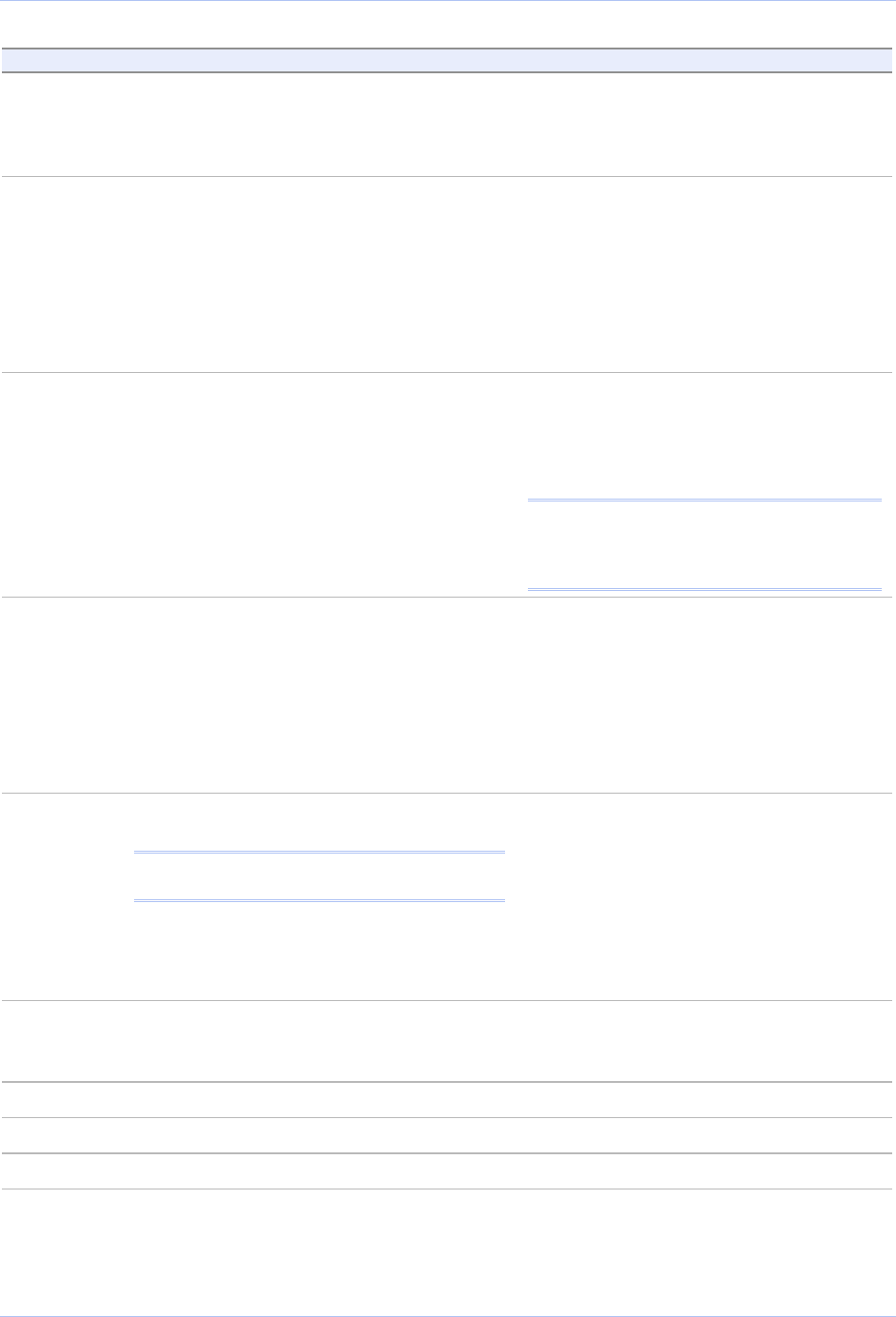
Quatech SDS User’s Manual Configuring the SDS using a Web interface
Rev 1.50 (3/13/2005) Page 63
Step Procedure Description
# Step 1 Select the serial port you want to
configure.
Click on a port number to select that
port. The selections on the screen are
automatically populated with any
existing parameters for the selected port.
# Step 2 Click on the Auto TCP Operating Mode
selector.
Auto TCP allows an SDS device to act as
a client and to connect to the server when
DSR is active or when data is received.
You will find directions for configuring
ports in Normal, Tunneling, and Raw
TCP modes in the preceding sections.
Directions for Raw UDP mode are in the
following section.
# Step 3a Configure the Operating mode.
Click on the desired data Rate Multiplier.
Your choices are:
! Auto (Recommended)
! Force X2 mode
! Force X4 mode
! Force X8 mode
The auto setting has no effect on the
baud rate you set. However, if you select
X2, X4, or X8, the baud rate of the serial
port will be the baud rate that you set
multiplied by 2, 4, or 8, respectively.
Note: Forcing a change in the data rate may
cause communication problems with some
serial devices. If this is the case, change the
setting back to Auto (Recommended).
# Step 3b Click on the desired Performance
Selector.
Choose balanced mode except in those
cases where the serial device cannot
tolerate the slight delays inherent in
normal TCP/IP operation.
Balanced mode offers excellent
performance for most applications.
Low Latency mode heavily favors
responsiveness over throughput.
# Step 3c Set the Heart Beat Time to a value from 1
to 65534 seconds. Default is 45 seconds.
Note: Use a value of 0 to disable the heartbeat
timer.
Heartbeat messages help detect when a
connection has been lost between the PC
driver and the SDS.
If you need quick notification that the
connection has been lost, set this timer to
a shorter value.
If you are more concerned about network
traffic, set this timer to a longer value.
# Step 3d Set the Baud Rate. The SDS and the serial device(s) to
which it is attached must use the same
serial connection speed.
# Step 3e Set the Parity. Parity can be odd, even, or none.
# Step 3f Set the Data Bits. Data Bits can be 7 or 8.
# Step 3g Set the Stop Bits. Stop Bits can be 1 or 2.
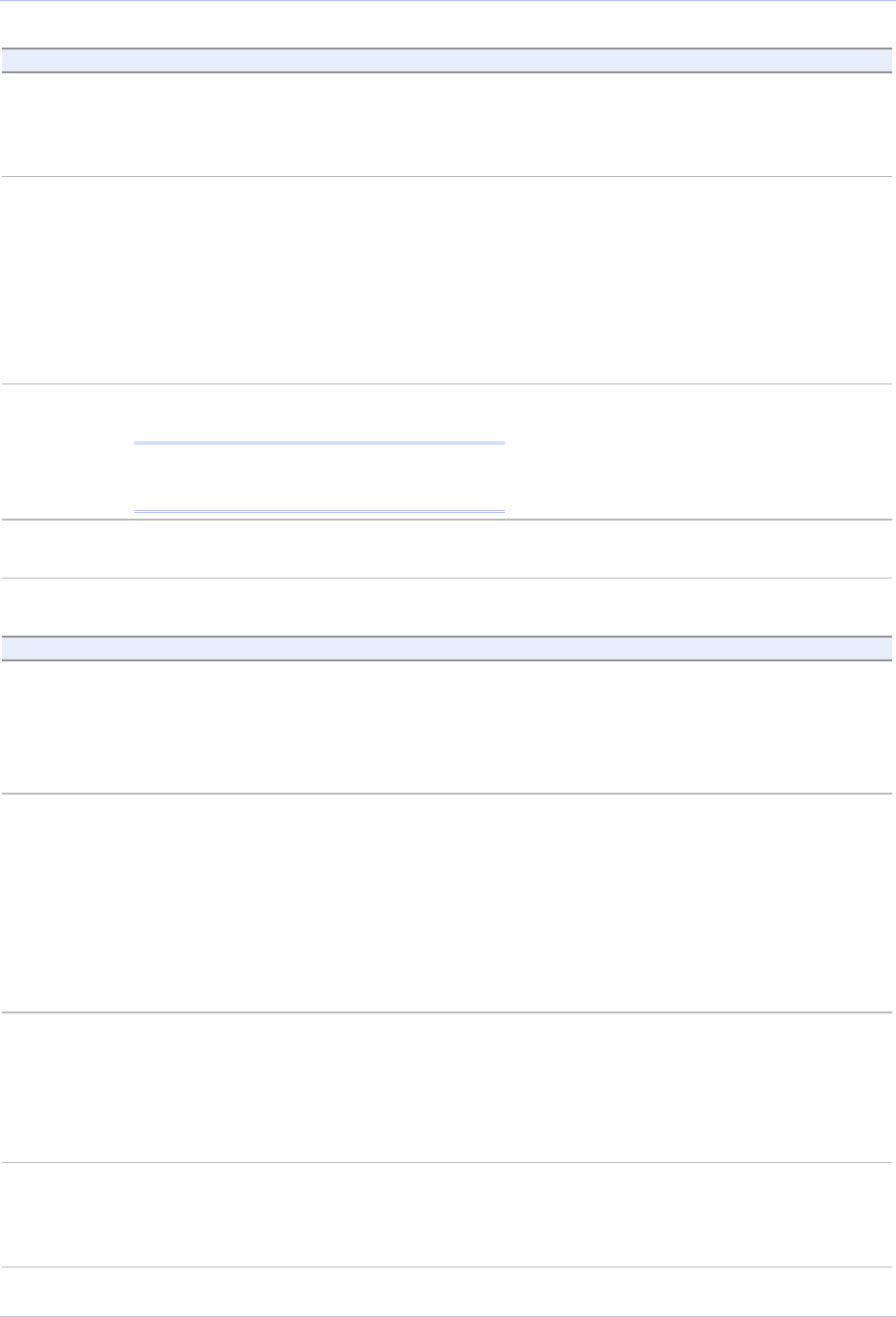
Configuring the SDS using a Web interface Quatech SDS User’s Manual
Page 64 Rev 1.50 (3/13/2005)
Step Procedure Description
# Step 3h Set the Flow Control. Flow control determines the handshake
method used between the SDS and the
serial device(s) to stop the serial
input/output process
# Step 3i Click on the desired Auto TCP Mode
selector.
Your choices are:
! DSR – Initiate the TCP connection
when the SDS serial port’s DSR
becomes active
! Data – Initiate the TCP connection
when the SDS serial port receives data
This selection determines whether the
SDS port will initiate a communications
link when DSR becomes active or when
data is received at the serial port.
Typically, the DTR output of the device
to which you are connecting drives the
DSR input on the SDS serial port.
# Step 3j Set the Auto TCP timeout interval if you
selected Data as the Auto TCP Mode.
Note: This selection is only available if the
Auto TCP Mode selector is set to Data.
Otherwise, it is grayed out.
Sets the amount of time before the TCP
connection is dropped after data stops.
# Step 3k Set the IP Address of the TCP host to
which the SDS will connect.
This selection sets the IP address to be
used in Auto TCP mode.
# Step 3l Set the TCP Port number of the TCP host
to which the SDS will connect.
This selection sets the TCP port for Auto
TCP modes.
Steps 4a through 4d apply only to RS-232/422/485 (MEI) units
# Step 4a
(MEI only)
Configure the serial port interface.
Click on the desired interface selector.
This series of steps only applies to MEI
units, such as the SSE-400.
If you select RS232, the RS422/485
selections will be grayed out. Continue
with □ Step 5.
# Step 4b
(MEI only)
Click on the desired duplex mode selector. Select Full Duplex to always enable
transmit and receive drivers.
Select Half Rx to enable the transmit
drivers only when the SDS is
transmitting; receivers will always be
enabled.
Select Half Rx Tog to enable the transmit
drivers and to disable receivers only
when the SDS is transmitting.
# Step 4c
(MEI only)
Click on the desired connector setup. Select Loopback All to internally loopback
RTS and CTS in the SDS. AuxIn and
AuxOut are looped at the connector.
Select Modem Control to send RTS on
the AuxOut signal and to receive CTS on
the AuxIn signal.
# Step 4d
(MEI only)
Select 2- or 4-wire communication. Select 2-wire to use the transmit pair for
both transmit and receive in RS-422/485.
Select 4-wire to use a separate pair of wires
for transmit and receive in RS-422/485.
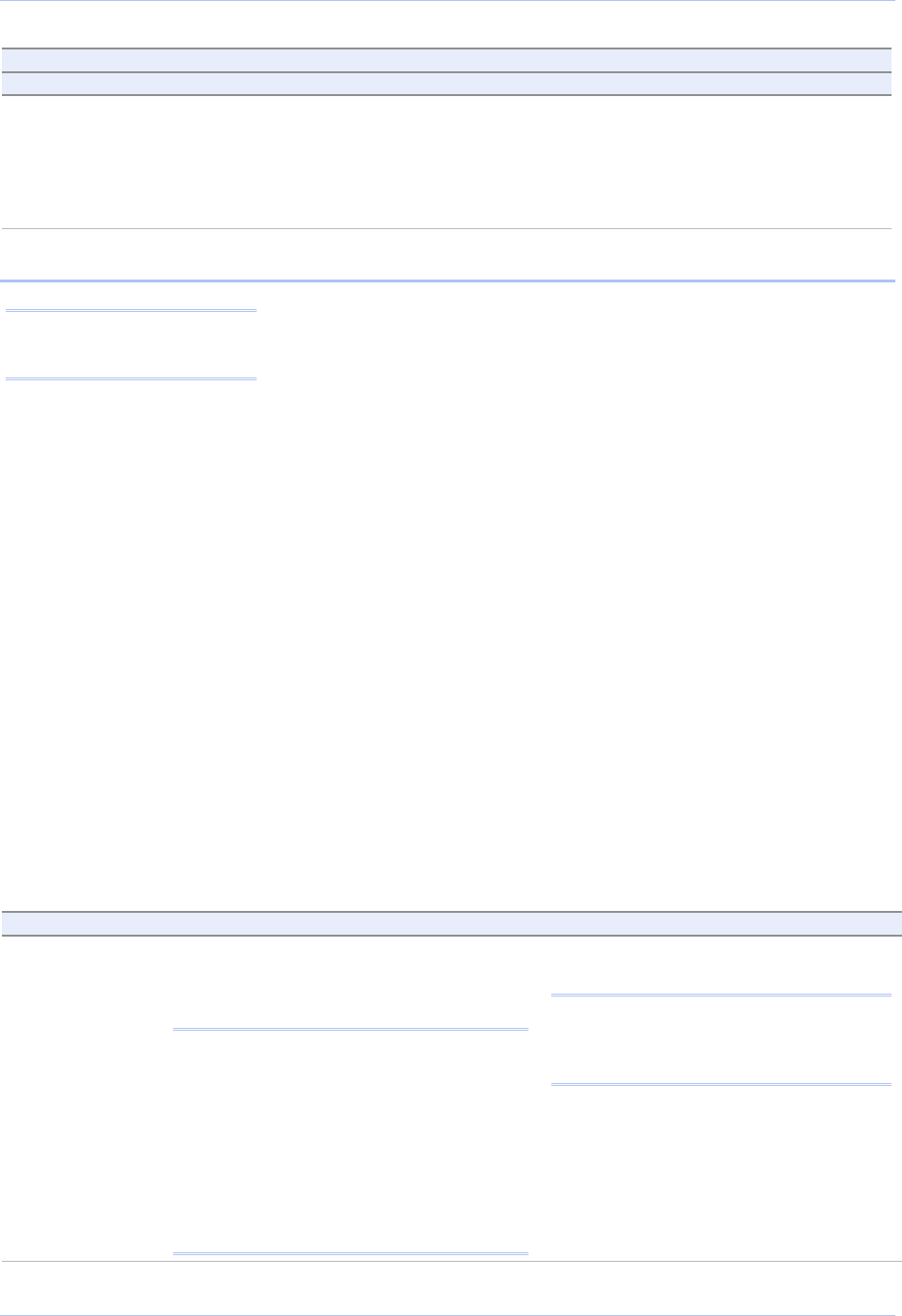
Quatech SDS User’s Manual Configuring the SDS using a Web interface
Rev 1.50 (3/13/2005) Page 65
Step Procedure Description
Step 4 (non-MEI) / Step 5 (MEI) applies to all units
# Step 4
(non-MEI)
or
# Step 5
(MEI only)
Repeat the steps above for each port you
need to configure and then press Save to
implement all of your changes.
Close and re-open the port to activate
your changes.
That’s it! You’re done. Your SDS is
configured for the Raw TCP operating
mode.
Setting Raw UDP operating mode parameters
Raw UDP is mainly used to broadcast messages over a network. It is
a connectionless protocol that offers a direct way to send and receive
datagrams over an IP network but provides very few error recovery
services. UDP applications must generally be willing to accept some
loss, errors, or duplication. Most UDP applications do not require
reliability mechanisms and may even be hindered by them. If your
application requires a high degree of reliability, you should use a
protocol such as TCP.
UDP provides no guarantees for message delivery and a UDP sender
has no way of telling the status of its messages once it sends them
onto the network. For multicast packages, unlimited propagation of
UDP packets through routers is prevented by the Time To Live (TTL)
scheme. Each router decrements a packet’s TTL value and only
forwards those packets whose TTL value is greater than the
threshold configured on the router.
UDP has three possible modes of communication that you select
according to the IP/UDP address you enter:
! Point to point – key in a specific device’s address to communicate
only with that device
! Broadcast – key in the broadcast address of 255.255.255.255 to
send to all devices listening for the transmission
! Multicast – key in an address in the assigned UDP range of
224.0.0.0 – 239.255.255.255 to send to several devices with the
selected address
Step Procedure Description
# Preliminary
Step
Select Serial Ports from the selection
bar.
Note: Setup screens vary slightly between
RS-232 and RS-232/422/485 (MEI) units.
If you have an RS-232/422/485 (MEI) SDS,
the Configure Serial Port Interface step will
display so that you can select between RS-
232 and RS-422/485 operation.
If you have an RS-232 SDS, the Configure
Serial Port Interface step will not display
and you will not be presented with any RS-
422/485 configuration options.
The Serial Port Setup screen shown on
the following page displays.
Note: Click on a link to see a pop-up help
screen for that item. For example, if you
click on the Raw UDP link, the following
help screen pops up.
Note: In Raw UDP, your SDS
can send messages to multiple
receivers simultaneously.

Configuring the SDS using a Web interface Quatech SDS User’s Manual
Page 66 Rev 1.50 (3/13/2005)
Figure 57 - Serial Port Setup screen for Raw UDP mode
Step Procedure Description
# Step 1 Select the serial port you want to
configure.
Click on a port number to select that
port. The selections on the screen are
automatically populated with any
existing parameters for the selected port.
# Step 2 Click on the Raw UDP Operating Mode
selector.
Raw UDP allows an SDS device to
perform one to many transmissions.
You will find directions for configuring
ports in Normal, Tunneling, Raw TCP
and Auto TCP modes mode in the
previous sections.
Note: Click on a link
to see a pop-up help
screen for that item.
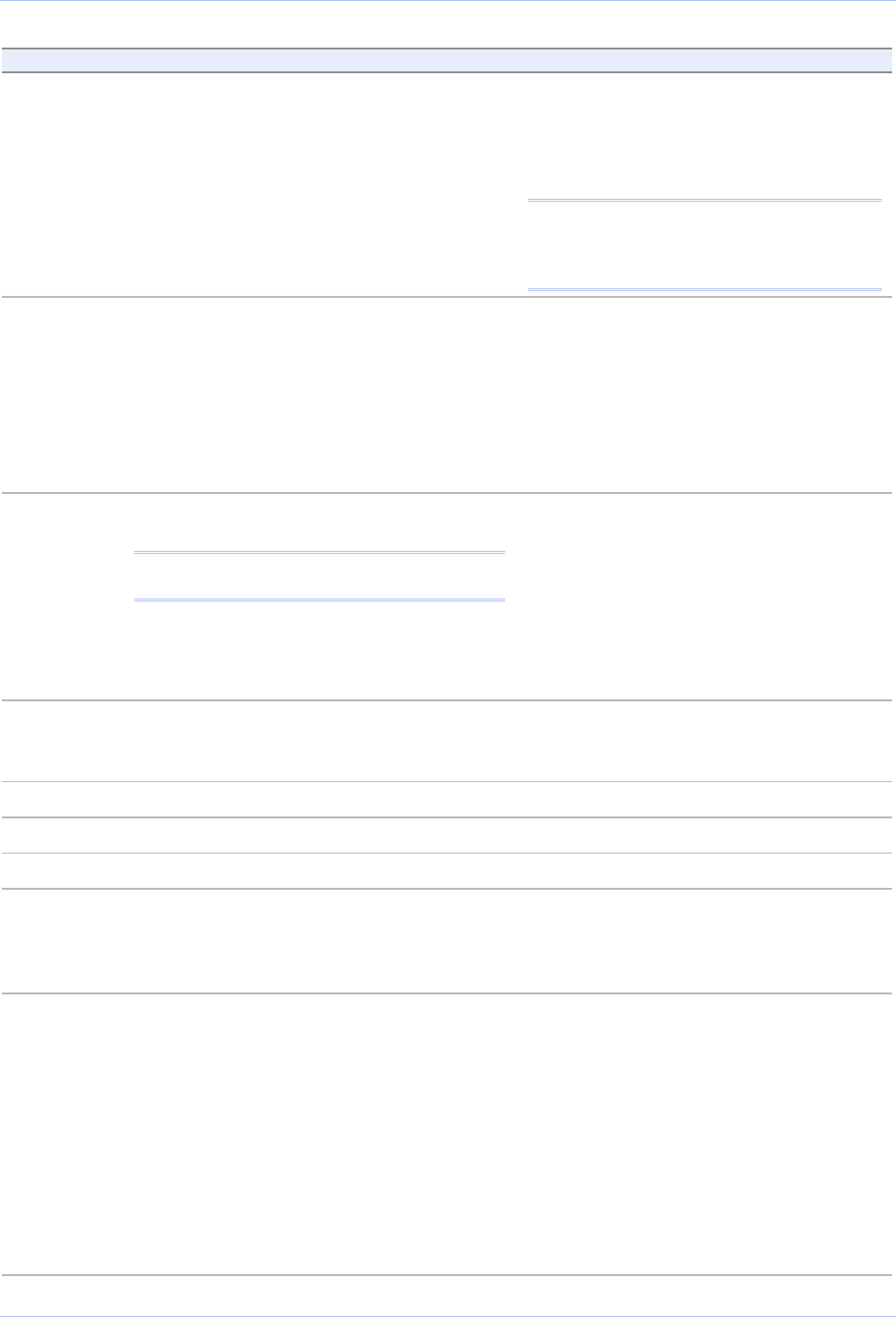
Quatech SDS User’s Manual Configuring the SDS using a Web interface
Rev 1.50 (3/13/2005) Page 67
Step Procedure Description
# Step 3a Configure the Operating mode.
Click on the desired data Rate Multiplier.
Your choices are:
! Auto (Recommended)
! Force X2 mode
! Force X4 mode
! Force X8 mode
The auto setting has no effect on the
baud rate you set. However, if you select
X2, X4, or X8, the baud rate of the serial
port will be the baud rate that you set
multiplied by 2, 4, or 8, respectively.
Note: Forcing a change in the data rate may
cause communication problems with some
serial devices. If this is the case, change the
setting back to Auto (Recommended).
# Step 3b Click on the desired Performance
Selector.
Choose balanced mode except in those
cases where the serial device cannot
tolerate the slight delays inherent in
normal TCP/IP operation.
Balanced mode offers excellent
performance for most applications.
Low Latency mode heavily favors
responsiveness over throughput.
# Step 3c Set the Heart Beat Time to a value from 1
to 65534 seconds. Default is 45 seconds.
Note: Use a value of 0 to disable the heartbeat
timer.
Heartbeat messages help detect when a
connection has been lost between the PC
driver and the SDS.
If you need quick notification that the
connection has been lost, set this timer to
a shorter value.
If you are more concerned about network
traffic, set this timer to a longer value.
# Step 3d Set the Baud Rate. The SDS and the serial device(s) to
which it is attached must use the same
serial connection speed.
# Step 3e Set the Parity. Parity can be odd, even, or none.
# Step 3f Set the Data Bits. Data Bits can be 7 or 8.
# Step 3g Set the Stop Bits. Stop Bits can be 1 or 2.
# Step 3h Set the Flow Control. Flow control determines the handshake
method used between the SDS and the
serial device(s) to stop the serial
input/output process
# Step 3i Set the UDP/IP Address.
These are your options:
! Multicast
! Broadcast
! Point to point
This selection determines the destination
IP address where data will be sent.
For multicast, enter a valid multicast IP
address (244.0.0.0 – 239.255.255.255) to
broadcast data to a specific multicast group.
For broadcast, enter 255.255.255.255 to
broadcast the serial data to all devices
ready to accept data.
For point to point, enter a specific
address to which the SDS can send UDP
packets containing serial data.

Configuring the SDS using a Web interface Quatech SDS User’s Manual
Page 68 Rev 1.50 (3/13/2005)
Step Procedure Description
# Step 3j Set the UDP port designation. Enter a valid UDP port number to which
the SDS can send. The SDS will receive
on both port 5000 and on the designated
serial port number.
# Step 3k Set the TTL value. This selection sets the TTL (Time To
Live) value for multicast packets. Each
router decrements the TTL value of the
packet and will only forward a packet if
its value is greater than the threshold
configured on the router. The following
are standard settings:
! 0 Restricted to host
! 1 Restricted to subnet
! 15 Restricted to site
! 63 Restricted to region
! 127 Worldwide
! 255 Unrestricted
Steps 4a through 4d apply only to RS-232/422/485 (MEI) units
# Step 4a
(MEI only)
Configure the serial port interface.
Click on the desired interface selector.
This series of steps only applies to MEI
units, such as the SSE-400.
If you select RS232, the RS422/485
selections will be grayed out. Continue
with □ Step 5.
# Step 4b
(MEI only)
Click on the desired duplex mode selector. Select Full Duplex to always enable
transmit and receive drivers.
Select Half Rx to only enable the
transmit drivers when the SDS is
transmitting; receivers always enabled.
Select Half Rx Tog to disable receivers
and enable the transmit drivers only
when the SDS is transmitting.
# Step 4c
(MEI only)
Click on the desired connector setup. Select Loopback All to internally loopback
RTS and CTS in the SDS. AuxIn and
AuxOut are looped at the connector.
Select Modem Control to send RTS on
the AuxOut signal and to receive CTS on
the AuxIn signal.
# Step 4d
(MEI only)
Select 2- or 4-wire communication. Select 2-wire to use the transmit pair for
both transmit and receive in RS-422/485.
Select 4-wire to use a separate pair of wires
for transmit and receive in RS-422/485.
Step 4 (non-MEI) / Step 5 (MEI) applies to all units
# Step 4
(non-MEI)
or
# Step 5
(MEI only)
Repeat the steps above for each port you
need to configure and then press Save to
implement all of your changes.
Close and re-open the port to activate
your changes. That’s it! You’re done.
Normal is the most common operating
mode and the easiest to set up.

Quatech SDS User’s Manual Configuring the SDS using a Web interface
Rev 1.50 (3/13/2005) Page 69
Running diagnostic tests
Using the Port Status screen
Step Procedure Description
# Preliminary
Step
Click on Diagnostics from the selection
bar.
The Port Status screen displays.
Figure 58 - Port Status screen
Step Procedure Description
# Step 1 Select the desired port. Click on the port number.
# Step 2 Press the Clear key to reset the selected
port.
Pressing Clear lets you halt an
unresponsive communications link.
Use this procedure to free a com port
that locks up. Note that the data trying
to get through that port is lost and will
need to be resent.
Running the Ping test
Step Procedure Description
# Preliminary
Step
Click on Diagnostics from the selection
bar and then click on either of the Ping
Test selections from the left panel.
The Ping Test screen displays.
Figure 59 - Ping Test screen
Step Procedure Description
# Step 1 Enter the IP address of a device that is
connected to the network.
This can be a PC or other device.
Use the Ping test to verify connectivity
between the SDS and another device on
the network as specified by the IP
address field.
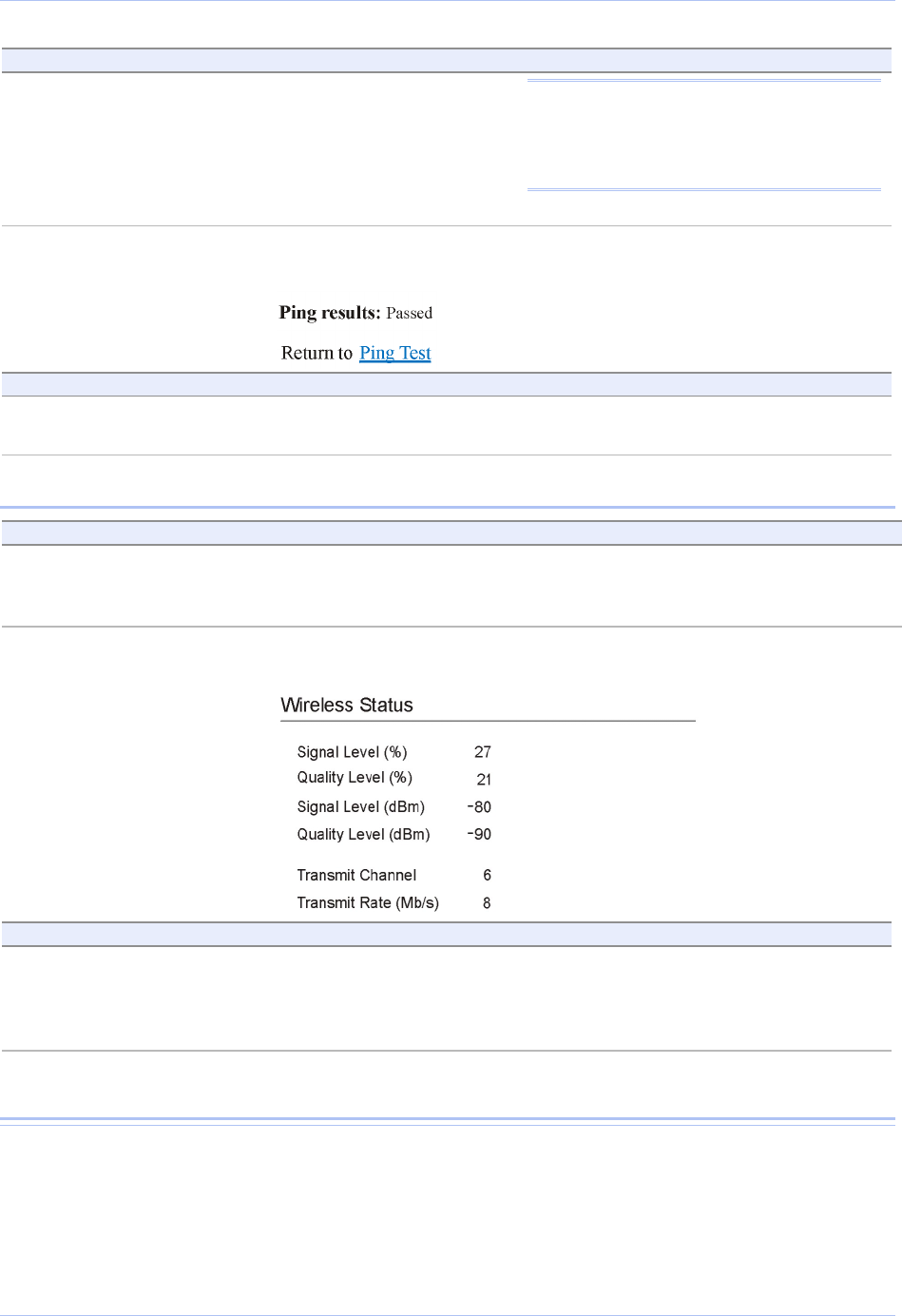
Configuring the SDS using a Web interface Quatech SDS User’s Manual
Page 70 Rev 1.50 (3/13/2005)
Step Procedure Description
Press Ping to run the test.
Note: This utility is not intended to ping the
SDS from a PC, but for the SDS to ping a
PC or other device. To ping the SDS from a
PC on the network, use the ping command
from a DOS command line.
The Ping results screen displays.
Figure 60 - Ping results screen
Step Procedure Description
# Step 2 Press the Ping Test link to return to the
Ping Test screen.
You can also press the Backspace key to
return to the Ping Test screen.
Checking wireless status
Step Procedure Description
# Preliminary
Step
Click on Diagnostics from the selection
bar and then click on Wireless Status
from the left panel.
The Wireless Status screen displays.
Figure 61 – Wireless Status screen
Step Procedure Description
# Step 1 The wireless status displays the current
channel, the bit rate, and a set of metrics
that give an indication of the quality of
the wireless connection
Performing administrative functions
The Admin functions let you update the software, assign a descriptive
name to the SDS, and manage users (control who can access the SDS
from the Web interface). You can access these functions by selecting
Admin from the selection bar.
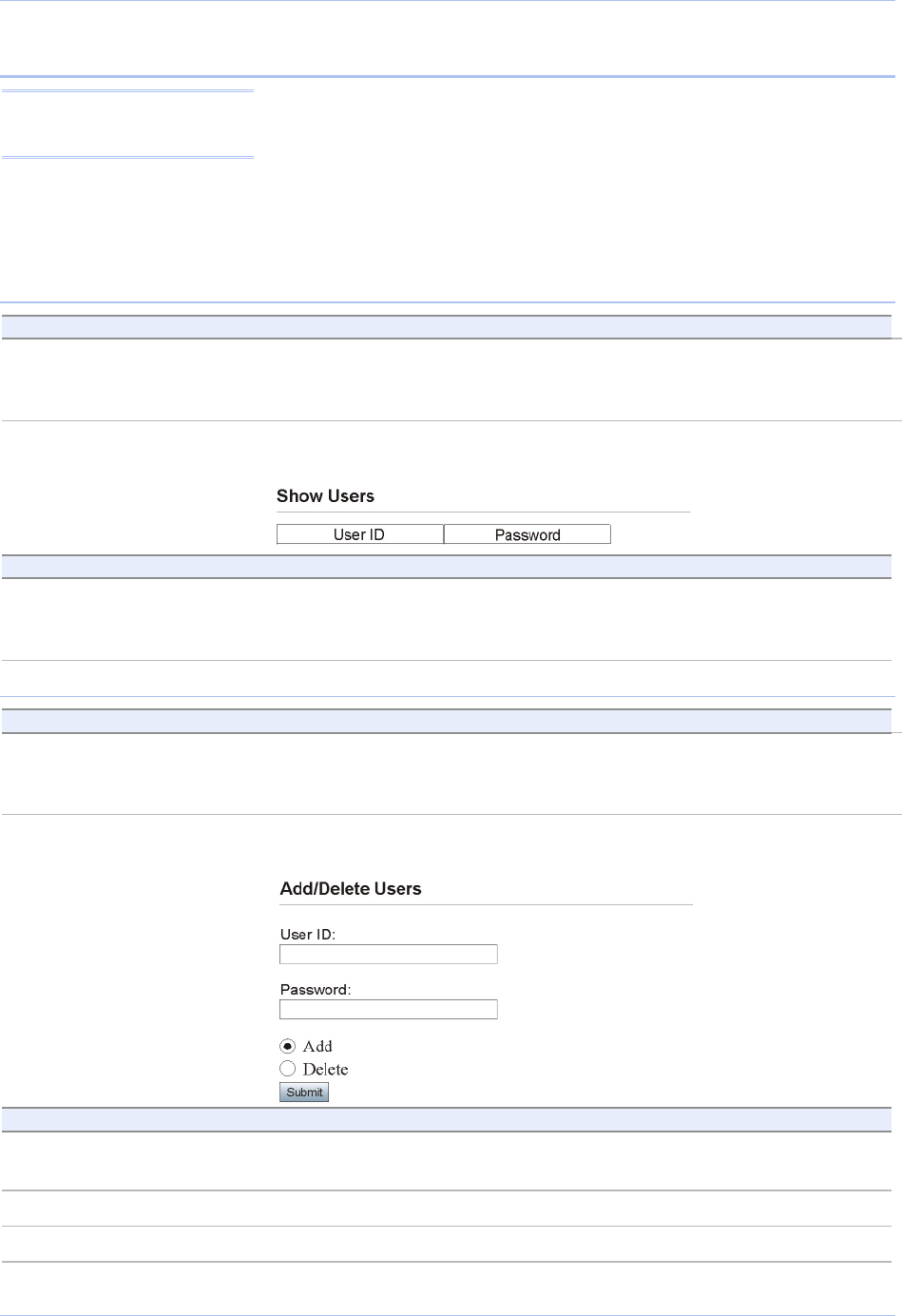
Quatech SDS User’s Manual Configuring the SDS using a Web interface
Rev 1.50 (3/13/2005) Page 71
Managing users
Initially, the SDS is configured to have no exclusive users. This
means that anyone with the device drivers installed and who knows
the SDS’ IP address can use the Web interface to configure and
manage the SDS.
You can create users to restrict this type of access to approved
personnel only. Once you create a user, only someone using that user
ID and password has Web access to the SDS.
Showing users
Step Procedure Description
# Preliminary
Step
Click on Admin in the selection bar and
then select Show Users from the left
panel.
The Show Users screen displays.
Passwords appear as asterisks.
Figure 62 - Show Users screen
Step Procedure Description
# Step 1 Make note of any users you want to add
or delete. Select Add/Del Users to add or
remove users.
Write down the user’s name exactly as it
appears including any spaces.
Adding users
Step Procedure Description
# Preliminary
Step
Click on Admin in the selection bar and
then select Add/Del User from the left
panel.
The Add/Del Users screen displays.
Figure 63 - Add/Del Users screen
Step Procedure Description
# Step 1 Enter the user name and password in the
boxes provided.
Passwords appear as asterisks.
# Step 2 Select the Add option.
# Step 3 Press the Submit key. A network confirmation prompt displays.
Note: You can create a
maximum of ten users for each
SDS.
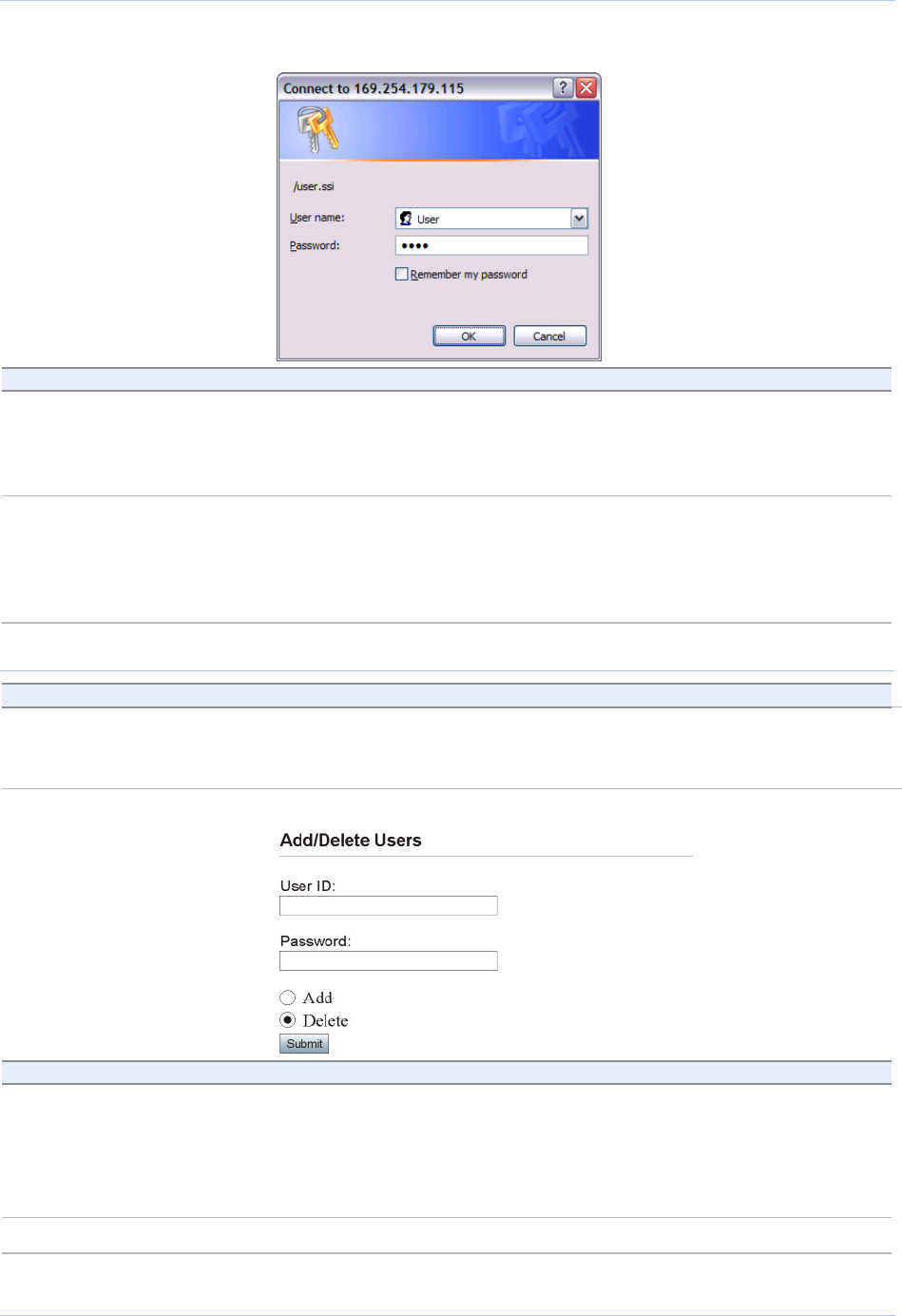
Configuring the SDS using a Web interface Quatech SDS User’s Manual
Page 72 Rev 1.50 (3/13/2005)
Figure 64 - Network confirmation prompt
Step Procedure Description
# Step 4 Enter the user name and password in the
boxes provided.
If desired, check the Remember my
password box.
Be sure to key in the name and password
in exactly as you did in the Add/Del
Users screen. Both are case-sensitive.
# Step 5 Click OK. You can now view the new user name
and password by selecting Show Users
from the Admin screen. Be sure to record
the user name and password in a safe
place.
Deleting users
Step Procedure Description
# Preliminary
Step
Click on Admin in the selection bar and
then select Add/Del User from the left
panel.
The Add/Del Users screen displays.
Figure 65 - Add/Del Users screen
Step Procedure Description
# Step 1 Enter the user name and password in the
boxes provided.
Be sure to enter them exactly as they
were originally keyed in when the user
was added. Both the user ID and the
password are case-sensitive.
Passwords appear as asterisks.
# Step 2 Select the Delete option.
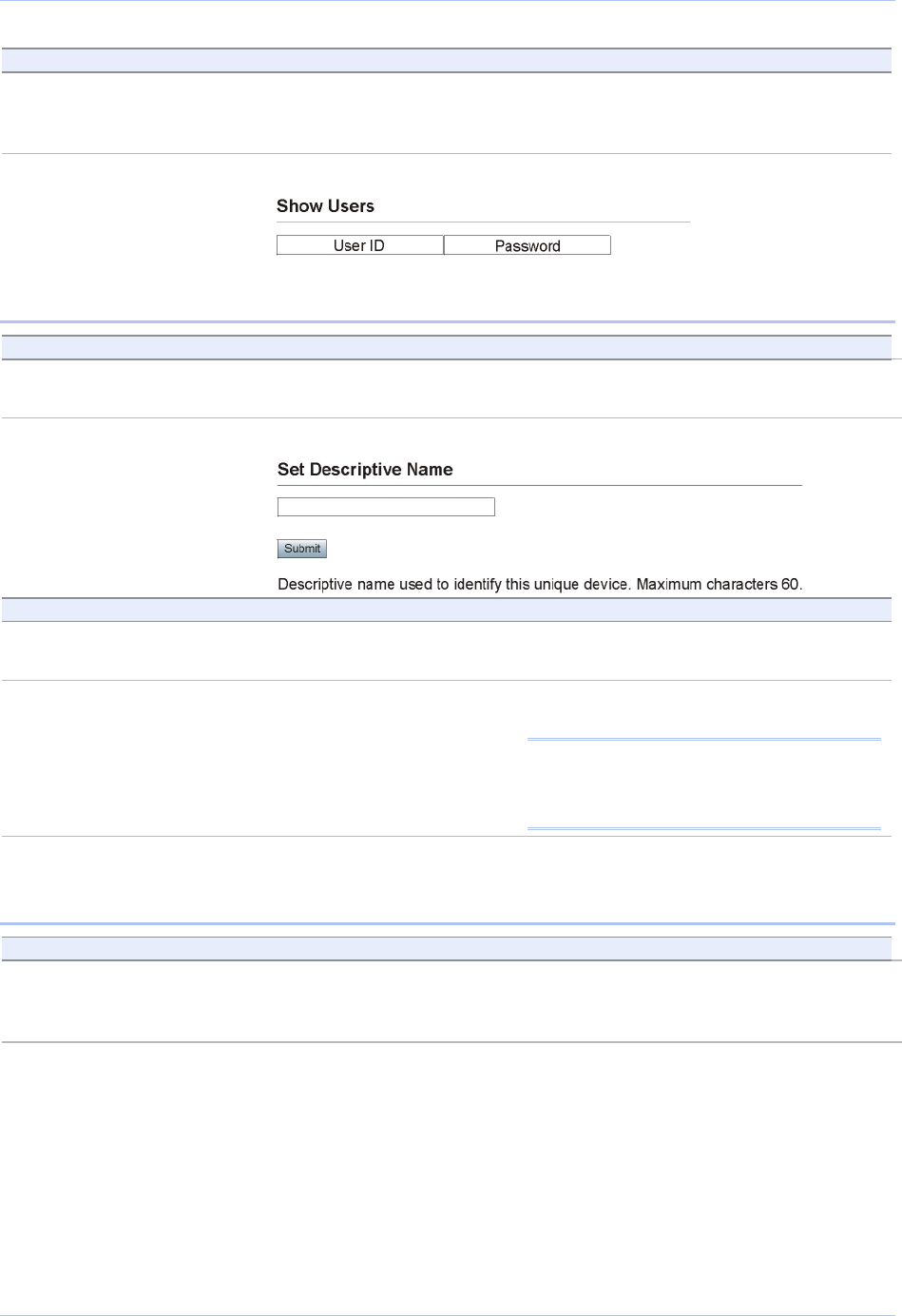
Quatech SDS User’s Manual Configuring the SDS using a Web interface
Rev 1.50 (3/13/2005) Page 73
Step Procedure Description
# Step 3 Press the Submit key. You can confirm the deletion of this user
by selecting Show Users from the Admin
screen. See below.
Figure 66 - Show Users screen
Giving the SDS a descriptive name
Step Procedure Description
# Preliminary
Step
Click on Admin in the selection bar. The Set Descriptive Name screen
displays.
Figure 67 - Set Descriptive Name screen
Step Procedure Description
# Step 1 Enter a unique name for this SDS that is
descriptive of its function or location.
Use a maximum of 60 valid characters
(a-z, 0-9, and space).
# Step 2 Press Submit. Your SDS’ name now appears at the
bottom of the Home page screen.
Note: You can change or delete the name of
your SDS by returning to the Set Descriptive
Name screen and either changing or deleting
the name and then pressing Submit.
Upgrading firmware
Step Procedure Description
# Preliminary
Step
Click on Admin in the selection bar and
then select Upgrade Firmware from the
left panel.
The Upgrade Firmware screen
displays.

Configuring the SDS using a Web interface Quatech SDS User’s Manual
Page 74 Rev 1.50 (3/13/2005)
Figure 68 - Firmware Upgrade screen
Step Procedure Description
# Step 1 Browse to the location with the revised
firmware file.
Most of Quatech’s device drivers are
available from our Web site.
# Step 2 Press Send File. The Remote Reset screen displays.
Figure 69 - Remote Reset
Step Procedure Description
# Step 3 Press Reset to reset your SDS. The SDS must be reset to implement the
new firmware.
Contacting Quatech
Step Procedure Description
# Step 1 From the Home screen, select Contact Us. The Contact Us screen displays.
Figure 70 - Contact Us screen
Note: Only SDS devices with a
firmware revision level of 5.0
and above can support SNMP.
Determine the revision level of
an SDS (check the bottom of
the Home page in the Web-based
interface) before upgrading the
firmware.

Quatech SDS User’s Manual Configuring the SDS using a Web interface
Rev 1.50 (3/13/2005) Page 75
Step Procedure Description
# Step 2 Click on either the sales or support Email
links to contact the Sales or Technical
Support departments, respectively.
This screen provides Quatech’s:
! Address
! Phone and fax numbers
! E-mail address for Sales
! E-mail address for Technical
Support
! Web site address
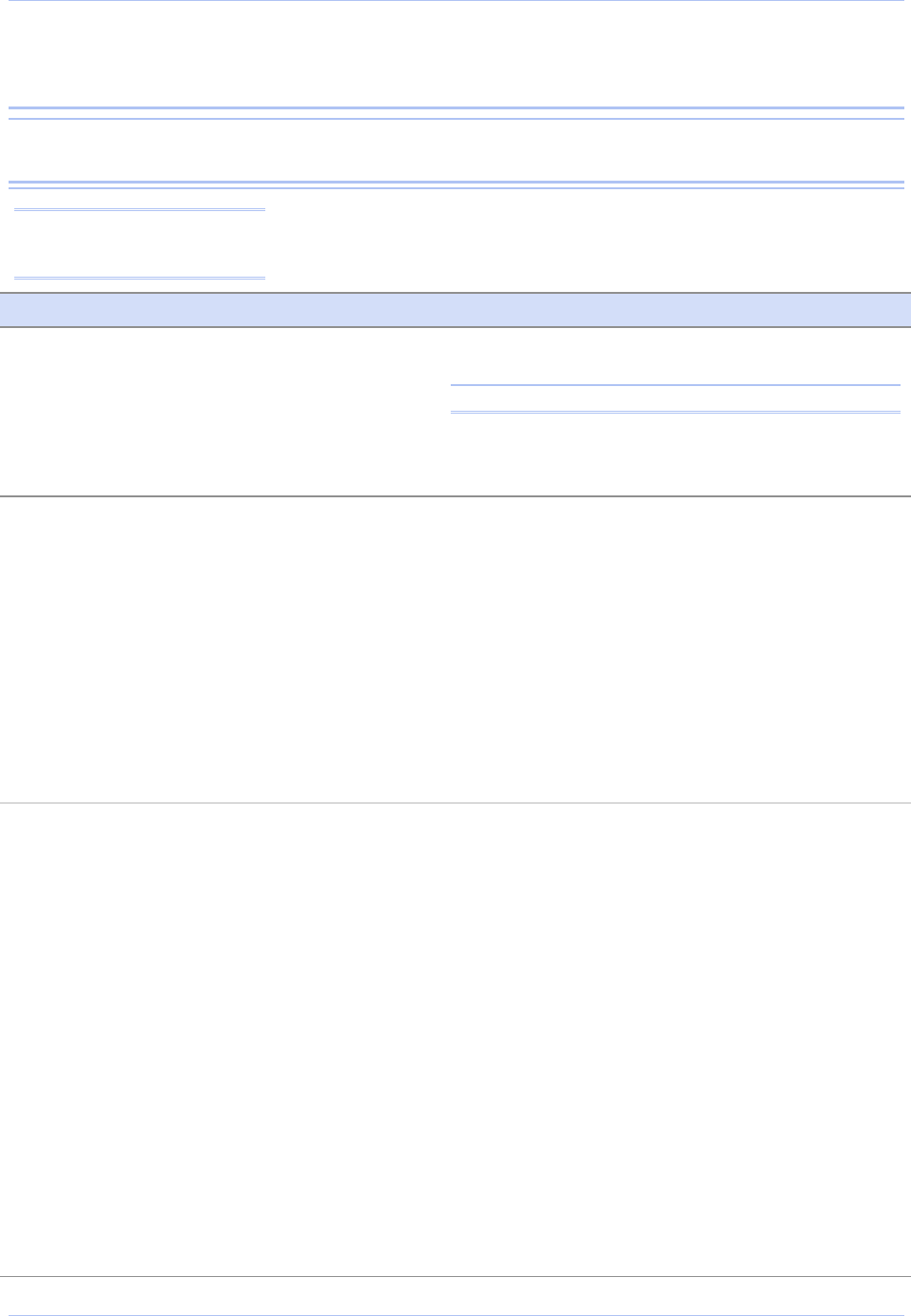
Troubleshooting and Maintaining an SDS Quatech SDS User’s Manual
Page 76 Rev 1.50 (3/13/2005)
Troubleshooting and Maintaining an SDS
Troubleshooting an SDS
This section lists some common problems and their causes. If the
information below does not provide a solution, contact Quatech
technical support.
Problem Cause Solution
The SDS does not
turn on and no
LEDs light up.
!
The SDS or the
power source is
damaged, or the SDS
does not have power.
1. Make sure that the power source is properly
connected to the SDS’ power jack.
Caution! Only use the Quatech +5 V power source.
2. Make sure the power adapter is connected to a
functioning electrical outlet.
3. Contact Quatech tech support.
The serial device
will not respond
even though the
SDS is functioning.
! The serial device is
not powered up; the
serial cable is
wrong/damaged, or
the serial port
settings are wrong.
1. Make sure the serial device is powered up.
2. Make sure the serial cable is properly
connected to the serial device and to the SDS.
3. Verify the cable pinouts.
4. Try a different serial cable.
5. Try a different port on the SDS.
6. Review your serial device literature. Make sure
the settings it specifies match those the SDS is
using (check the SDS serial port settings using
the Web interface).
7. Try plugging the serial device directly into a
PC.
The search utility
does not find the
SDS.
Could be due to a
variety of causes:
! Check power
!
Check status
Verify that the blue Power LED is lit.
If the Power LED is not lit,
1. Check the power connection.
2. If power is connected properly, contact Quatech
tech support.
Verify that the green Status LED is lit.
If the Status LED is not lit,
1. Check the firmware version.
a. If the SDS firmware has been upgraded
from the factory default, reset the SDS to
the factory default. See page 9.
b. If the procedure to return to factory default
fails, contact Quatech tech support.
2. Cycle power on the box and wait approximately
30 seconds. If the Status LED still does not
light, contact Quatech tech support.
Note: Any unauthorized repairs
or modifications will void the
SDS' warranty.

Quatech SDS User’s Manual Troubleshooting and Maintaining an SDS
Rev 1.50 (3/13/2005) Page 77
Problem Cause Solution
The search utility
does not find the
SDS, cont.
!
Check LAN
!
Check subnet
Verify that the link status light under the LAN
connection is lit. If it is not lit,
1. Check to see if the LAN patch cable is fully
seated at both ends.
2. Make sure the hub is powered up and
functioning.
3. Try another port on the hub.
4. Try another patch cable.
5. Contact Quatech tech support.
Verify that the SDS and the PC from which the
search is being performed are on same subnet.
Note: There should be nothing other than a hub or a
switch between the PC and SDS.
1. Check with the network administrator to verify
that the SDS and the PC are on same subnet.
2. If you are unsure of the subnet, check the IP
address of the PC (by running ipconfig in a
command box) against the IP address of
another PC plugged into the same hub as SDS.
3. If the PC and SDS are on same subnet but a
search still fails, connect the SDS directly to
the PC using a crossover cable (if supplied;
otherwise, use any Ethernet cable) and the
instructions provided.
4. Contact Quatech tech support.
Web Browser does
not display the SDS
home page.
!
Check Web
connection
Use Ping to verify the connection.
1. If Ping fails:
a. Find the SDS using the search utility.
Display the network settings.
1. Is subnet mask OK?
2. Is Gateway address OK?
3. Is IP address OK?
b. Can the PC ping another device on the
same subnet as the SDS?
1. No: Correct the PC setup and then
retry.
2. Yes: Contact Quatech tech support.
2. If Ping passes:
a. Is Internet Explorer setup to use proxy
server? If yes, disable the proxy server and
retry.
b. Is a supported browser being used?
1. No: Install and use supported browser.
2. Yes: Contact Quatech tech support.

Troubleshooting and Maintaining an SDS Quatech SDS User’s Manual
Page 78 Rev 1.50 (3/13/2005)
Problem Cause Solution
Your application
cannot open the
COM port
!
Wrong COM port
number or other
COM port-related
problem; problem
with application
1. Is the application set up to use the correct
COM port number?
a. No – Select correct COM port number.
b. Yes – Continue with step 2.
2. Does COM port(s) show up in Device Manager?
a. No – Go through the installation process,
then verify that the COM port(s) shows up in
Device Manager.
b. Yes – In Device Manager, open the
properties page under Multi-port Serial
Adapters for the SDS and go to the SDS
Configuration tab.
3. Does the auto query that runs when you select
the SDS Configuration tab find the device?
a. Yes – Continue with step 3: Try to open the
COM port in HyperTerminal.
b. No - Verify that the MAC address, IP
address, Subnet mask, and gateway
address are correct for the SDS being used.
If not, click on the Advance button and use
the search utility to select the correct SDS
and set these parameters.
Retry to see if the application will open the
port.
4. Try to open the COM port in HyperTerminal.
a. Port opens: There is a problem with your
application that is beyond scope of this
troubleshooting guide.
b. Port does not open: You require help that is
beyond the scope of this troubleshooting
guide. Contact Quatech tech support.
Application can
open COM port but
data will not
transfer.
!
Check COM port in
HyperTerminal
Using HyperTerminal, open the selected COM
port.
1. Place a loopback connector on the selected
COM port.
2. Set the communication parameters.
3. Type random characters. Does the screen show
these characters echoed back?
a. Yes - The port is functioning.
b. No - Try another port. If the characters
still are not echoed back, contact Quatech
tech support.
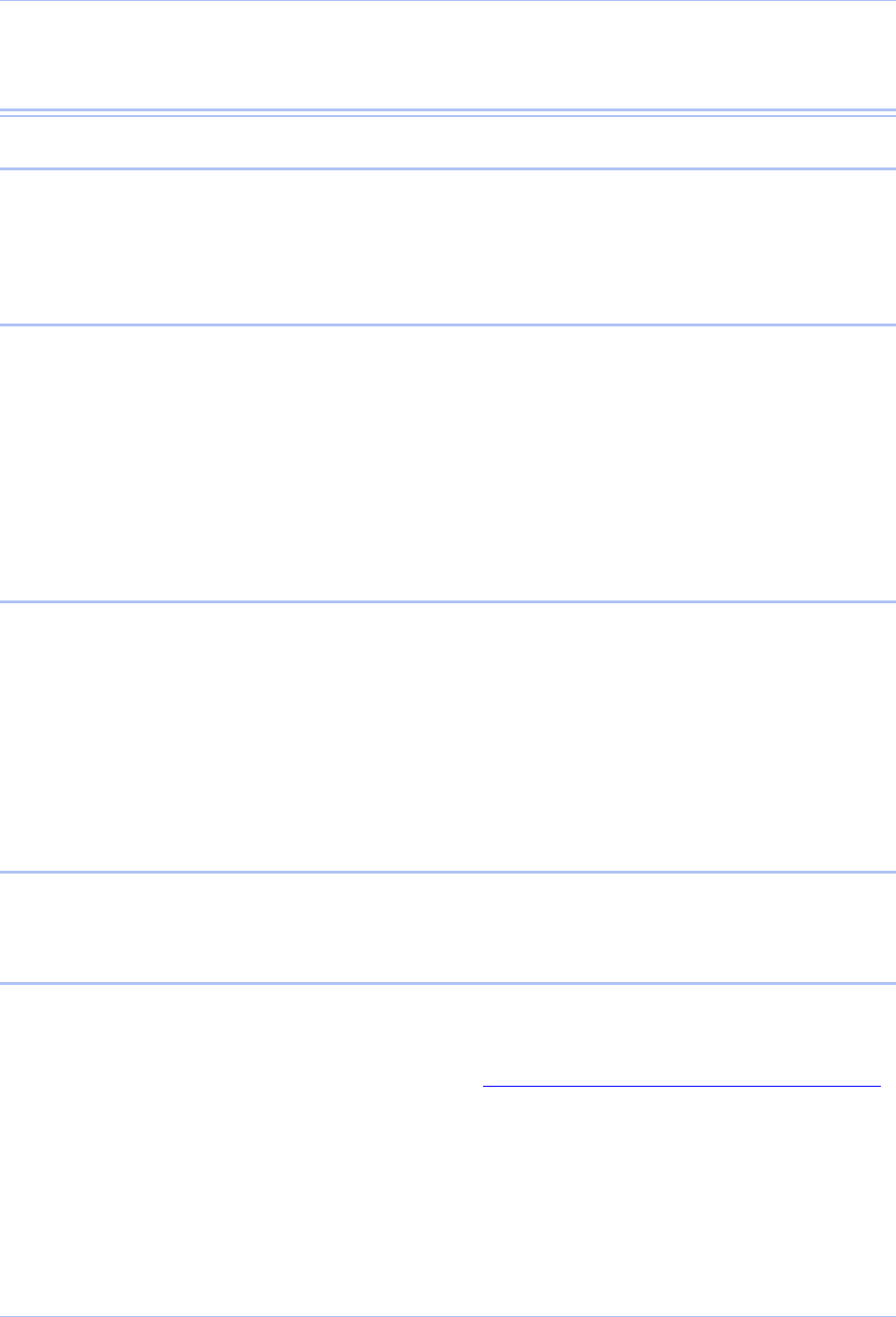
Quatech SDS User’s Manual Troubleshooting and Maintaining an SDS
Rev 1.50 (3/13/2005) Page 79
Maintaining an SDS
Operating conditions
The SDS series is designed to work in environments that are free
from dust, dirt, and moisture. You can operate an SDS at
temperatures between 0° to 70°C. Do not leave an SDS where
moisture can condense on it.
Handling the SDS
The following information can help you to use the SDS in a reliable,
trouble-free manner.
! Make sure the SDS is off before you connect or remove the
Ethernet cable.
! Make sure that all serial devices are connected correctly.
! Protect the SDS from excessively dirty or damp conditions.
! Do not drop, strike, or handle the SDS roughly. Handle it like any
other piece of sensitive electronic equipment.
Moving the SDS
Follow these steps if you need to move your SDS or prepare it for
shipment.
! Disconnect the power cable.
! Disconnect all other cables.
! If you are shipping the SDS, use the original packing material
and container. If you no longer have the original packaging, use a
sturdy carton and sufficient packing material to protect the SDS
during shipment.
Cleaning the SDS
Clean the outside of the SDS as needed with a slightly moist soft
cloth. Do not use solvents or abrasive cleaners.
Servicing the SDS
There are no user-serviceable parts in the SDS. Contact Quatech for
repair. Be sure to obtain an RMA number from Quatech technical
support before returning your SDS for service.
Support Request Form: http://www.quatech.com/support/support.php

Appendix A Quatech SDS User’s Manual
Page 80 Rev 1.50 (3/13/2005)
Appendix A
Specifications
Size
Product Size
SSE/DSE-100/400 4.65” x 3.73” x 1.15” (11.8 x 9.47 x 2.92 cm)
QSE-100 11.55” x 6.27” x 1.71” (29.3 x 15.9 x 4.34 cm)
ESE-100 11.55” x 6.27” x 1.84” (29.3 x 15.9 x 4.67 cm)
LAN interface 10/100 Base T (IEEE 802.3), auto-negotiation and auto MDI/MDIX.
RJ-45 Network connector
Serial interface
! Fully independent ports on multiport models
! DB-9 male, DTE configuration
! “M” models (e.g. QSE-100M) are supplied with 10-pin RJ-45
adapters that attach to the DB-9 connectors
! “W” models (e.g. DSEW-100) are supplied with Wi-Fi transceivers
and capabilities
! Hardware flow control
! Full modem control
RS-232 (EIA-232)
RS-232/422/RS-485 RS-232 # Serial ports RS-232/422/485
SSE-100 1 SSE-400
DSE-100 2 DSE-400
QSE-100 4 QSE-400
ESE-100 8 ESE-400
Parity, Stop bits: Parity configurable as: None, Even, Odd
Data bits configurable as: 5, 6, 7, 8
Stop bits configurable as: 1, 1.5, 2
Speed: Each serial port supports data transfer speeds of up to 921.6 kbps,
depending on flow control protocols used, cable length and condition,
and other factors. The aggregate throughput of all ports on any given
Device Server may not exceed 4 Mbps.
Note: The surge suppression (–SS) option reduces effective baud
rates to 115.2 Kbps maximum on each port. Please contact Technical
Support at support@quatech.com for additional information.

Quatech SDS User’s Manual Appendix A
Rev 1.50 (3/13/2005) Page 81
Signals:
RJ-45:
DB-9:
View looking into
the connector
View looking into
the connector
RS-232
signal Pin # RS-422/485 signal,
4-wire mode RS-422/485 signal,
2-wire mode
RI 1
TxD– Transmit/Receive Data (Data–)
RTS 2 AuxOut+ N/C
DTR 3 AuxOut– N/C
GND 4 GND Signal Ground (GND)
TxD 5 TxD+ Transmit/Receive Data (Data+)
RxD 6 RxD+ N/C
DCD 7 AuxIn– N/C
DSR 8 RxD– N/C
CTS 9 AuxIn+ N/C
N/C 10
N/C N/C
RS-232
signal Pin # RS-422/485 signal,
4-wire mode RS-422/485 signal,
2-wire mode
DCD 1 AuxIn– N/C
RxD 2 RxD+ N/C
TxD 3 TxD+ Transmit/Receive Data (Data+)
DTR 4 AuxOut– N/C
GND 5 GND Signal Ground (GND)
DSR 6 RxD– N/C
RTS 7 AuxOut+ N/C
CTS 8 AuxIn+ N/C
RI 9 TxD– Transmit/Receive Data (Data–)

Appendix A Quatech SDS User’s Manual
Page 82 Rev 1.50 (3/13/2005)
Transmitter outputs
RS-232:
High Level Output: +5 V (min), +5.4 V (typical)
Low Level Output: –5 V (min), –5.4 V (typical)
Transmitter Skew: 50 ns (typical), 200 ns (max)
RS-422/485:
Transmitter Outputs: 2 V (min) for 100 Ohm load
Transmitter Skew: 5 ns (typical), 10 ns (max)
Distance: 4000 feet
Receiver inputs:
RS-232:
Input Voltage Rating: –15 V to +15 V
Receiver Skew: 120 ns (typical), 250 ns (max)
RS-422/485:
Input Voltage Rating: –15 V to +15 V Common Mode Input Voltage
Receiver Skew: 13 ns (typical)
Surge suppression option Surge suppressor is applied to each line; capable of sustaining up to
40-A peak, 8 x 20-µs transient surges, a clamping voltage of 30 V (RS-
232) or 15.5 V (RS-422/485), and a peak energy dissipation of 0.1
Joules.
Note: Units with the "SS" option are limited to 115.2 kbps due to
capacitive loading.
Protocols and software Quatech provides several ways to manage and configure SDS after
installation:
a. Windows Device Manager (Quatech Device Manager on
Windows NT4)
b. On-board utility accessible from a standard HTTP web
browser.
c. Simple Network Management Protocol (SNMP)
d. IntelliSock TCP socket services
Management UDP, TCP/IP, HTTP, DHCP, ARP, SNMP
IP configuration DHCP, Static IP (set through SDS Installation Wizard) or custom
UDP datagram utility
Communication modes Normal, Tunneling, Raw TCP, Auto TCP, Raw UDP
Client OS support Device drivers provided for Windows 2000, Windows XP, Windows
NT4, and Linux
Other operating systems supported by IntelliSock TCP socket
services
Check Website for latest OS support information

Quatech SDS User’s Manual Appendix A
Rev 1.50 (3/13/2005) Page 83
Hardware Processor: Freescale / Motorola Power PC
SDRAM: 8 MB
FLASH Memory: 2 MB
FLASH is field upgradeable over Ethernet connection
Switches
4- and 8-port units: On back panel:
! Reset: Resets the unit and does a hard reboot.
User data in volatile memory cleared.
System configuration unchanged.
! Default: Activated by pressing and holding Default, then pressing
and releasing Reset. See Indicators below and on the following
page for details.
Status slow flash: User data in memory is cleared.
Status fast flash: System firmware reverts to the factory default.
1- and 2-port units: On back panel:
! Reset: Resets the unit and does a hard reboot.
User data in volatile memory cleared.
System configuration unchanged.
If held until Status LED flashes slowly and then released:
User data in memory is cleared and configuration is reset to
factory default settings
If held until Status LED flashes quickly and then released:
User data in memory is cleared and system firmware reverts to the
factory default
Indicators
4- and 8-port units: On front panel (appearing top to bottom)
! Power: On when unit has power
! Link: Network connection
ON = connected to network; OFF = not connected
! Speed: Speed of network connection
ON = 100 Mbps; OFF = 10 Mbps
! Data: Normally off while not receiving or sending any traffic on
the serial link.
Flashes on for 100 ms upon sending or receiving any serial traffic.
Flashes at a 200 ms periodic rate once traffic is above 5 messages
per second.
On rear panel (by the Reset switch)
! Status: Off until box is running then turned on.
If the Default button is pushed in and held and then Reset is
pushed and released, the following occurs:
1. Status LED flashes at a rate of 1 flash every 2 seconds for 10
seconds (slow flash).
If Default button is released during this time period, the
configuration is reset to factory defaults; then the SDS
automatically restarts.

Appendix A Quatech SDS User’s Manual
Page 84 Rev 1.50 (3/13/2005)
2. If Default button is held past the first 10 seconds, the LED
starts to flash at a rate of 1 flash per second for 10 seconds
(fast flash).
If Default button is released during this time period, the SDS
is reset back to factory default firmware revision; then the
SDS automatically restarts.
3. If Default button is held past the first 20 seconds, the LED
stops flashing.
If Default button is released during this time period, the SDS
resets but the configuration is unchanged.
1- and 2-port units: All LEDs have the same definitions as above and are located as
indicated below:
! Power – top cover
! Link – left side of Ethernet connector
! Speed – right side of Ethernet connector
! Data – next to DB-9 serial port(s)
! Status – next to power jack
Power supply DC input, with AC Adapters provided for 100VAC–240VAC, 50Hz–
60Hz, Autosensing.
+5V, 2A (10W) max
Environment Operating: 0° C to 70° C
Storage: –40° C to 70° C
Relative Humidity: 10% to 90% non-condensing
Certifications FCC, CE

Quatech SDS User’s Manual Appendix B
Rev 1.50 (3/13/2005) Page 85
Appendix B
Declaration of Conformity
Manufacturer's Name Quatech Inc.
Manufacturer's Address: 5675 Hudson Industrial Parkway
Hudson, Ohio 44236-5012 (USA)
Application of Council Electromagnetic Compatibility (EMC) 89/336/EEC
Directive:
Standards to which EN55022, 1988
Conformity is Declared: EN55024, 1998
Type of Equipment: Information Technology Equipment
Equipment Class: Commercial, Residential, & Light Industrial Equipment
Product Names: SSE-/DSE-/QSE-/ESE-100D: One-/two-/four-/eight-port RS-232 Serial
Device Server with DB-9 connector(s)
SSE-/DSE-/QSE-/ESE-400D: One-/two-/four-/eight-port RS-232/422/485
Serial Device Server with DB-9 connector(s)
SSEW-/DSEW-/QSEW-/ESEW-100D: One-/two-/four-/eight-port RS-232
Serial Device Server with DB-9 connector(s) and Wi-Fi capabilities
SSEW-/DSEW-/QSEW-/ESEW-400D: One-/two-/four-/eight-port RS-
232/422/485 Serial Device Server with DB-9 connector(s) ) and Wi-Fi
capabilities
SSE-/DSE-/QSE-/ESE-100M: One-/two-/four-/eight-port RS-232 Serial
Device Server with RJ-45 adapters for DB-9 connector(s)
SSE-/DSE-/QSE-/ESE-400M: One-/two-/four-/eight-port RS-232/422/485
Serial Device Server with RJ-45 adapters for DB-9 connector(s)
Model Numbers: DB-9: SSE-100D, DSE-100D, QSE-100D, ESE-100D,
SSE-400D, DSE-400D, QSE-400D, ESE-400D,
SSEW-100D, DSEW-100D, QSEW-100D, ESEW-100D,
SSEW-400D, DSEW-400D, QSEW-400D, ESEW-400D,
RJ-45: SSE-100M, DSE-100M, QSE-100M ESE-100M
SSE-400M, DSE-400M QSE-400M ESE-400M
Year of Manufacture: 2005

Appendix B Quatech SDS User’s Manual
Page 86 Rev 1.50 (3/13/2005)
FCC Notice: This equipment has been tested and found to comply with the limits for a
Class A digital device, pursuant to part 15 of the FCC Rules. These limits
are designed to provide reasonable protection against harmful
interference when the equipment is operated in a commercial
environment. This equipment generates, uses, and can radiate radio
frequency energy and, if not installed and used in accordance with the
instruction manual, may cause harmful interference to radio
communications. Operation of this equipment in a residential area is
likely to cause harmful interference in which case the user will be
required to correct the interference at his own expense.
The user is cautioned that changes and modifications made to the
equipment without approval of the manufacturer could void the user’s
authority to operate this equipment.
It is suggested that the user use only shielded and grounded cables to
ensure compliance with FCC Rules.
Canadian Notice: This device complies with Industry Canada ICES-003 regulations.
Cet appareil est conformé à la norme ICES-003 du Canada.
Operation is subject to the following two conditions:
1. This device may not cause interference, and
2. This device must accept any interference, including interference that
may cause undesired operation of the device.
To prevent radio interference to the licensed service, this device must be
operated indoors only and should be kept away from windows to provide
maximum shielding.
This device has been designed to operate with an antenna having a
maximum gain of 2.2 dBi. Antennae having a higher gain are strictly
prohibited per regulations of Industry Canada. The required antenna
impedance is 50 ohms.
To reduce potential radio interference to other users, the antenna type
and its gain should be so chosen that the equivalent isotropically radiated
power (EIRP) is not more than that required for successful
communication.
The installer of this radio equipment must ensure that the antenna is
located or pointed such that it does not emit RF field in excess of Health
Canada limits for the general population.

Quatech SDS User’s Manual Appendix C
Rev 1.50 (3/13/2005) Page 87
Appendix C
Warranty information
Quatech, Inc. warrants the Serial Device Server to be free of defects in materials and workmanship
for a period of five (5) years from the date of purchase. Quatech, Inc. will repair or replace any board
that fails to perform under normal operating conditions and in accordance with the procedures
outlined in this document during the warranty period.
Any damage caused by external causes, including problems with electrical power, servicing not
authorized by Quatech, negligent installation or operation, failure to follow documented procedures,
abuse, or general misuse of the product is not covered by the warranty. Custom configured products
are non-refundable. Quatech makes no express warranties except those stated in this paragraph and
in the applicable warranty statements for specific products in effect on the date of invoice. No
representation is made regarding the suitability of this product for any particular purpose.
To request warranty service, you must call Quatech at (800) 553-1170, or submit the on-line form at:
http://www.quatech.com/support/support.php within the warranty period with a description of the
problem. If warranty service is required, Quatech will issue a Return Material Authorization (RMA)
Number. You must ship the defective product back to Quatech during the warranty period in its
original or equivalent packaging, prepay shipping charges, and insure the shipment or accept the
risk of loss or damage during shipment. Quatech will ship the repaired or replacement products to
you.
Quatech reserves the right to modify its warranty at any time, in its sole discretion. All software is
provided subject to the license agreement that is part of the package. Customer agrees that it will be
bound by the license agreement once the package is opened or its seal is broken. Quatech does not
warrant any software under this Agreement. Warranties, if any, for software are contained in the
license agreement that governs its purchase and use.
THIS WARRANTY GIVES YOU SPECIFIC LEGAL RIGHTS, AND YOU MAY ALSO HAVE OTHER
RIGHTS WHICH VARY FROM STATE TO STATE. QUATECH'S SOLE OBLIGATION (AND
CUSTOMER'S SOLE REMEDY) WITH RESPECT TO THE FOREGOING LIMITED WARRANTY
SHALL BE TO, AT ITS OPTION, REFUND THE PURCHASE PRICE OR REPAIR/REPLACE ANY
DEFECTIVE PRODUCTS, PROVIDED THAT QUATECH RECEIVES WRITTEN NOTICE OF
SUCH DEFECTS DURING THE APPLICABLE WARRANTY PERIOD. CUSTOMER MAY NOT
BRING AN ACTION TO ENFORCE ITS REMEDIES UNDER THE FOREGOING LIMITED
WARRANTY MORE THAN ONE (1) YEAR AFTER THE ACCRUAL OF SUCH CAUSE OF
ACTION. ALL EXPRESS AND IMPLIED WARRANTIES FOR THE PRODUCTS, INCLUDING
WITHOUT LIMITATION ANY IMPLIED WARRANTIES OF MERCHANTABILITY AND FITNESS
FOR A PARTICULAR PURPOSE, ARE LIMITED IN DURATION TO THE WARRANTY PERIOD
SET FORTH ABOVE AND NO WARRANTIES, WHETHER EXPRESS OR IMPLIED, WILL APPLY
AFTER SUCH PERIOD. SOME STATES DO NOT ALLOW LIMITATIONS ON HOW LONG AN
IMPLIED WARRANTY LASTS, SO THE ABOVE LIMITATION MAY NOT APPLY TO YOU.
QUATECH, ITS LICENSORS, DISTRIBUTORS, AND SUPPLIERS (INCLUDING ITS AND THEIR
DIRECTORS, OFFICERS, EMPLOYEES, AND AGENTS) SHALL NOT BE LIABLE FOR ANY
SPECIAL, INDIRECT, INCIDENTAL, EXEMPLARY, OR CONSEQUENTIAL DAMAGES,
INCLUDING WITHOUT LIMITATION LOST PROFITS, BUSINESS INTERRUPTION, LOST OR
CORRUPTED DATA OR SOFTWARE, OR ANY OTHER DAMAGES ARISING OUT OF THE USE
OR INABILITY TO USE THE PRODUCTS, EVEN IF QUATECH OR ITS LICENSORS,
DISTRIBUTORS, AND SUPPLIERS HAS BEEN ADVISED OF THE POSSIBILITY OF SUCH
DAMAGES. CUSTOMER AGREES THAT FOR ANY LIABILITY RELATED TO THE PURCHASE

Appendix C Quatech SDS User’s Manual
Page 88 Rev 1.50 (3/13/2005)
OF PRODUCTS OR SERVICES BUNDLED WITH THE PRODUCTS, QUATECH IS NOT LIABLE
OR RESPONSIBLE FOR ANY AMOUNT OF DAMAGES ABOVE THE AGGREGATE DOLLAR
AMOUNT PAID BY CUSTOMER FOR THE PURCHASE OF PRODUCTS UNDER THIS
AGREEMENT. SOME STATES DO NOT ALLOW THE EXCLUSION OR LIMITATION OF
INCIDENTAL OR CONSEQUENTIAL DAMAGES, SO THE ABOVE LIMITATION OR
EXCLUSION MAY NOT APPLY TO YOU.
Please complete the following information and retain for your records:
DATE OF PURCHASE: ____________________________
MODEL NUMBER: (see identification label on bottom of SDS for model number or
Identifying Quatech’s SDS product line for model descriptions)
□ SSE-100D/M □ DSE-100D/M □ QSE-100D/M □ ESE-100D/M
□ SSE-400D/M □ DSE-400D/M □ QSE-400D/M □ ESE-400D/M
□ SSEW-100D □ DSEW-100D □ QSEW-100D □ ESEW-100D
PRODUCT DESCRIPTION: Serial Device Server
SERIAL NUMBER: ____________________________
All products returned to Quatech for either warranty or non-warranty repair MUST be assigned a
Returned Material Authorization (RMA) number prior to shipment. This RMA number must be
clearly marked on the exterior of the product’s return packaging and in any correspondence to
ensure proper routing and prompt attention. To obtain an RMA number, contact Quatech Technical
Support Department at 1-800-553-1170 or submit the on-line form at:
http://www.quatech.com/support/support.php. In order to prevent damage to returned merchandise
during shipment, please package electronic components in anti-static/shock proof materials.
For warranty repair/returns, please have the following information available when contacting the
Technical Support department:
1. Model number and serial number of the product under warranty
2. Repair instructions and/or specific description of the problem
For non-warranty repairs or upgrades, contact the Technical Support department for current
repair charges and please have the following information available:
1. Purchase order number to cover the cost of the service
2. Model number and serial number of the product
3. Repair or upgrade instructions relative to the product
